Module 4 Additional Practice
1/85
There's no tags or description
Looks like no tags are added yet.
Name | Mastery | Learn | Test | Matching | Spaced |
|---|
No study sessions yet.
86 Terms
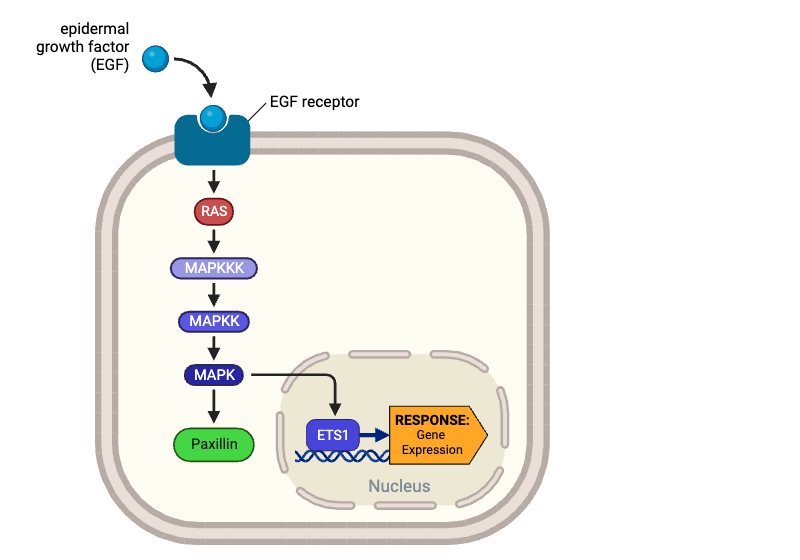
True or false? After binding a signaling molecule, an EGF receptor can activate RAS.
True
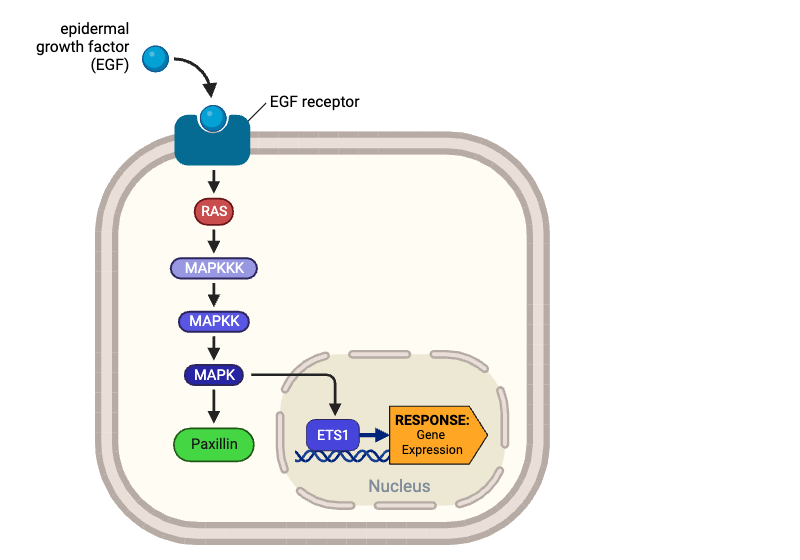
True or false? Once activated, RAS can directly activate MAPKKK.
True
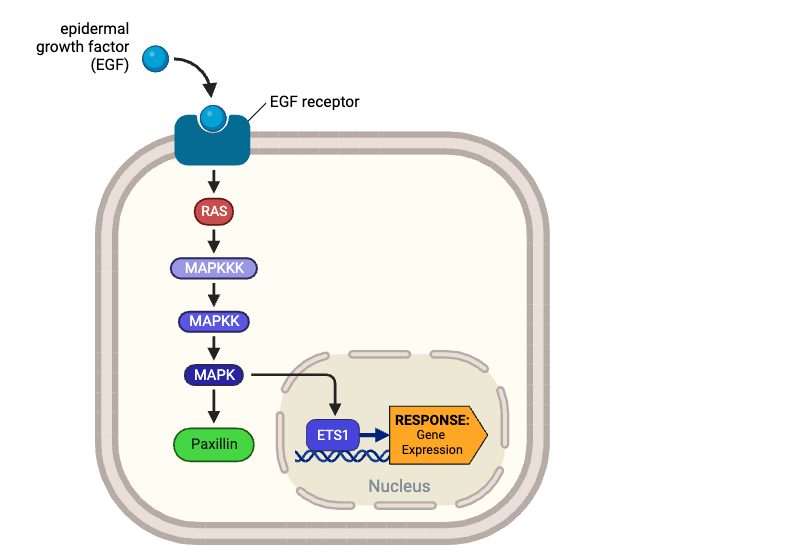
True or false? MAPKKK indirectly inhibits the activity of MAPKK.
False
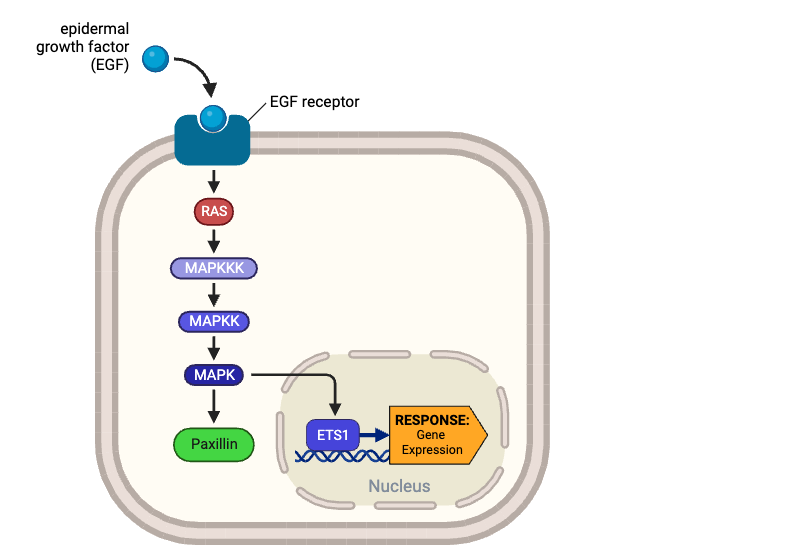
True or false? Once activated, MAPKK can directly activate MAPK.
True
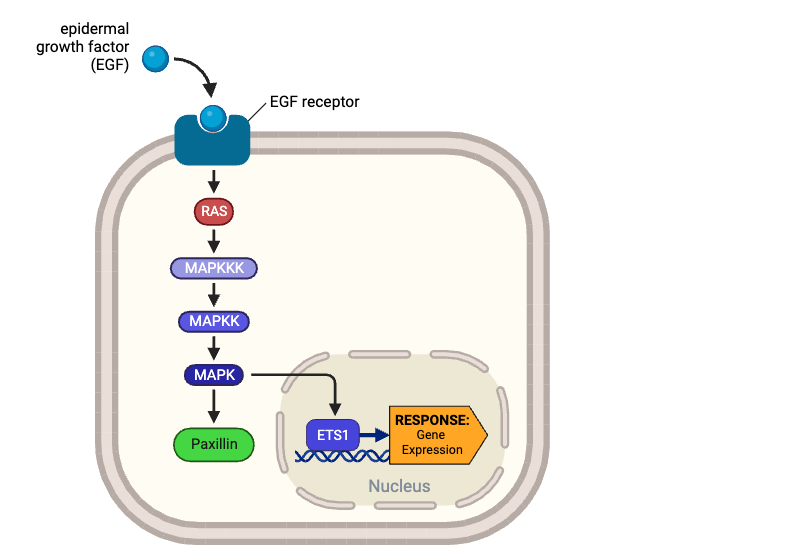
True or false? Once activated, MAPK enters the nucleus and inhibits the activity of ETS1.
False
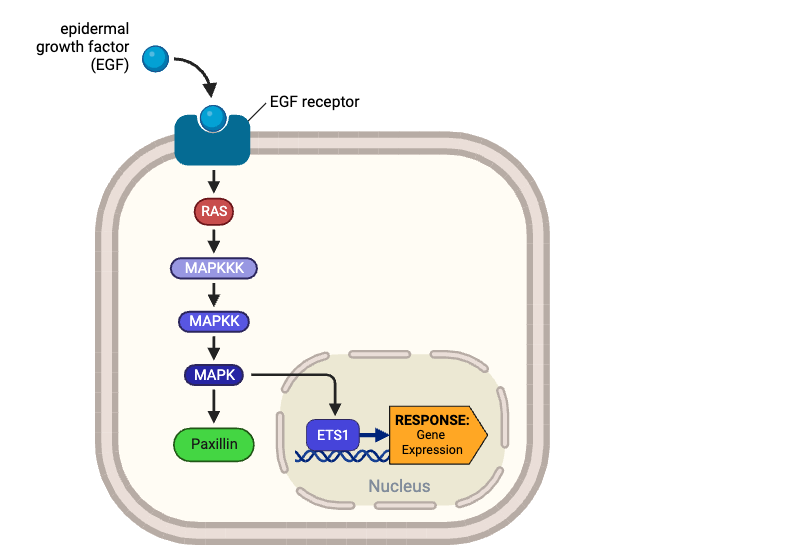
True or false? Once activated, MAPK can directly activate paxillin.
True
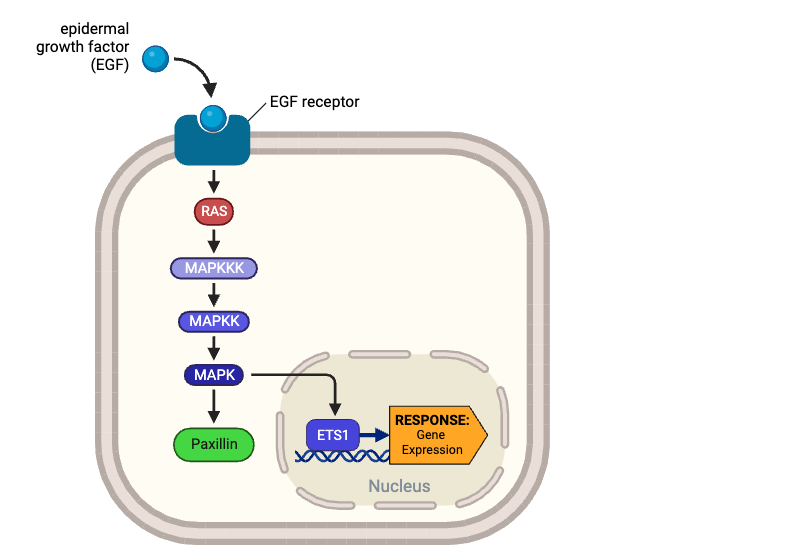
True or false? Once activated, MAPK can directly activate MAPKK.
False
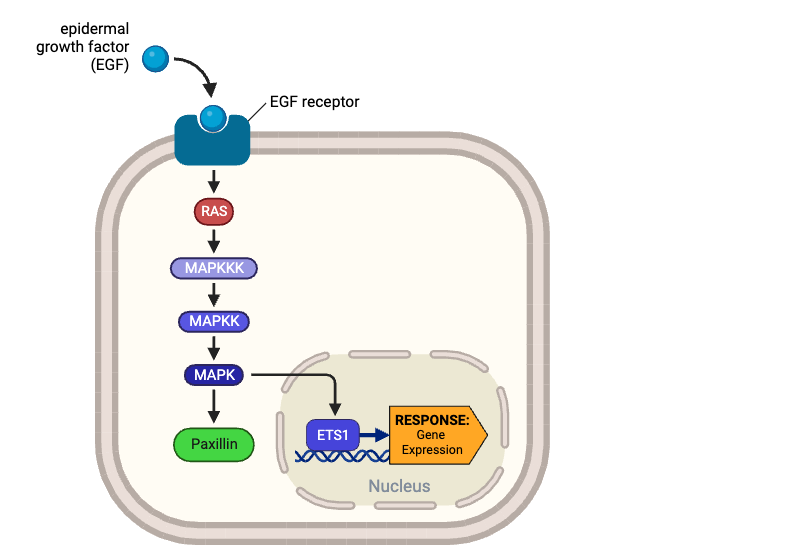
True or false? Once activated, ETS1 can affect gene expression.
True
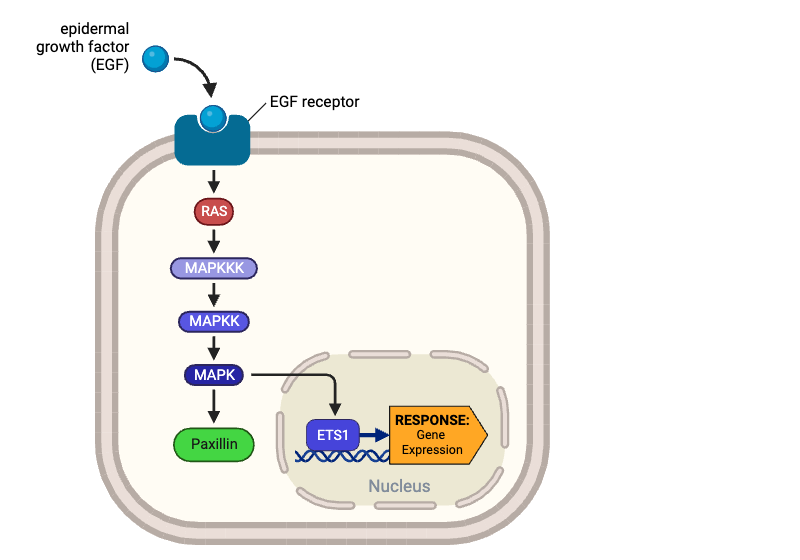
True or false? Every kinase in this signaling pathway can amplify the signal initiated by EGF.
True
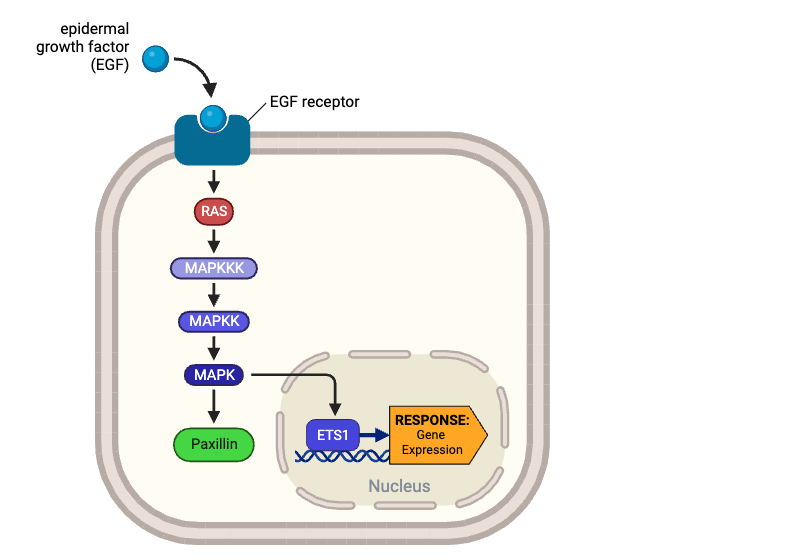
Which protein directly activates MAPKKK?
a. EGF receptor
b. RAS
c. MAPKK
d. MAPK
e. paxillin
f. ETS1
b. RAS
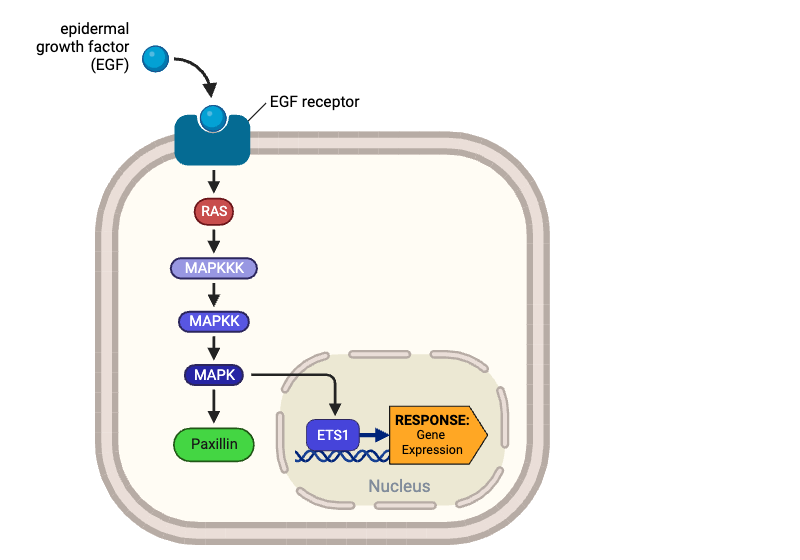
Which molecules indirectly activate MAPKKK? Select all that apply.
a. EGF receptor
b. RAS
c. MAPKK
d. MAPK
e. paxillin
f. ETS1
a. EGF receptor
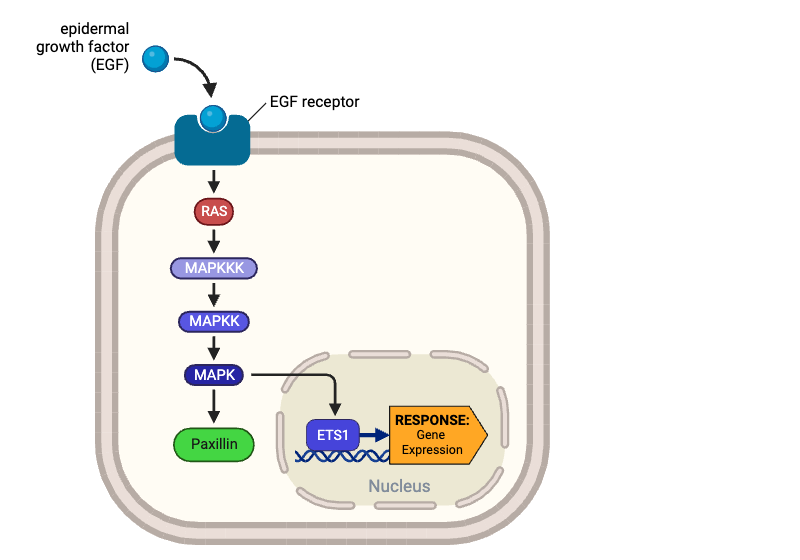
Which molecule directly activates MAPK?
a. EGF receptor
b. RAS
c. MAPKKK
d. MAPKK
e. paxillin
f. ETS1
d. MAPKK
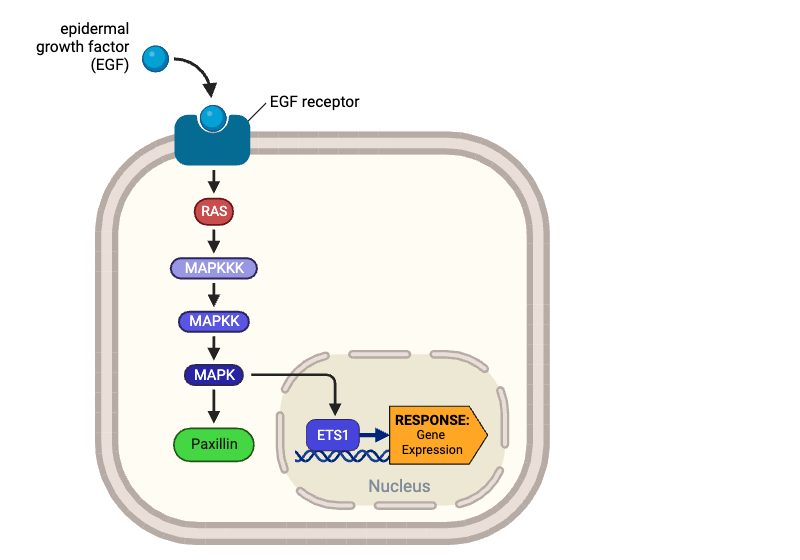
Which molecules indirectly activate MAPK? Select all that apply.
a. EGF receptor
b. RAS
c. MAPKKK
d. MAPKK
e. paxillin
f. ETS1
a. EGF receptor
b. RAS
c. MAPKKK
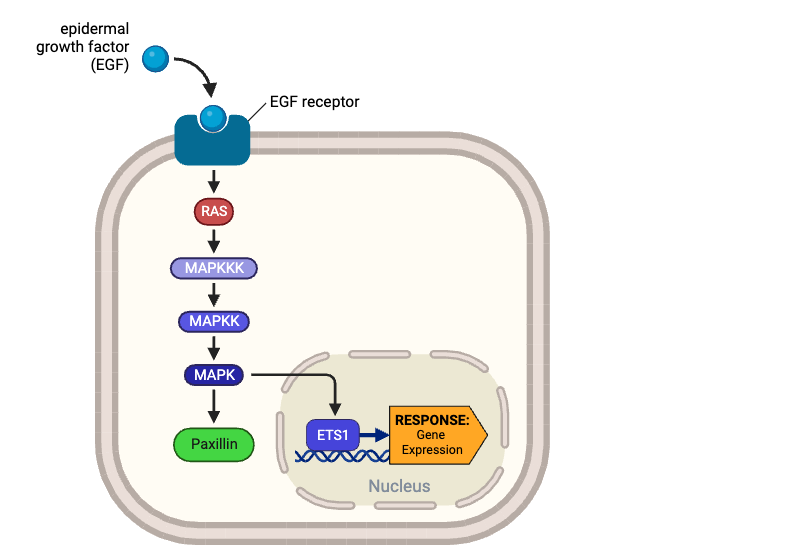
Which molecules indirectly activates paxillin? Select all that apply.
a. EGF receptor
b. RAS
c. MAPKKK
d. MAPKK
e. MAPK
f. ETS1
a. EGF receptor
b. RAS
c. MAPKKK
d. MAPKK
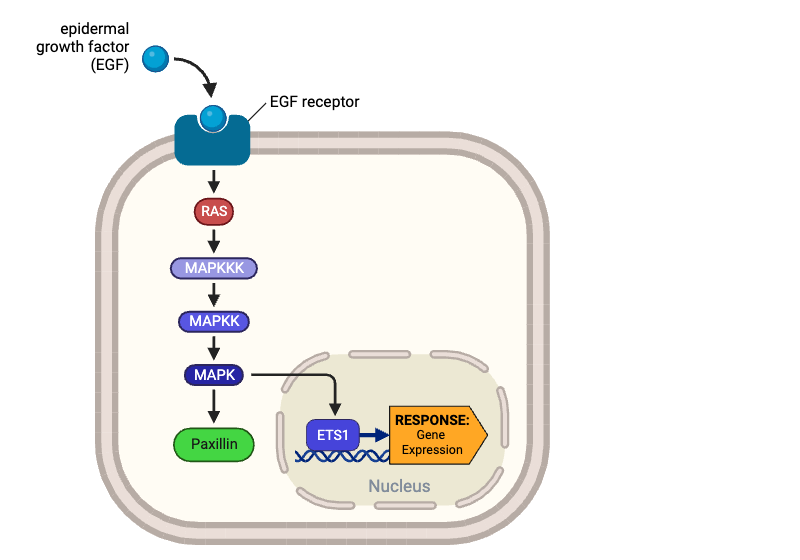
Which molecule directly activates ETS1?
a. EGF receptor
b. RAS
c. MAPKKK
d. MAPKK
e. MAPK
f. paxillin
e. MAPK
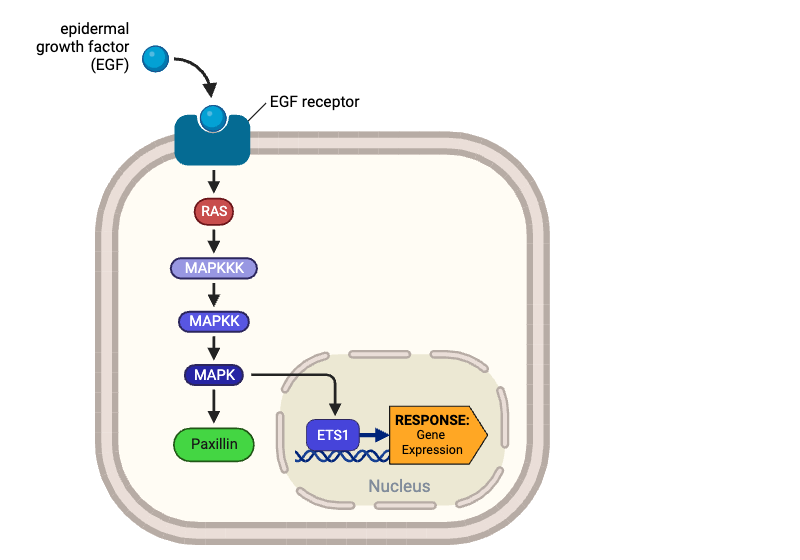
Which molecules are indirectly activated by the EGF receptor? Select all that apply.
a. RAS
b. MAPKKK
c. MAPKK
d. MAPK
e. ETS1
b. MAPKKK
c. MAPKK
d. MAPK
e. ETS1
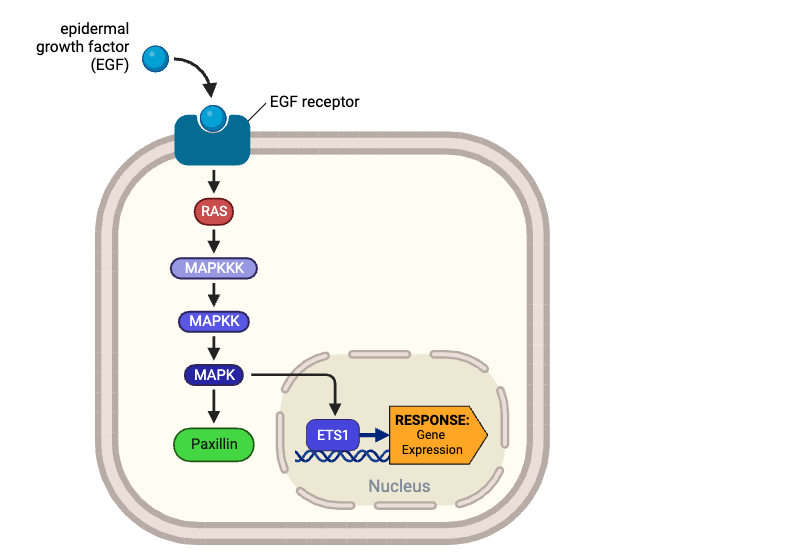
Which molecule can directly affect gene expression?
a. EGF receptor
b. RAS
c. MAPKKK
d. MAPKK
e. MAPK
f. paxillin
g. ETS1
e. MAPK
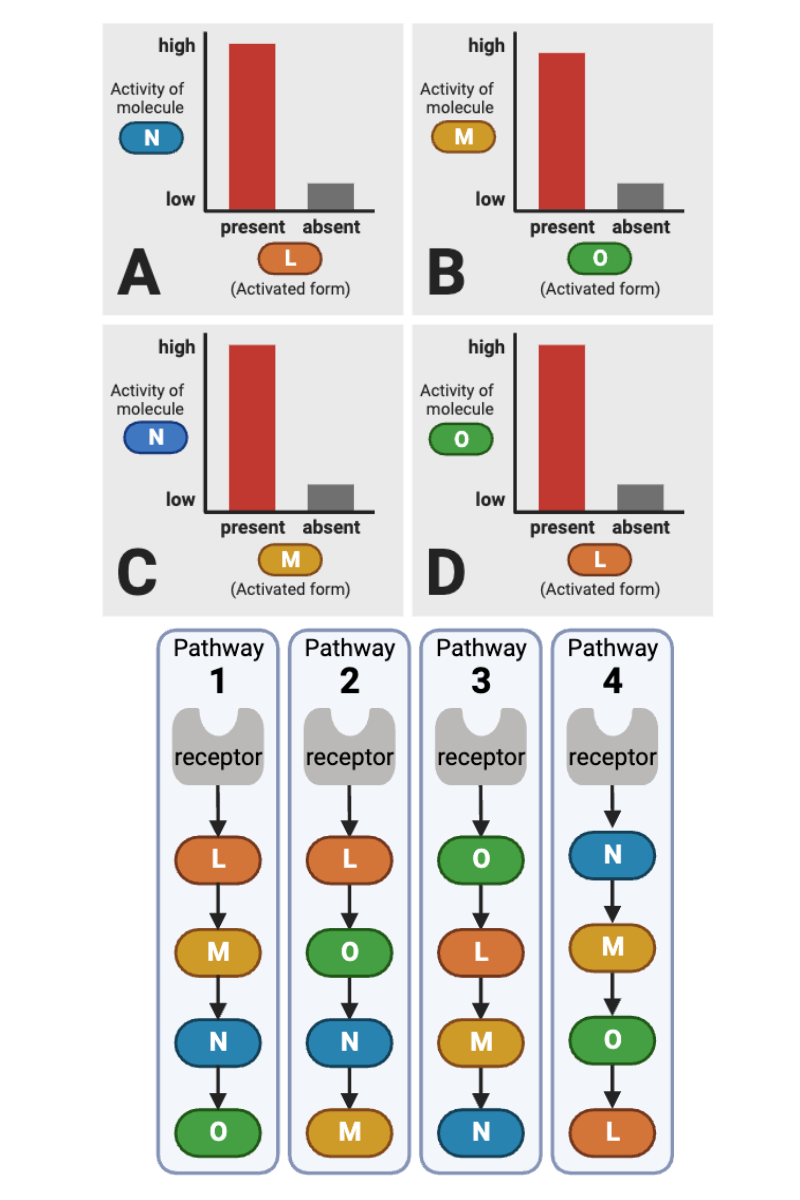
Which signaling pathways in the bottom figure (1 through 4) are consistent with the data in Plot A (top left plot) of the top figure? Select all that apply.
a. Pathway 1 (Receptor → L → M → N → O)
b. Pathway 2 (Receptor → L → O → N → M)
c. Pathway 3 (Receptor → O → L → M → N)
d. Pathway 4 (Receptor → N → M → O → L)
a. Pathway 1 (Receptor → L → M → N → O)
b. Pathway 2 (Receptor → L → O → N → M)
c. Pathway 3 (Receptor → O → L → M → N)
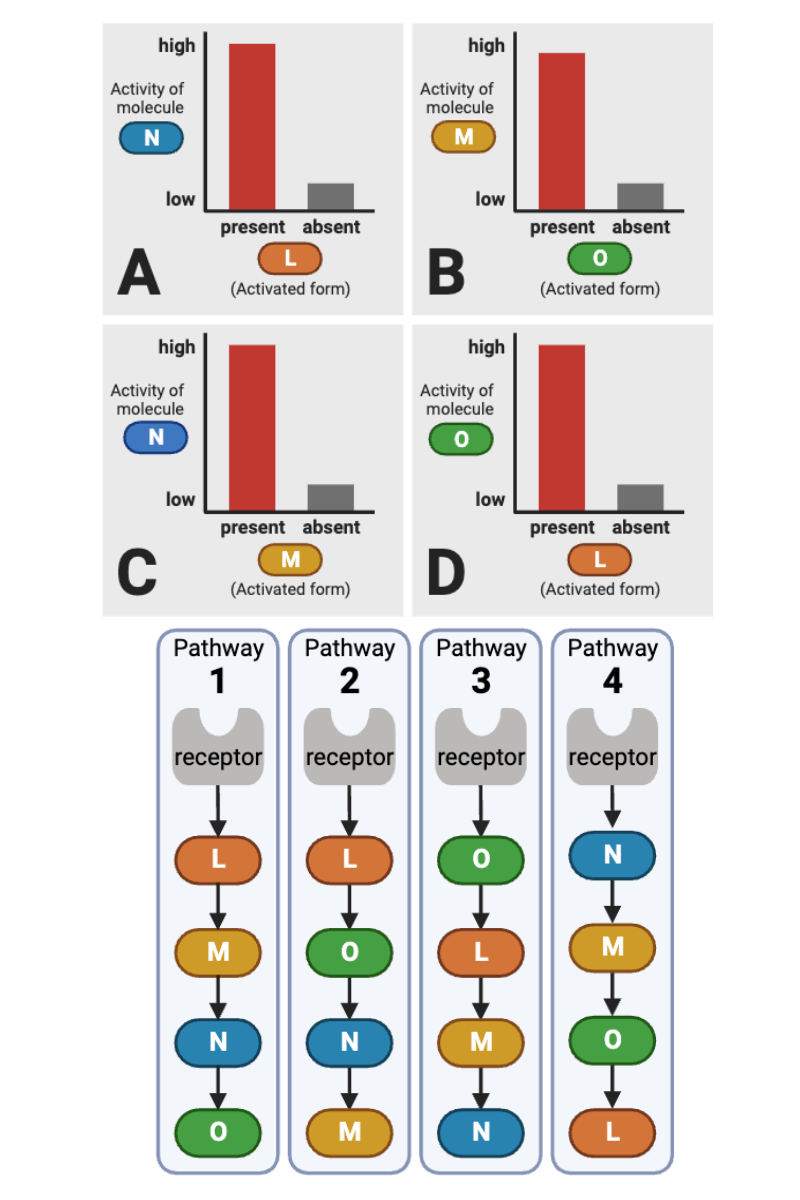
Which signaling pathways in the bottom figure (1 through 4) are consistent with the data in Plot B (top right plot) of the top figure? Select all that apply.
a. Pathway 1 (Receptor → L → M → N → O)
b. Pathway 2 (Receptor → L → O → N → M)
c. Pathway 3 (Receptor → O → L → M → N)
d. Pathway 4 (Receptor → N → M → O → L)
b. Pathway 2 (Receptor → L → O → N → M)
c. Pathway 3 (Receptor → O → L → M → N)
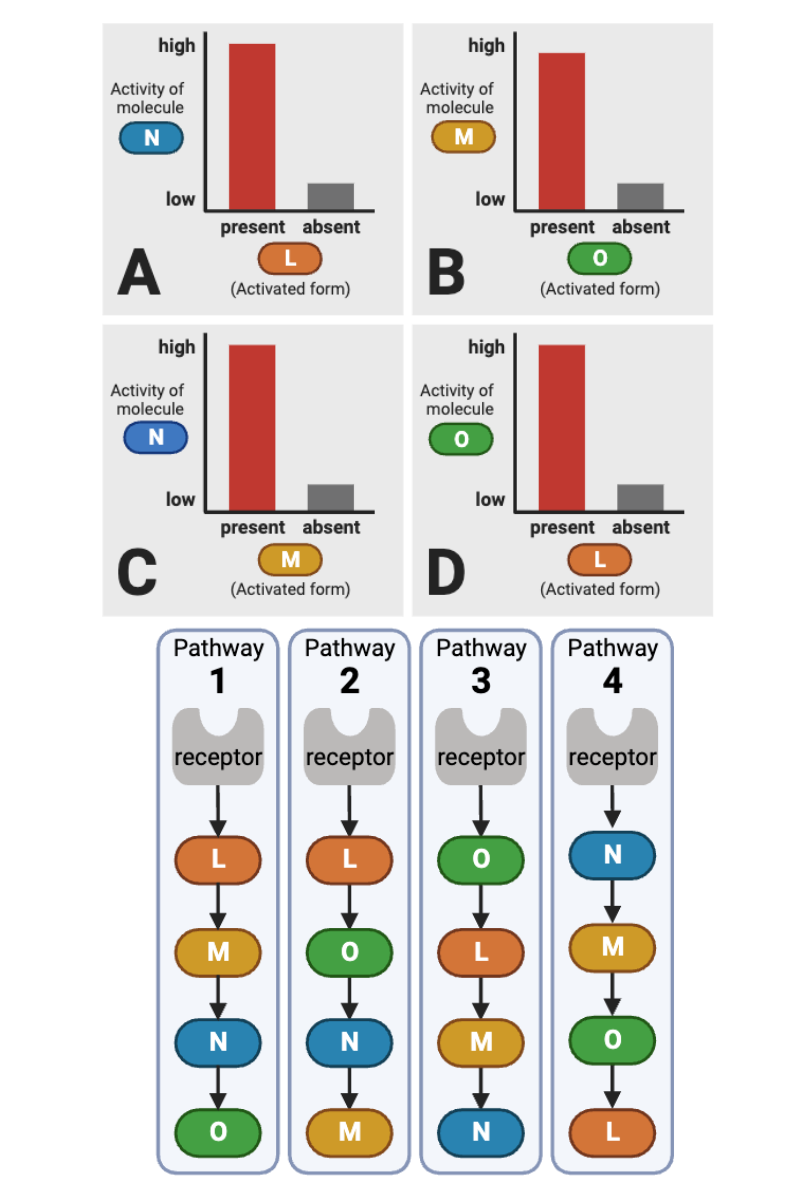
Which signaling pathways in the bottom figure (1 through 4) are consistent with the data in Plot C (bottom left plot) of the top figure? Select all that apply.
a. Pathway 1 (Receptor → L → M → N → O)
b. Pathway 2 (Receptor → L → O → N → M)
c. Pathway 3 (Receptor → O → L → M → N)
d. Pathway 4 (Receptor → N → M → O → L)
a. Pathway 1 (Receptor → L → M → N → O)
c. Pathway 3 (Receptor → O → L → M → N)
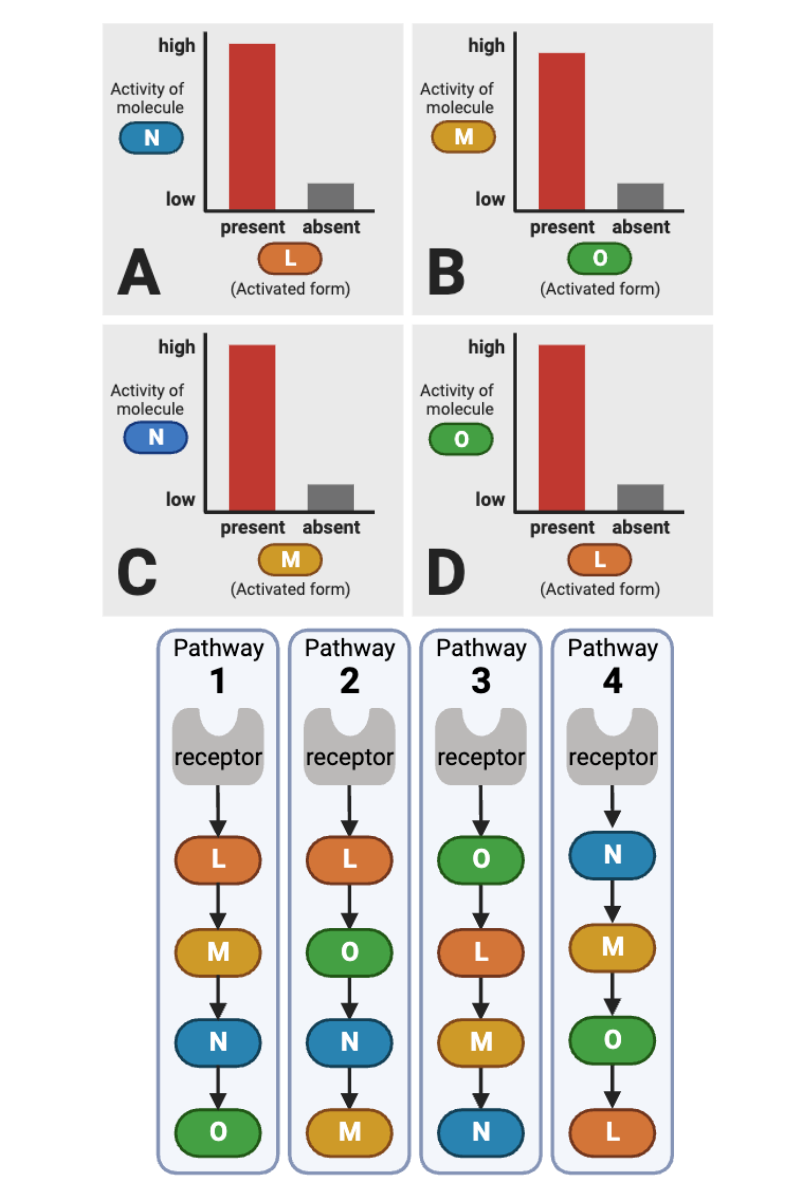
Which signaling pathways in the bottom figure (1 through 4) are consistent with the data in Plot D (bottom right plot) of the top figure? Select all that apply.
a. Pathway 1 (Receptor → L → M → N → O)
b. Pathway 2 (Receptor → L → O → N → M)
c. Pathway 3 (Receptor → O → L → M → N)
d. Pathway 4 (Receptor → N → M → O → L)
a. Pathway 1 (Receptor → L → M → N → O)
b. Pathway 2 (Receptor → L → O → N → M)
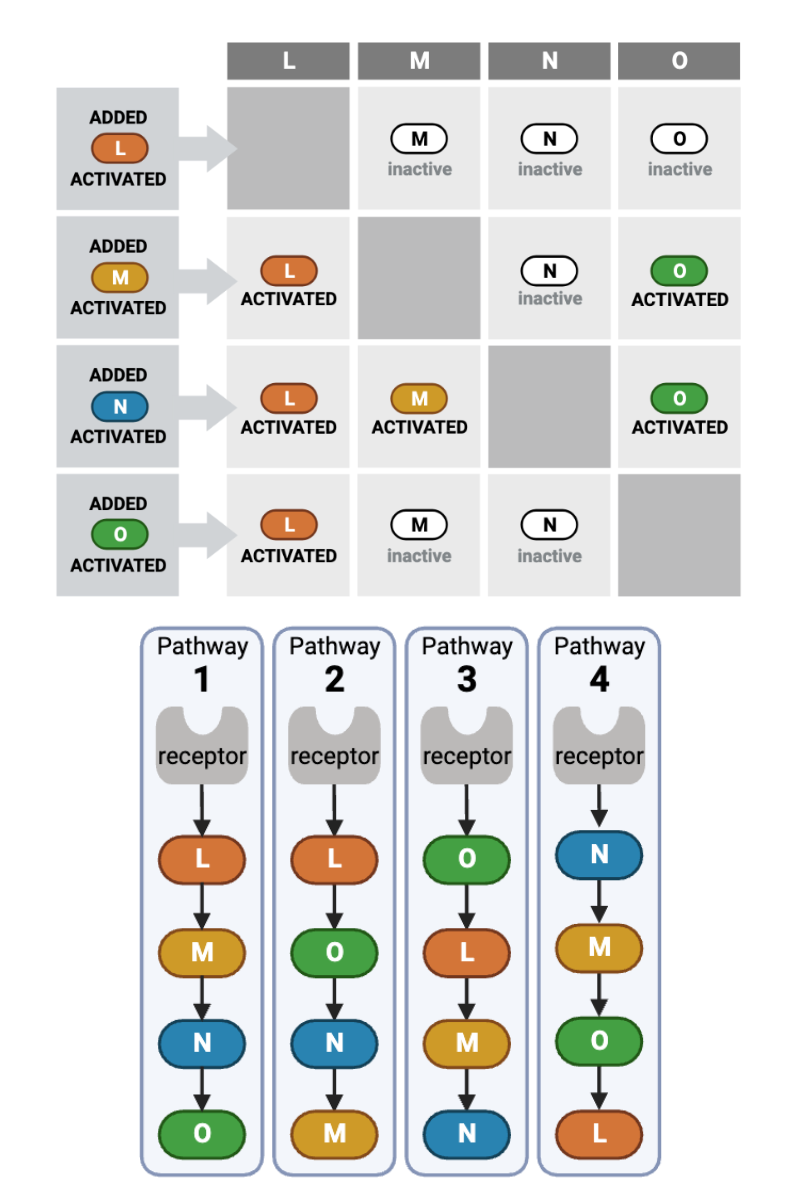
Which signaling pathway (1 through 4) in the bottom figure is consistent with the data in the top figure?
a. Pathway 1 (Receptor → L → M → N → O)
b. Pathway 2 (Receptor → L → O → N → M)
c. Pathway 3 (Receptor → O → L → M → N)
d. Pathway 4 (Receptor → N → M → O → L)
d. Pathway 4 (Receptor → N → M → O → L)
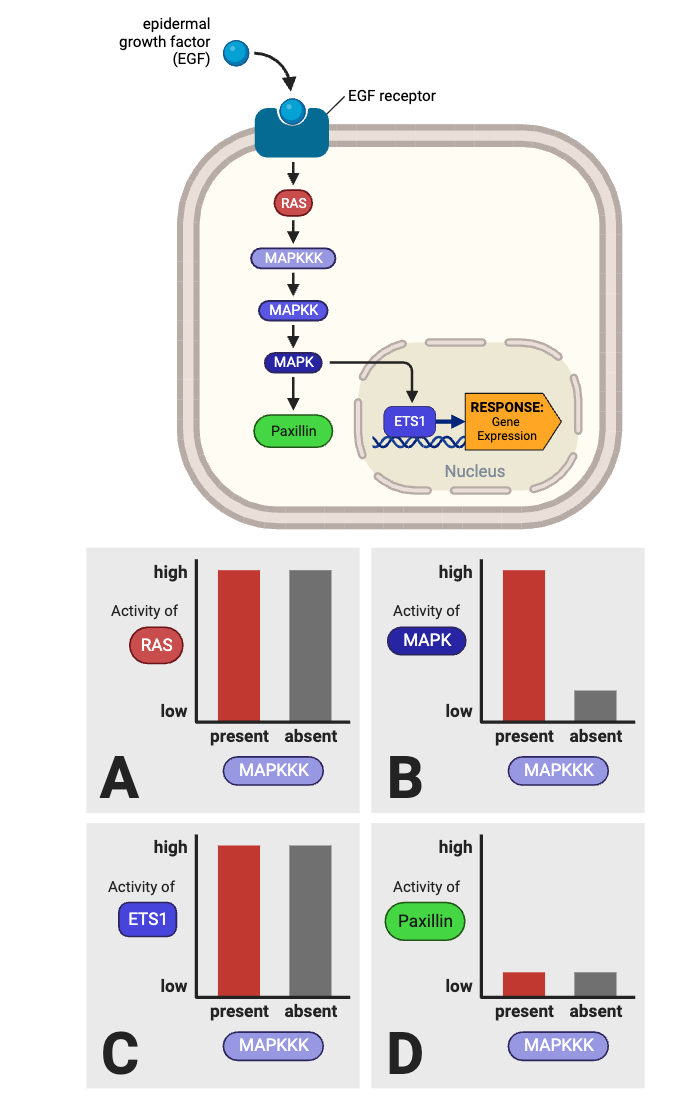
Which plots (A through D) in the bottom figure support the relationships shown in the EGF signaling pathway in the top figure? Select all that apply.
a. Plot A
b. Plot B
c. Plot C
d. Plot D
a. Plot A
b. Plot B
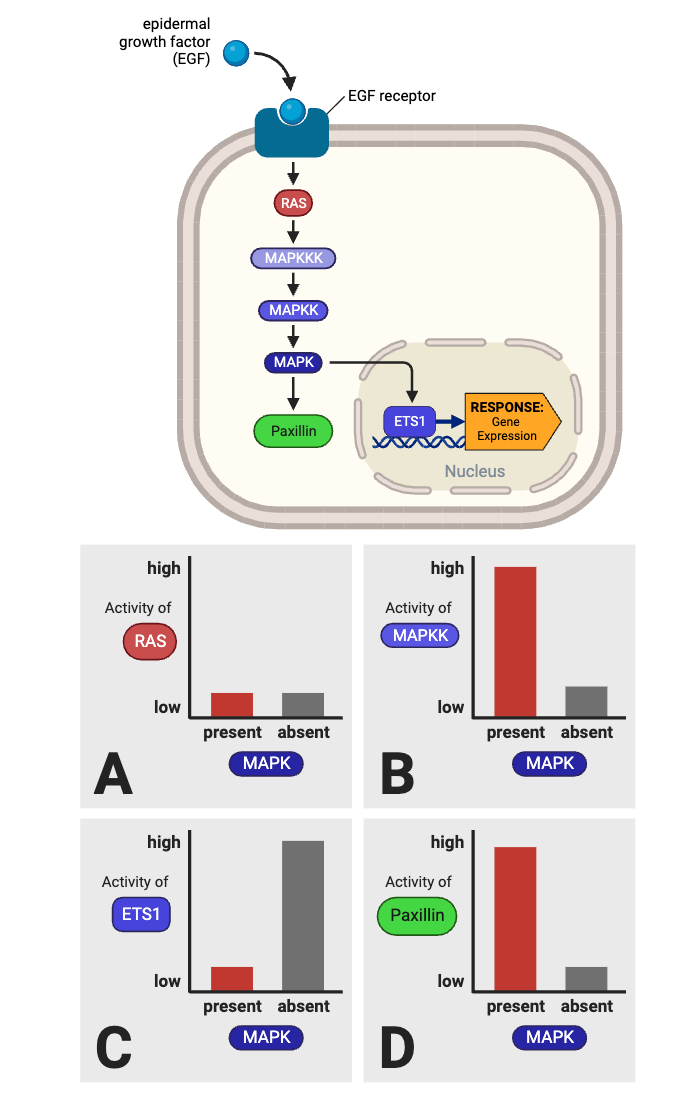
Which plots (A through D) in the bottom figure are consistent with the model of the signaling pathway in the top figure? Select all that apply.
a. Plot A
b. Plot B
c. Plot C
d. Plot D
d. Plot D
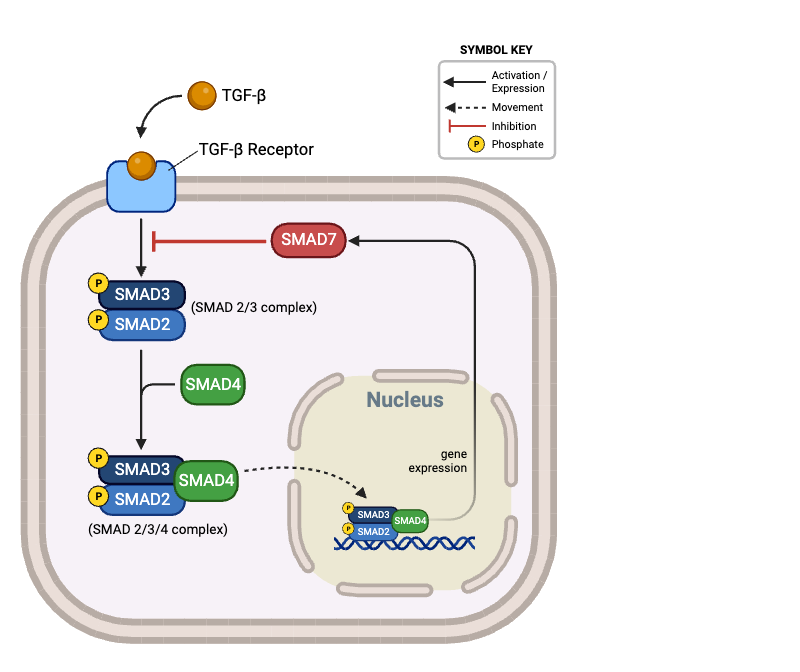
Which proteins directly terminate this signaling pathway by inhibiting TGF-𝛃 receptor? Select all that apply.
a. TGF-𝛃r
b. SMAD2
c. SMAD3
d. SMAD4
e. SMAD7
e. SMAD7
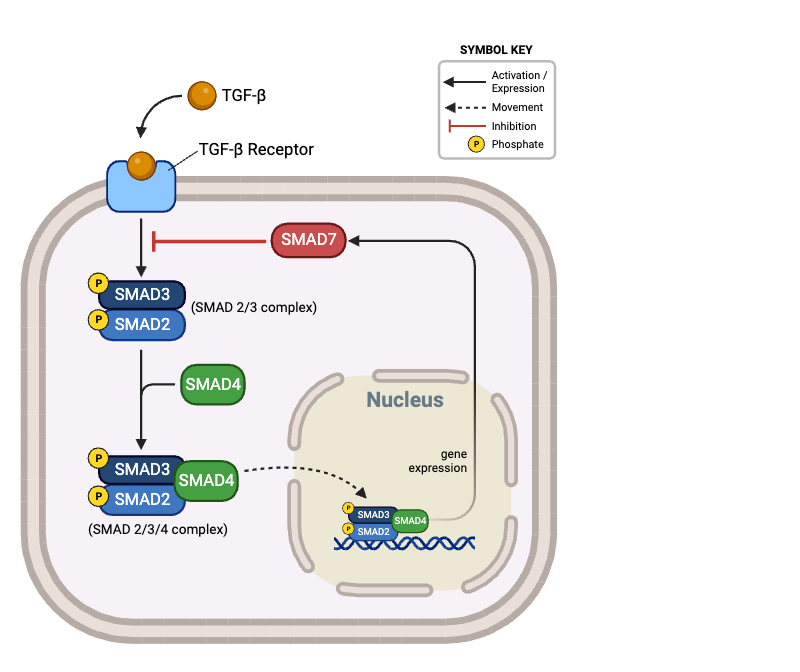
Which processes directly reduces the activity of proteins in this signaling pathway? Select all that apply.
a. phosphorylation of SMAD2 and SMAD3 by a TGF-𝛃 receptor
b. dephosphorylation of SMAD2 and SMAD3 by a TGF-𝛃 receptor
c. activation of a TGF-𝛃 receptor by SMAD7
d. inhibition of a TGF-𝛃 receptor by SMAD7
d. inhibition of a TGF-𝛃 receptor by SMAD7
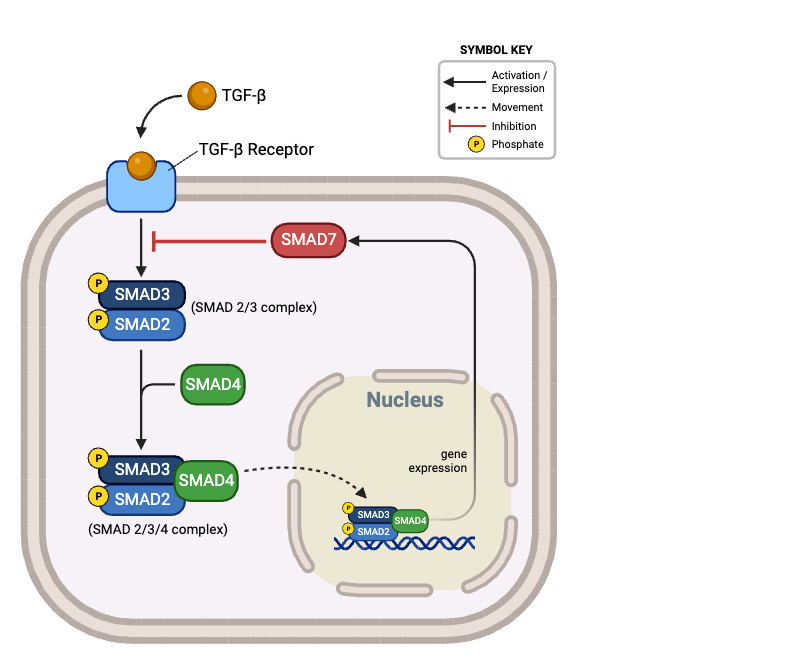
True or false? When a signaling molecule activates a TGF-𝛃 receptor, SMAD7 immediately inhibits the activity of the TGF-𝛃 receptor.
a. true
b. false
False
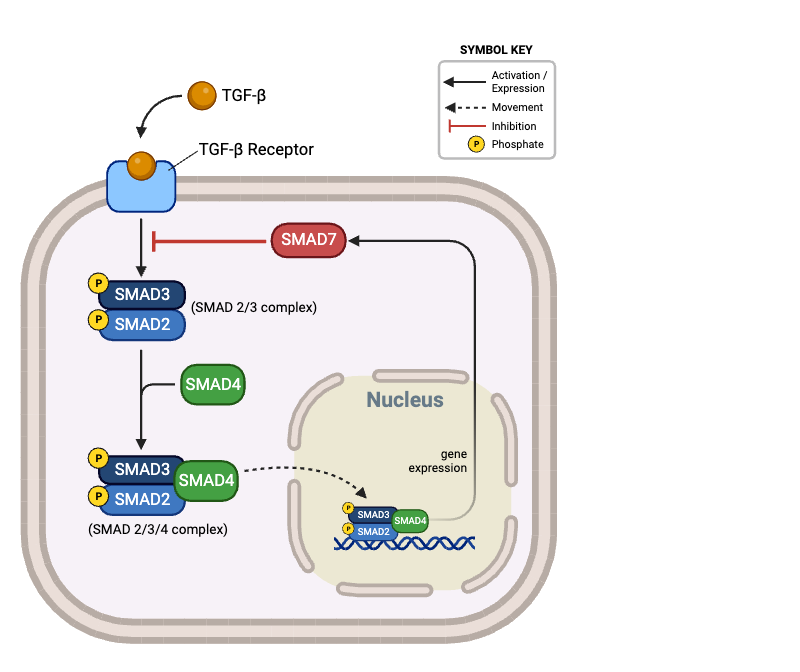
True or false? SMAD7 indirectly decreases the abundance of phosphorylated SMAD2 by inhibiting the activity of a TGF-𝛃 receptor.
a. true
b. false
True
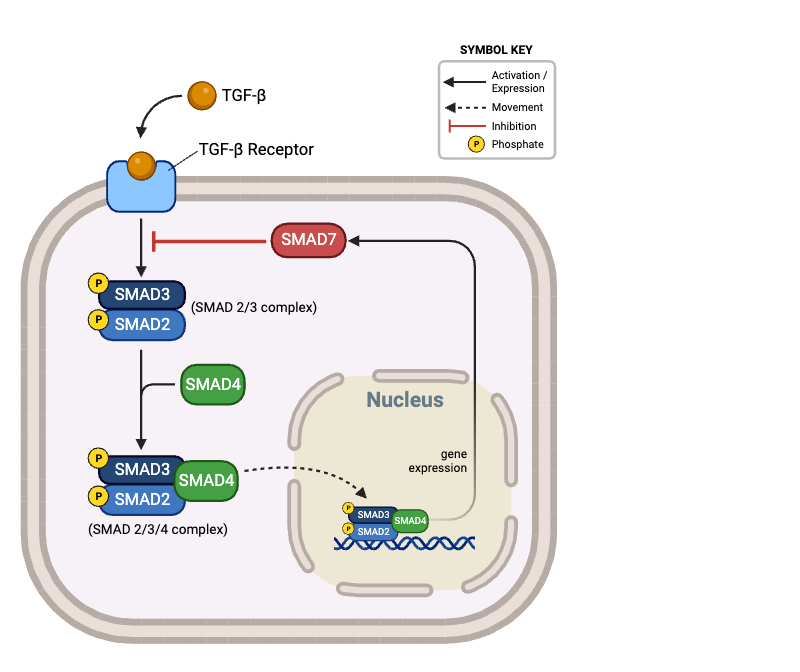
True or false? Inhibition of gene expression would completely eliminate negative feedback in this signaling pathway.
a. true
b. false
True
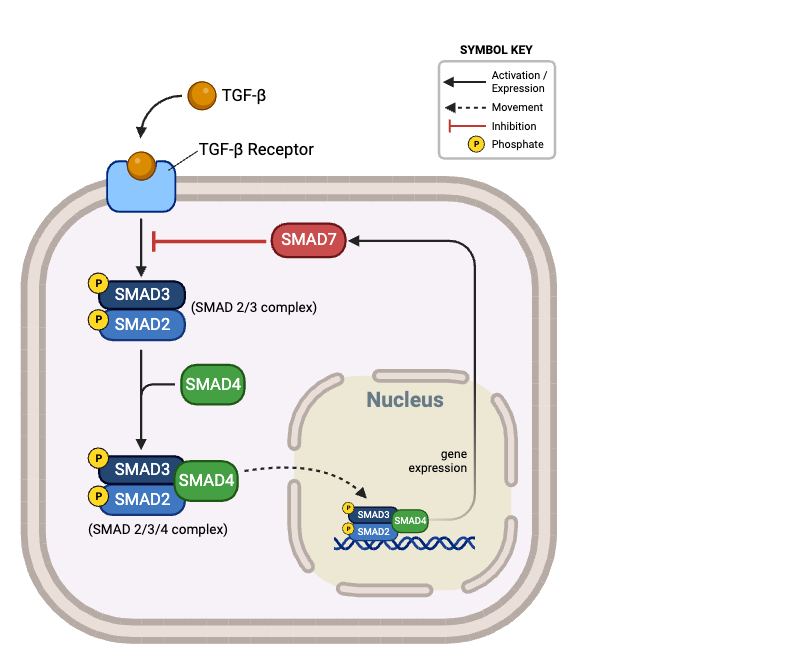
True or false? Inhibition of SMAD7 would increase the abundance of phosphorylated SMAD3 in the presence of TGF-𝛃.
a. true
b. false
True
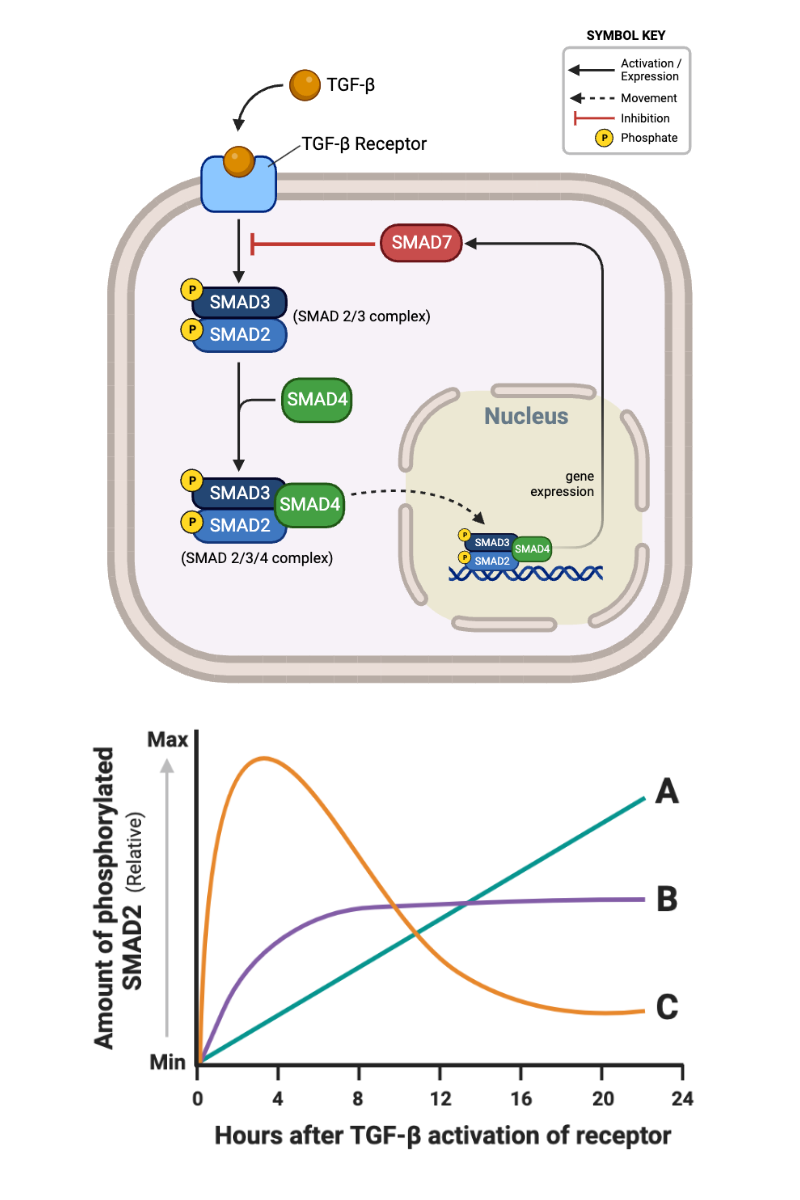
Which relationship describes the effect of negative feedback on the phosphorylation of SMAD2?
a. Relationship A
b. Relationship B
c. Relationship C
c. Relationship C
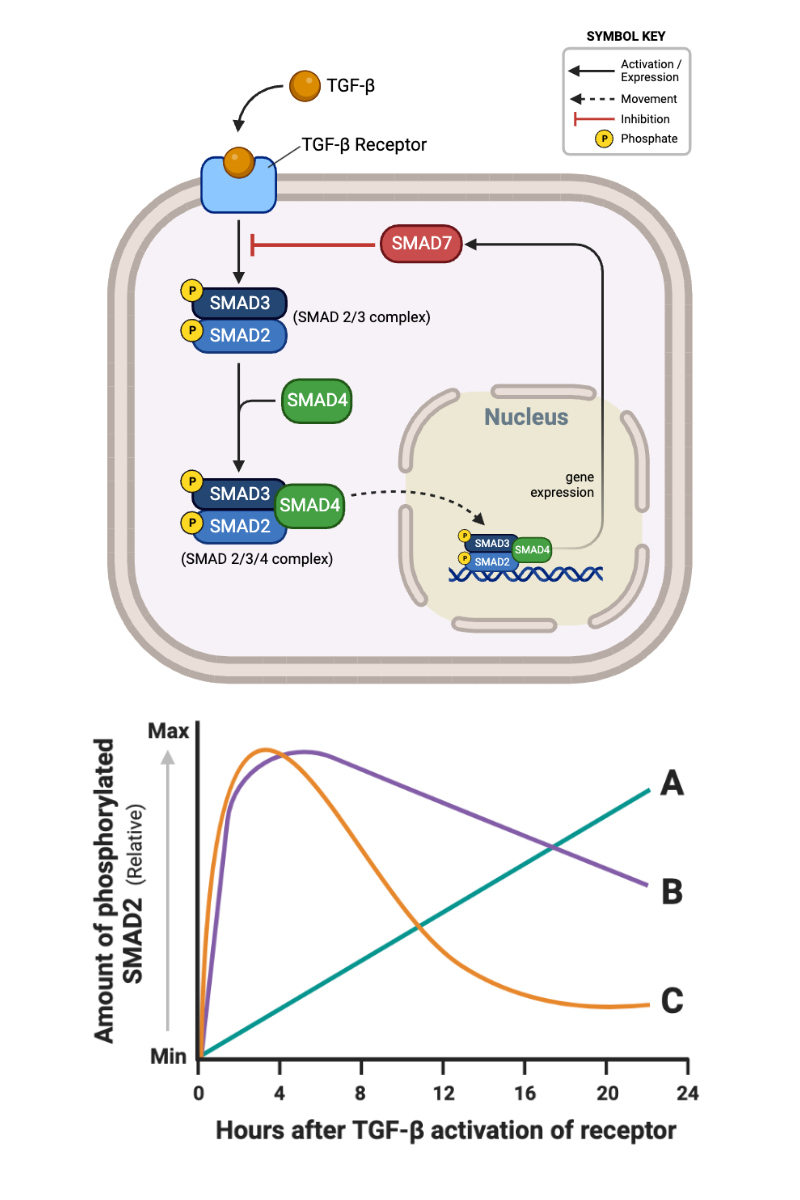
Which relationship would describe the phosphorylation of SMAD2 if gene expression were partially inhibited by a drug?
a. Relationship A
b. Relationship B
c. Relationship C
b. Relationship B
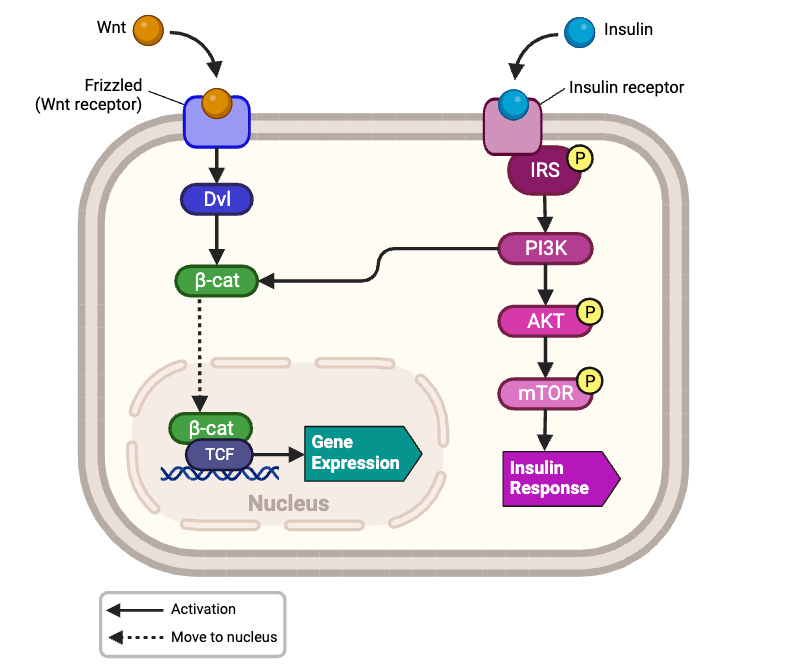
Which cellular responses should occur in the presence of Wnt and the absence of insulin? Select all that apply.
a. activation of Dvl
b. inhibition of Dvl
c. activation of β-cat
d. inhibition of β-cat
e. β-cat binds to TCF)
f. activation of IRS
g. inhibition of IRS
h. activation of PI3K
i. inhibition of PI3K
j. activation of AKT
k. inhibition of AKT
l. activation of mTOR
m. inhibition of mTOR
n. gene expression
a. activation of Dvl
c. activation of β-cat
e. β-cat binds to TCF)
n. gene expression
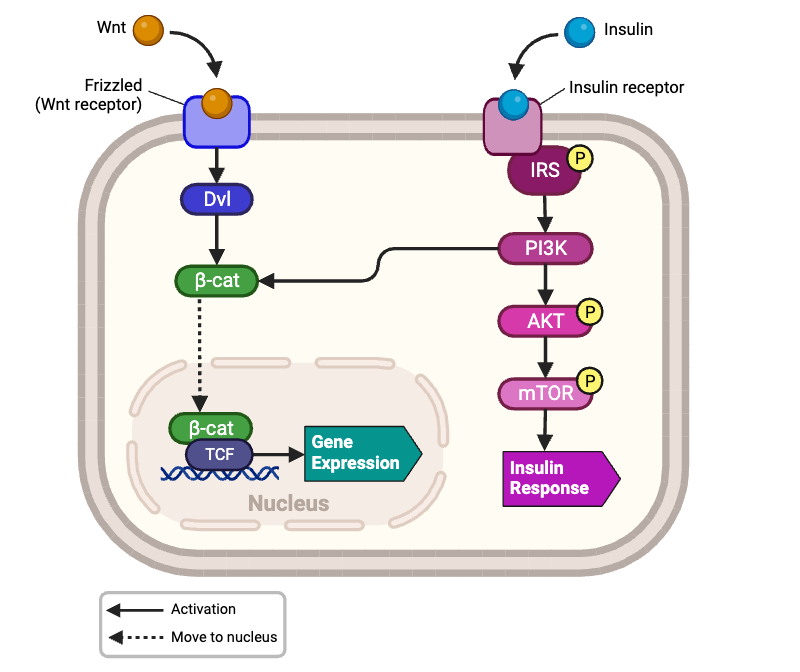
Which cellular responses should occur in the presence of insulin and absence of Wnt? Select all that apply.
a. activation of Dvl
b. inhibition of Dvl
c. activation of β-cat
d. inhibition of β-cat
e. β-cat binds to TCF
f. activation of IRS
g. inhibition of IRS
h. activation of PI3K
i. inhibition of PI3K
j. activation of AKT
k. inhibition of AKT
l. activation of mTOR
m. inhibition of mTOR
n. gene expression
c. activation of β-cat
e. β-cat binds to TCF
f. activation of IRS
h. activation of PI3K
j. activation of AKT
l. activation of mTOR
n. gene expression
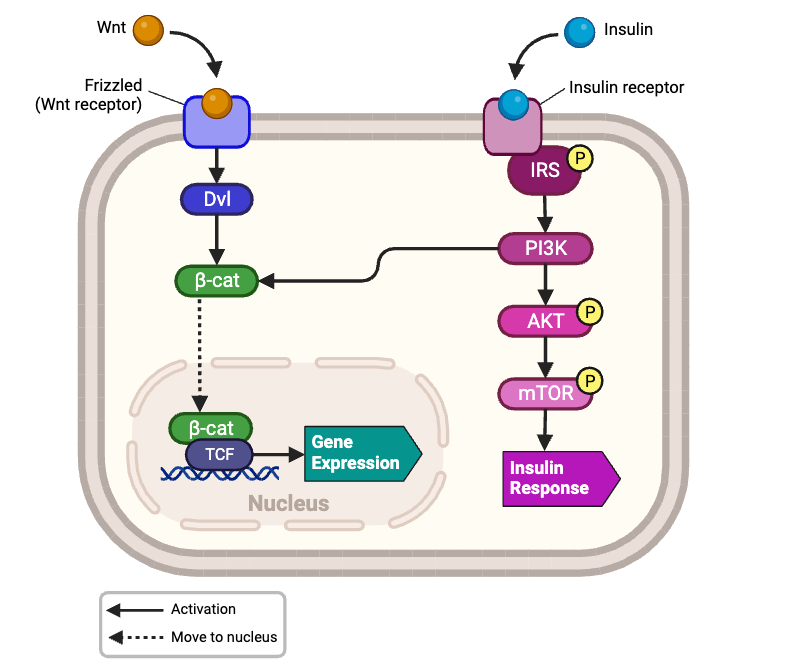
Which cellular responses should occur in the presence of both Wnt and insulin? Select all that apply.
a. activation of Dvl
b. inhibition of Dvl
c. activation of β-cat
d. inhibition of β-cat
e. β-cat binds to TCF
f. activation of IRS
g. inhibition of IRS
h. activation of PI3K
i. inhibition of PI3K
j. activation of AKT
k. inhibition of AKT
l. activation of mTOR
m. inhibition of mTOR
n. gene expression
a. activation of Dvl
c. activation of β-cat
e. β-cat binds to TCF
f. activation of IRS
h. activation of PI3K
j. activation of AKT
l. activation of mTOR
n. gene expression
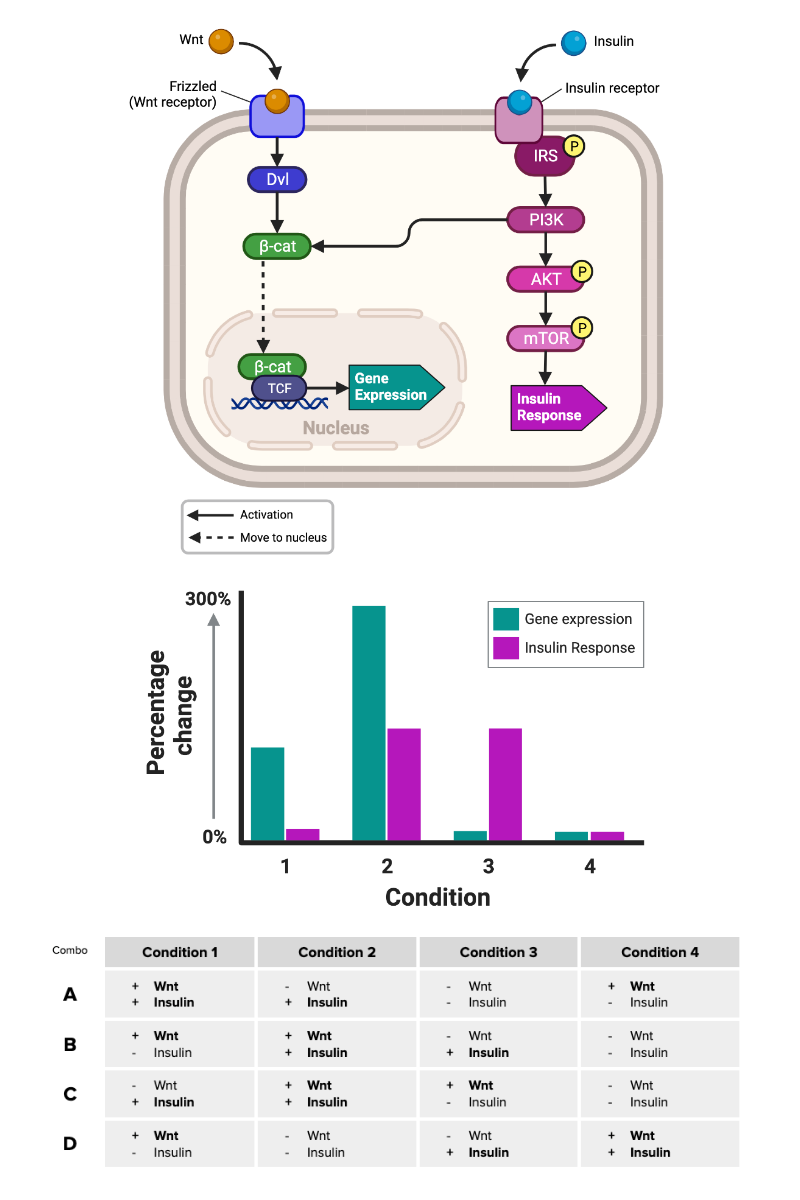
Which row of the table (A through D) contains the combination of signaling molecules needed to produce the cellular response shown in the figure?
a. Row A
b. Row B
c. Row C
d. Row D
b. Row B
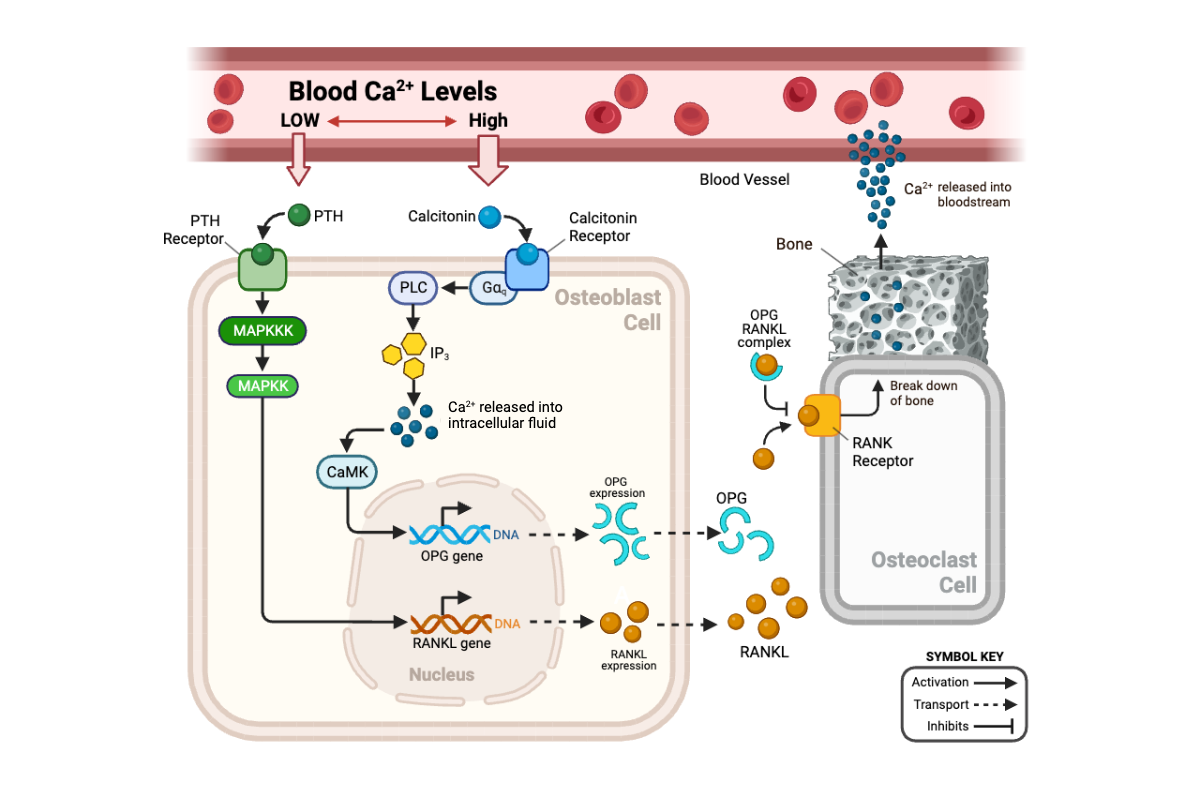
Complete the following sentence. If PTH binds to receptors in the membrane of an osteoblast, the activity of MAPK in that cell would ______.
a. increase
b. decrease
c. remain the same
a. increase
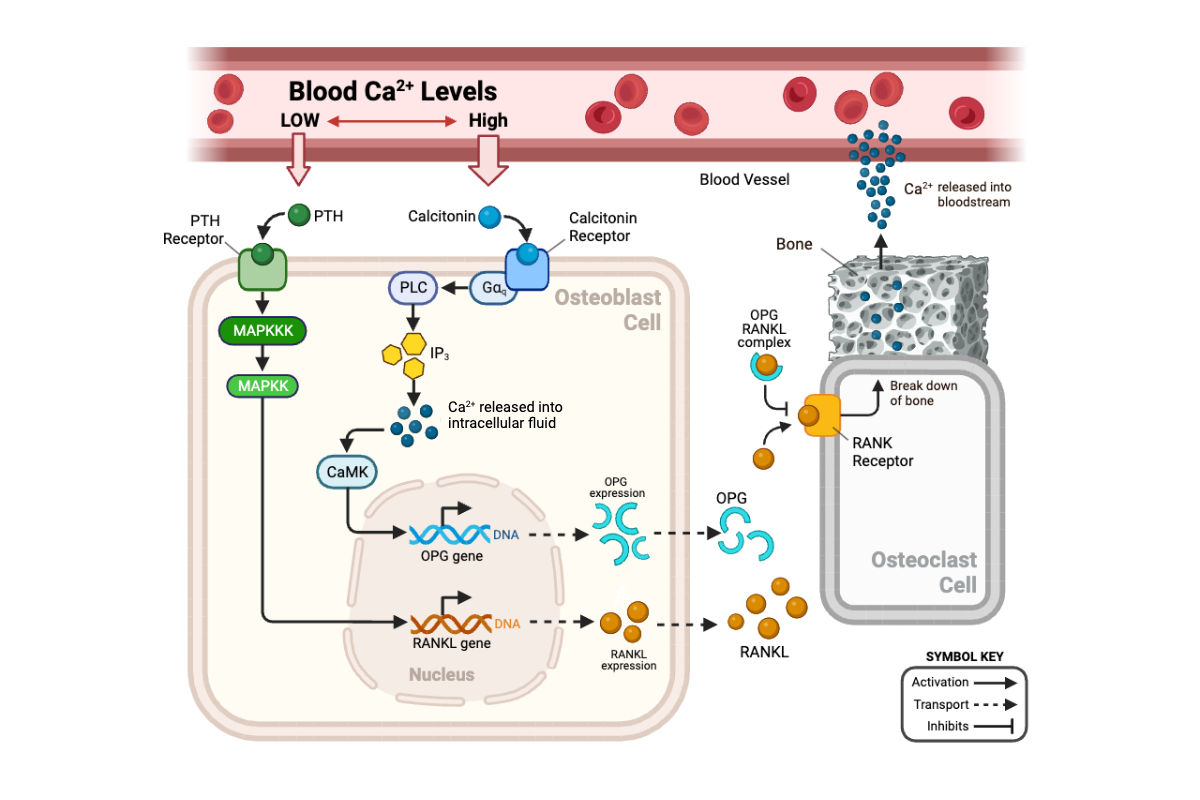
Complete the following sentence. If PTH binds to receptors in the membrane of an osteoblast, the concentration of calcium ions (Ca2+) in that cell would ______.
a. increase
b. decrease
c. remain the same
c. remain the same
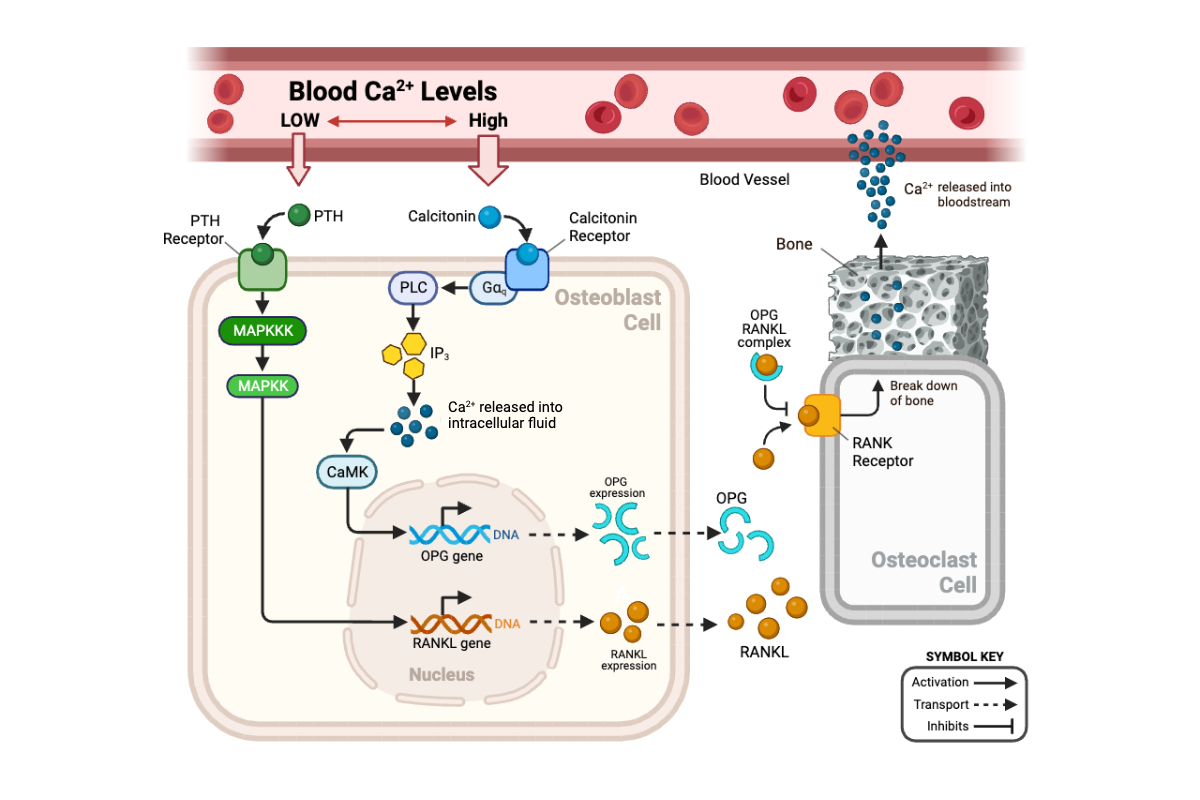
Complete the following sentence. If the activity of MAPKK in an osteoblast increases, the concentration of RANKL in that cell would ______.
a. increase
b. decrease
c. remain the same
a. increase
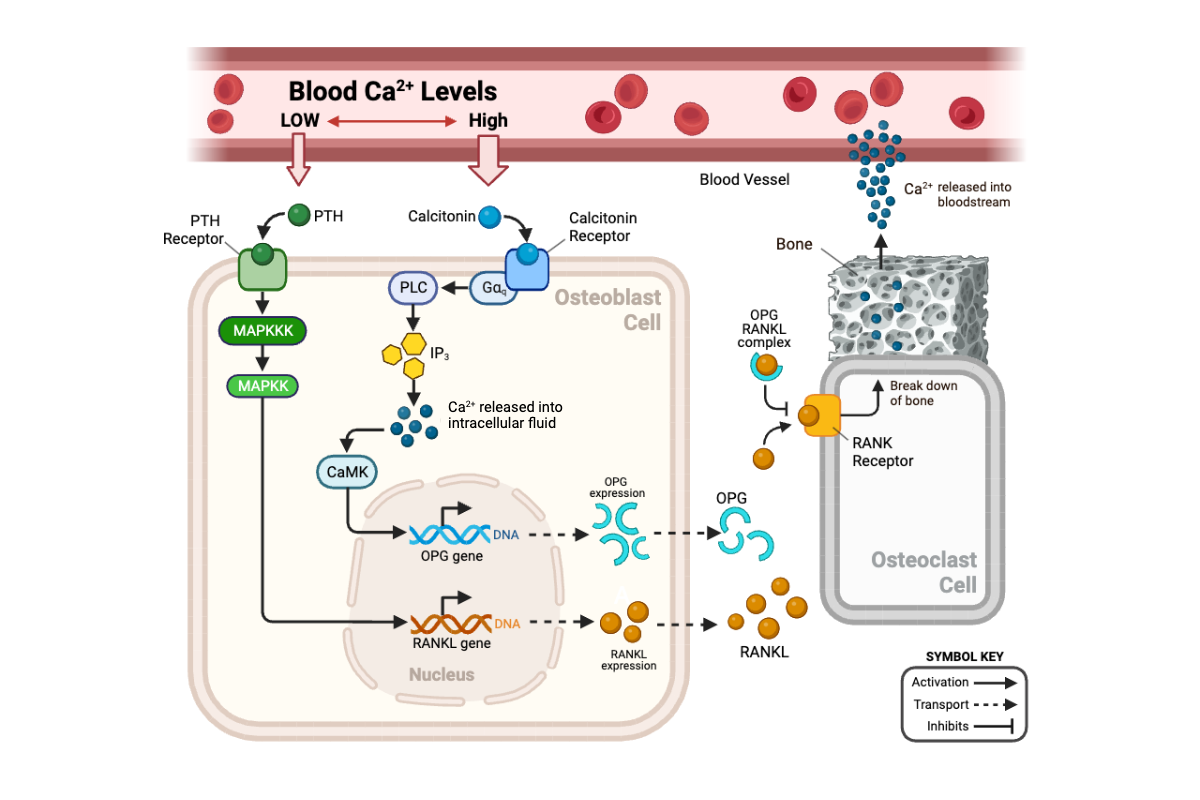
Complete the following sentence. If the concentration of RANKL in osteoblasts increases, a bone would release Ca2+ at _______.
a. a faster rate
b. a slower rate
c. the same rate
a. a faster rate
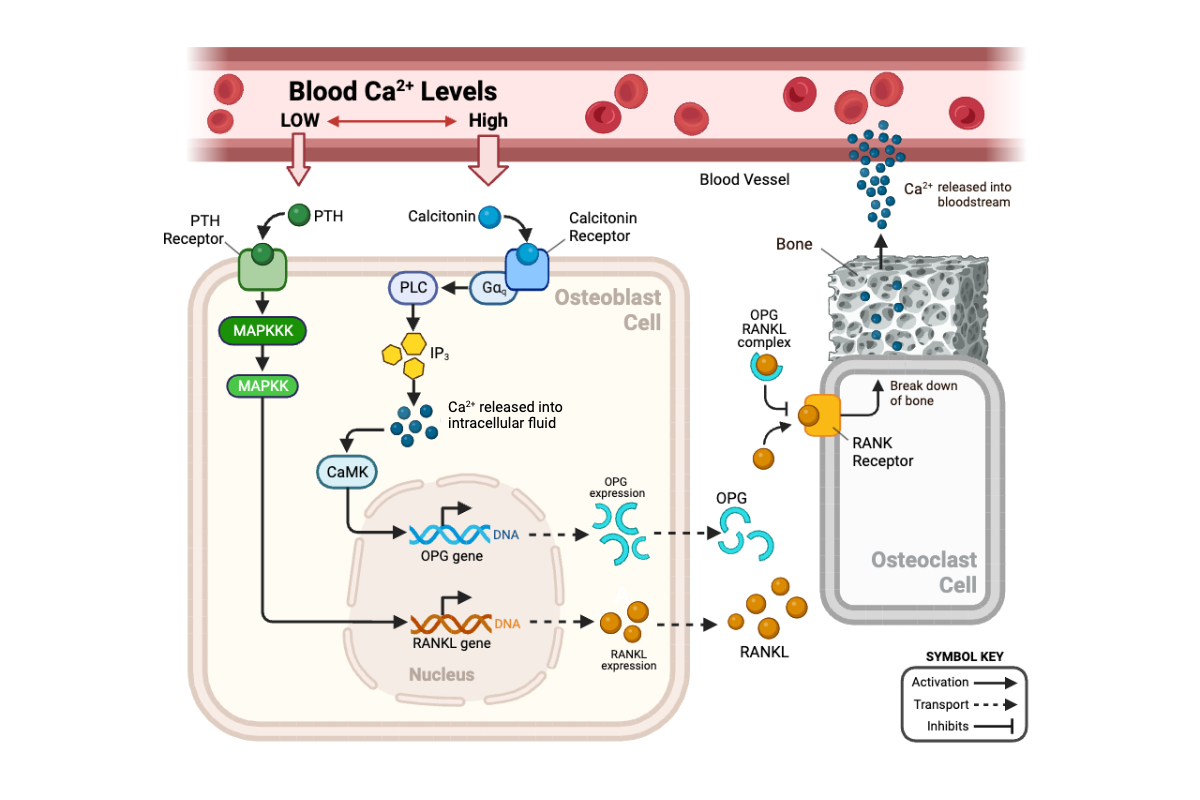
Complete the following sentence. If calcitonin binds to receptors in the membrane of an osteoblast, the activity of MAPKK in that cell would ______.
a. increase
b. decrease
c. remain the same
c. remain the same
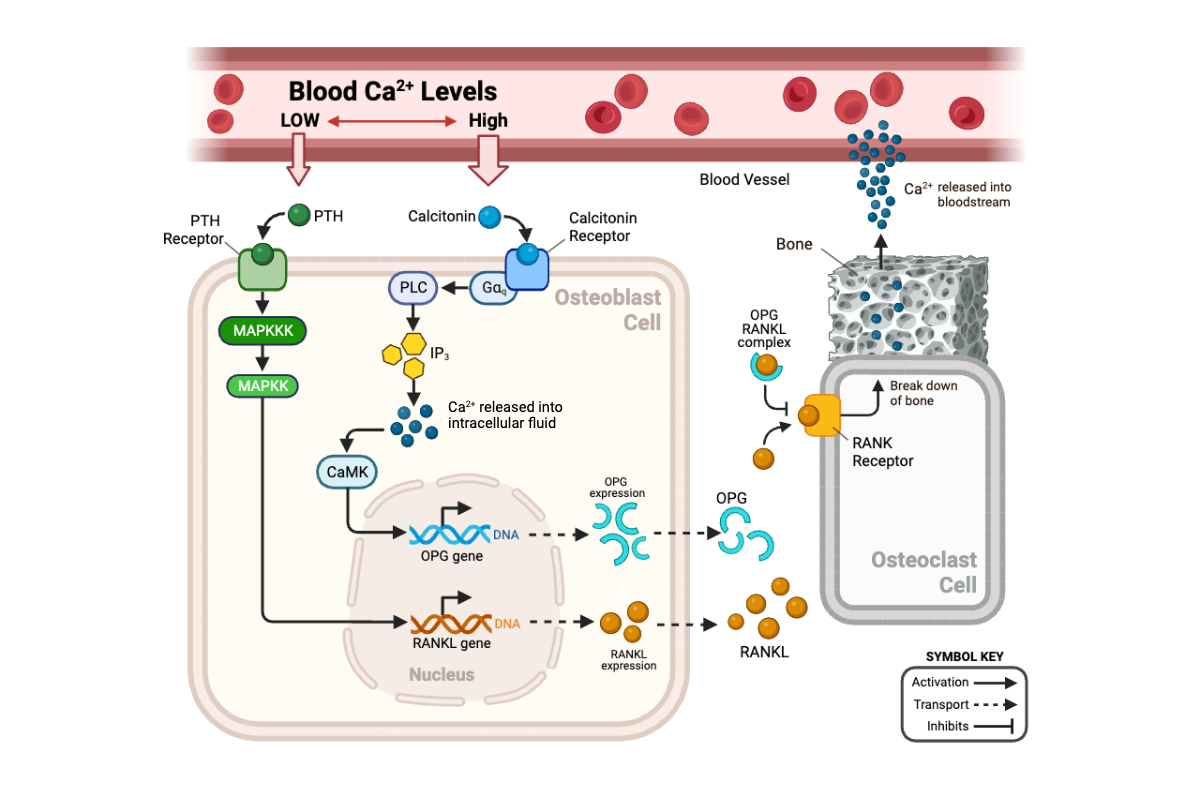
Complete the following sentence. If calcitonin binds to receptors in the membrane of an osteoblast, the concentration of Ca2+ in that cell would ______.
a. increase
b. decrease
c. remain the same
a. increase
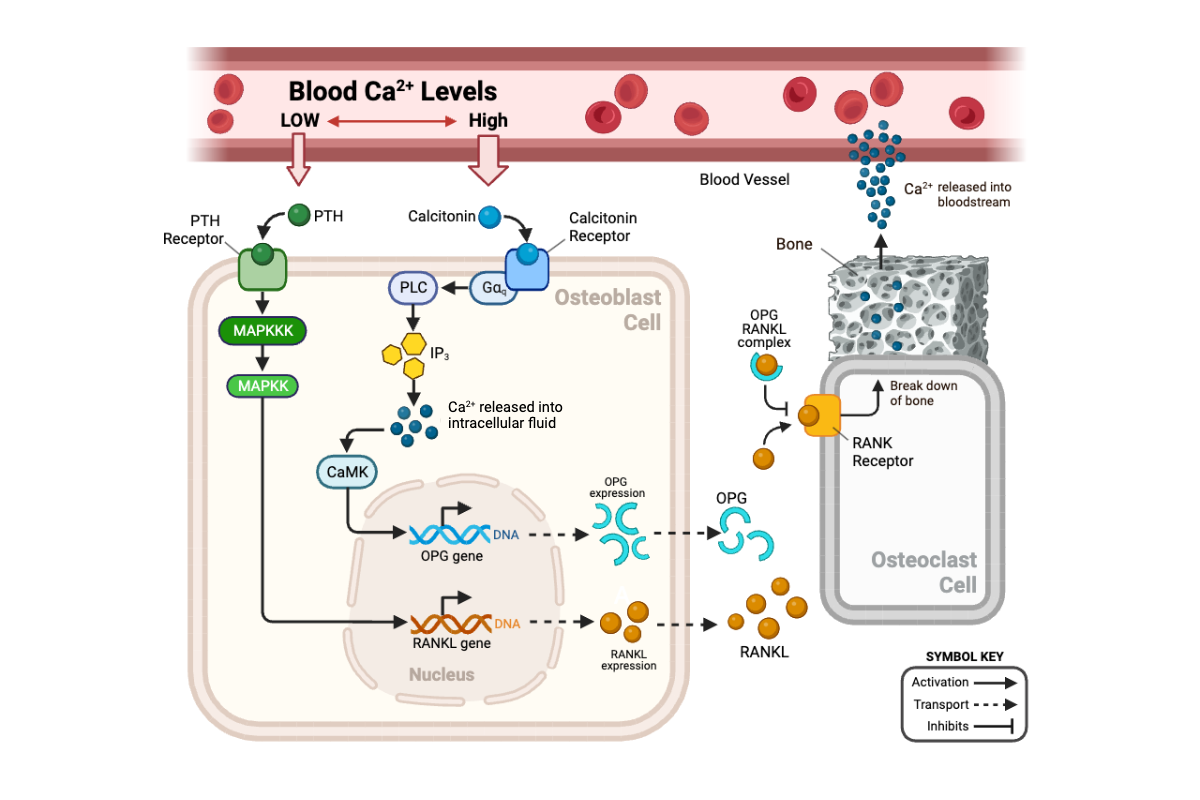
Complete the following sentence. If the concentration of Ca2+ in an osteoblast increases, the concentration of OPG in that cell would ______.
a. increase
b. decrease
c. remain the same
a. increase
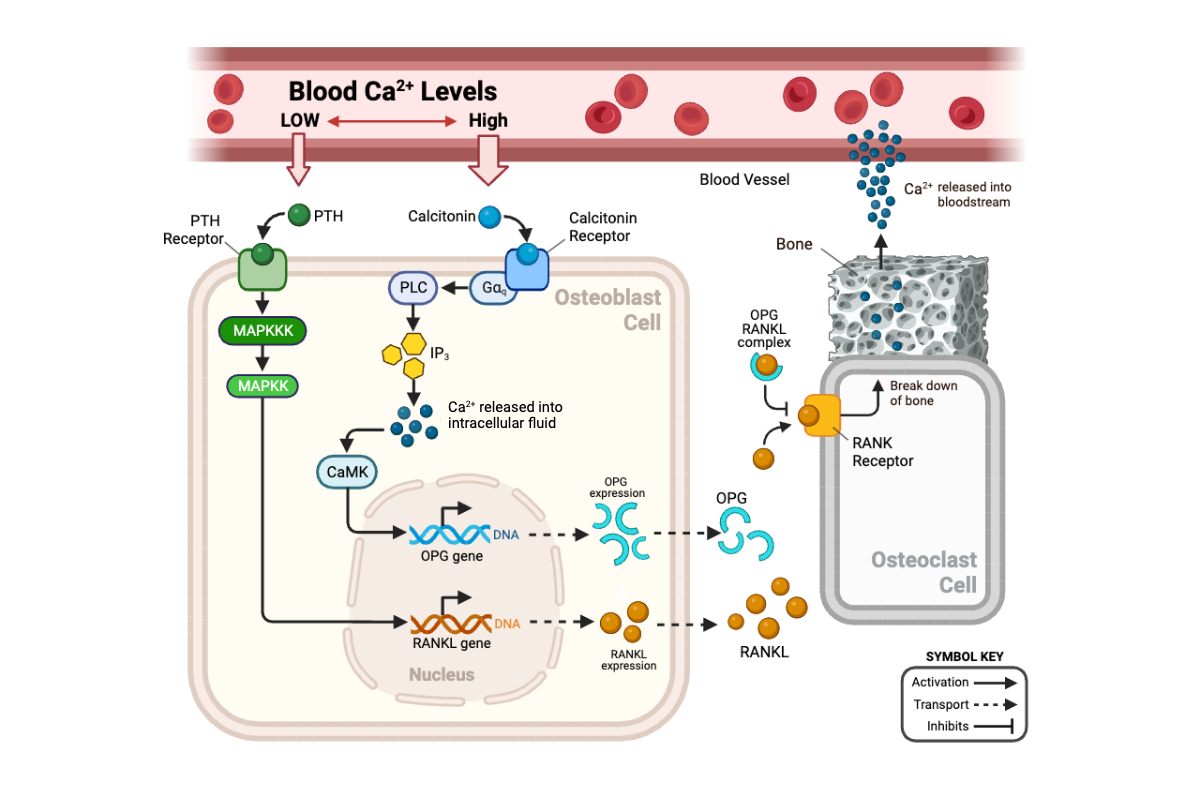
Complete the following sentence. If the concentration of OPG in osteoblasts increases, a bone would release calcium ions at _______.
a. a faster rate
b. a slower rate
c. the same rate
b. a slower rate
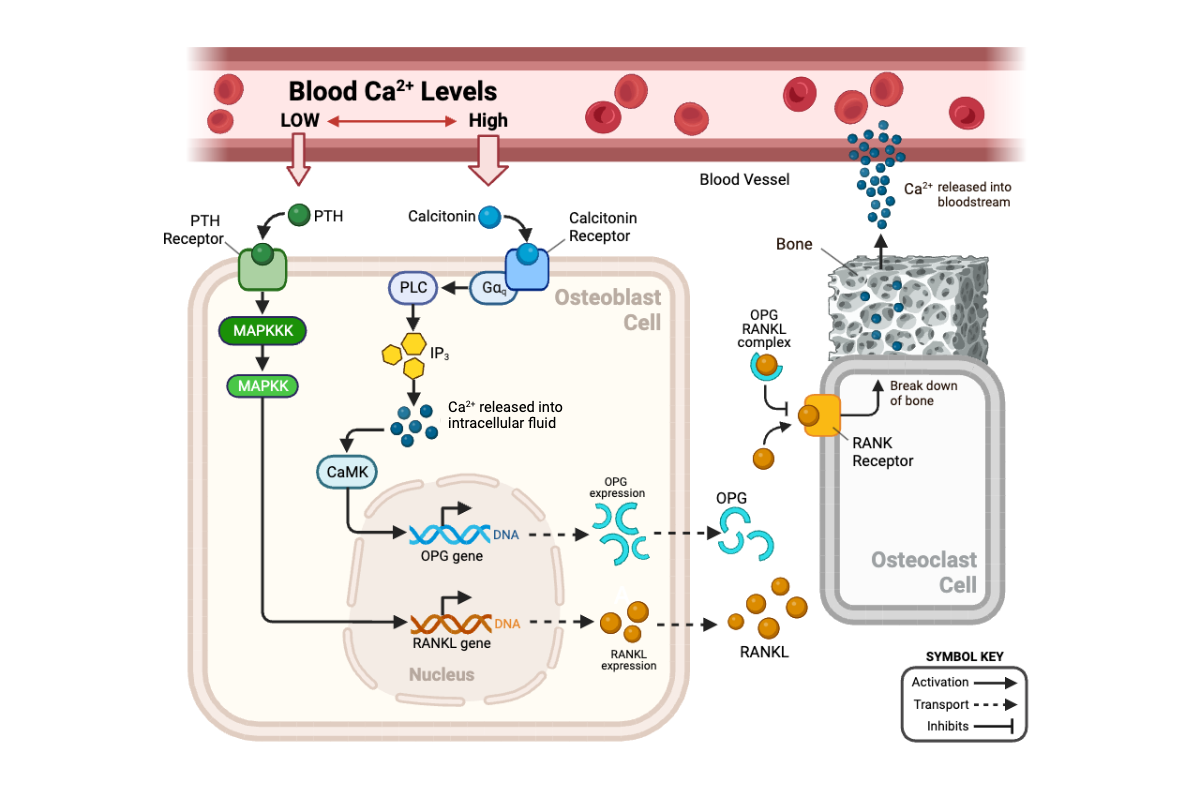
Complete the following sentence. If the concentration of calcium ions (Ca2+) in the blood became too low, the activity of calcitonin receptors would ______
a. increase
b. decrease
c. remain the same
b. decrease
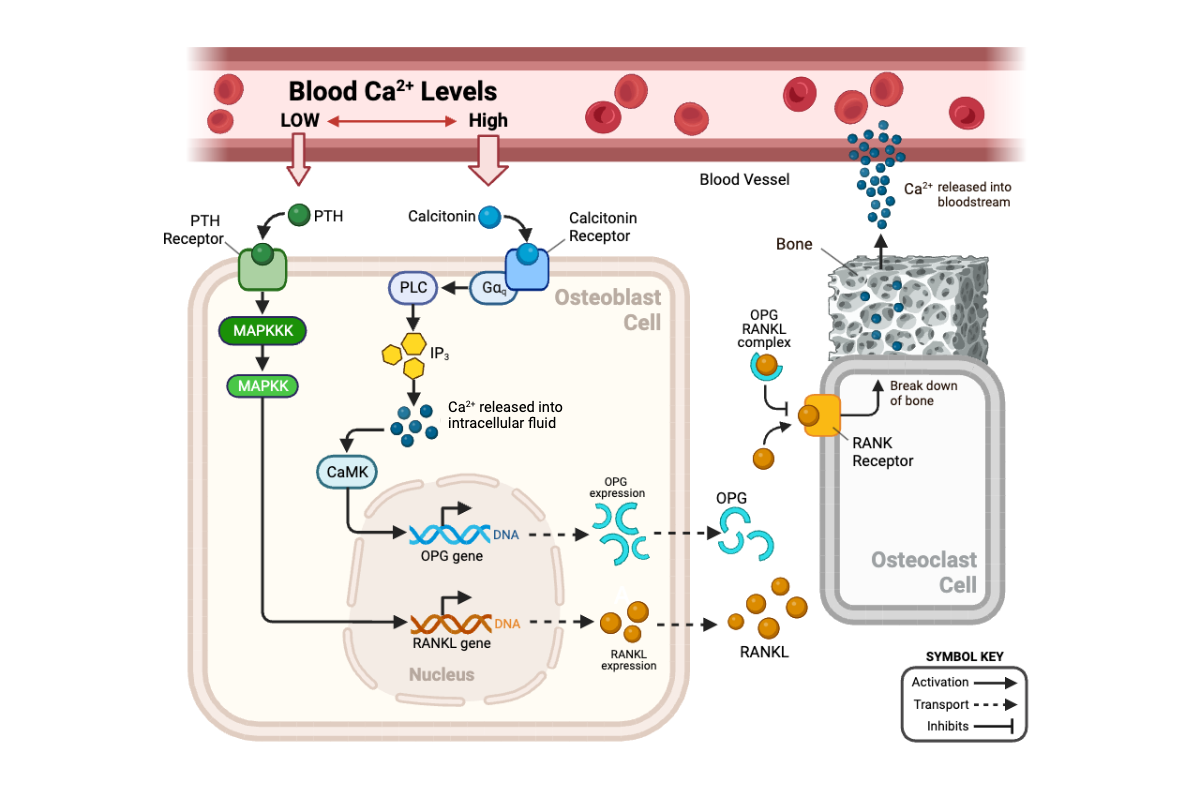
Complete the following sentence. If the concentration of calcium ions (Ca2+) in the blood became too low, the concentration of Ca2+ in an osteoblast would ______.
a. increase
b. decrease
c. remain the same
b. decrease
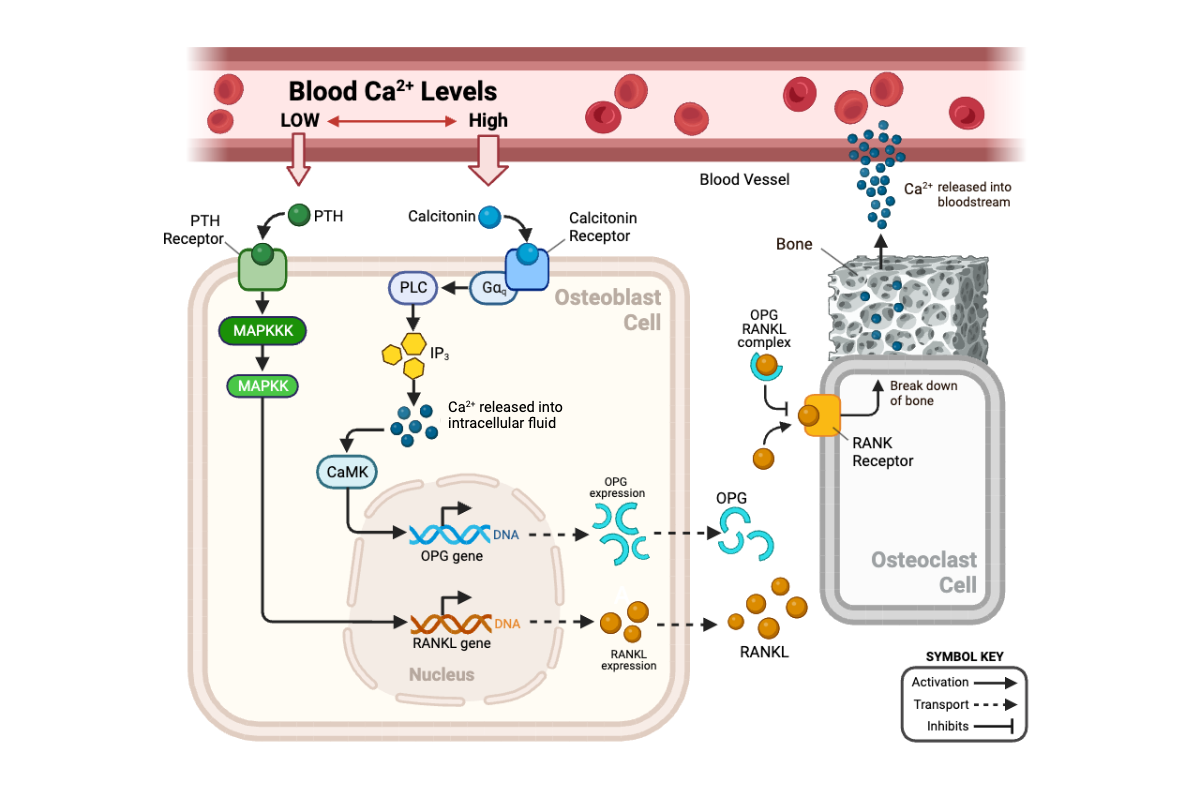
Complete the following sentence. If the concentration of calcium ions (Ca2+) in the blood became too low, the concentration of OPG in an osteoblast would ______.
a. increase
b. decrease
c. remain the same
b. decrease
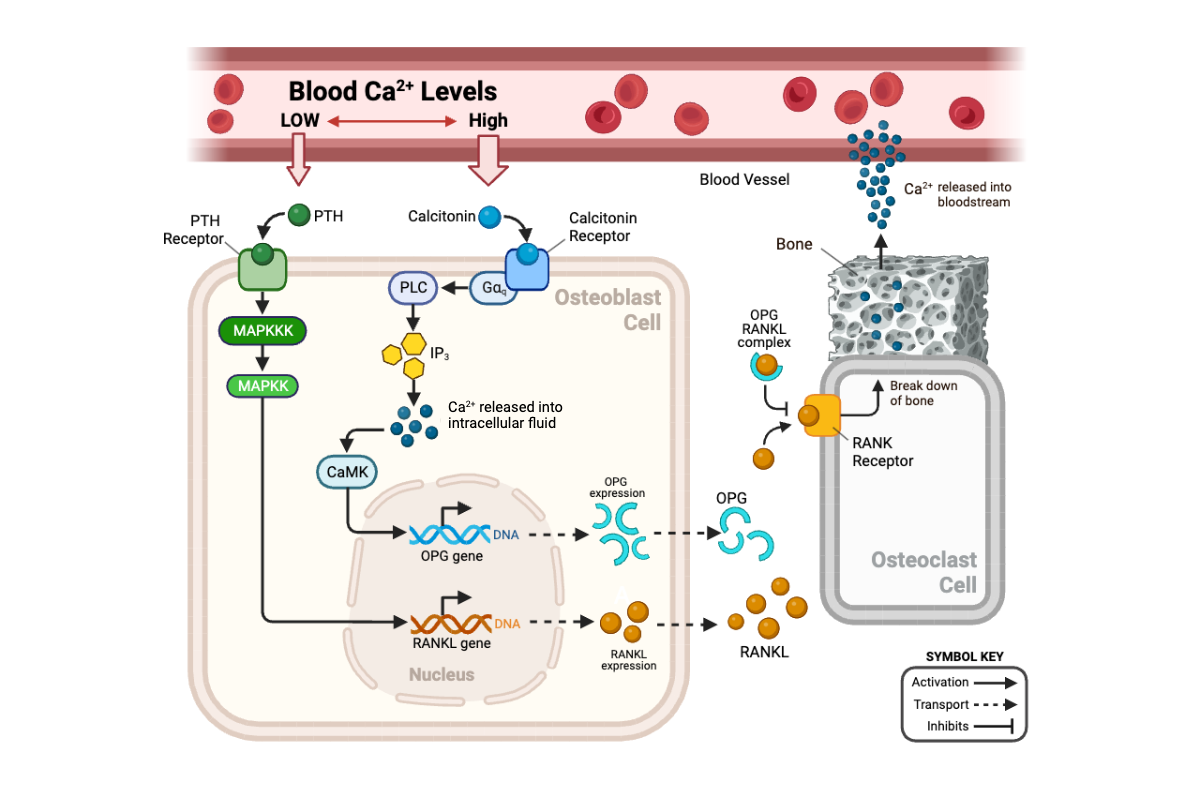
Complete the following sentence. If the concentration of calcium ions (Ca2+) in the blood became too low, the activity of PTH receptors would ______.
a. increase
b. decrease
c. remain the same
a. increase
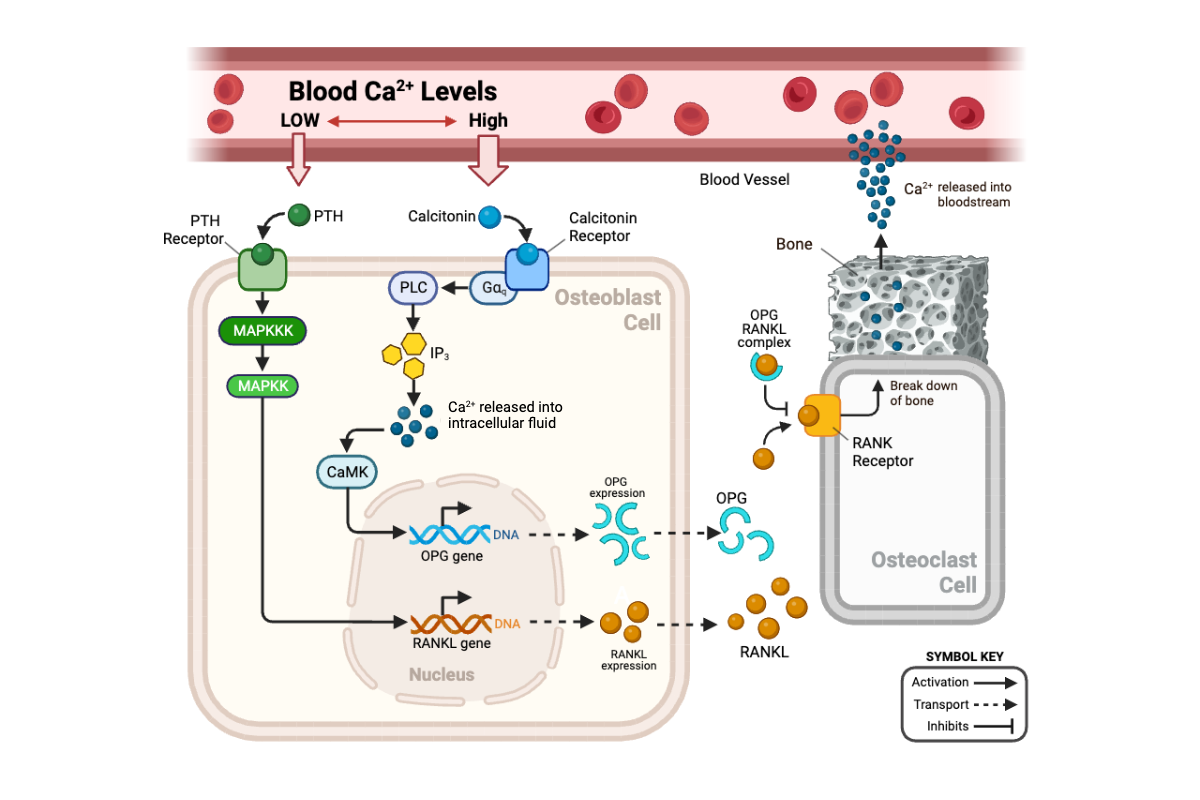
Complete the following sentence. If the concentration of calcium ions (Ca2+) in the blood became too low, the activity of MAPKK in an osteoblast would ______.
a. increase
b. decrease
c. remain the same
a. increase
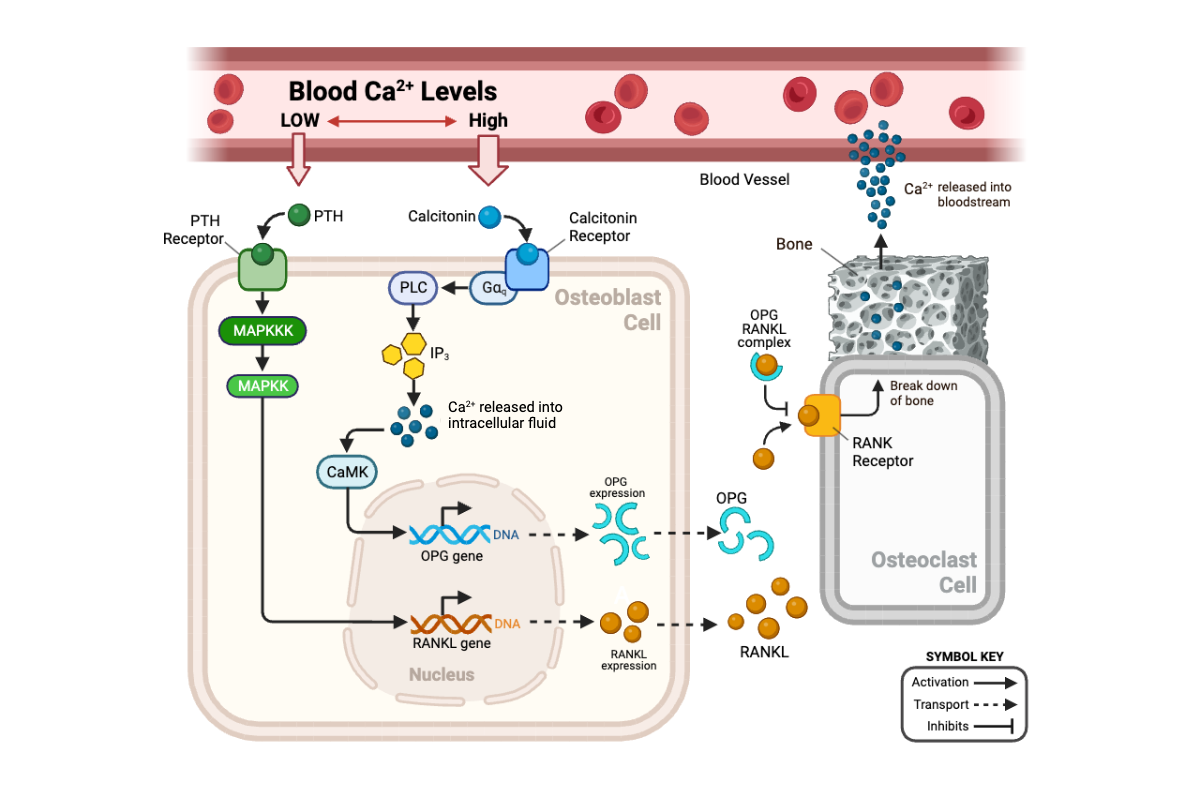
Complete the following sentence. If the concentration of calcium ions (Ca2+) in the blood became too low, the concentration of RANKL in an osteoblast would ______.
a. increase
b. decrease
c. remain the same
a. increase
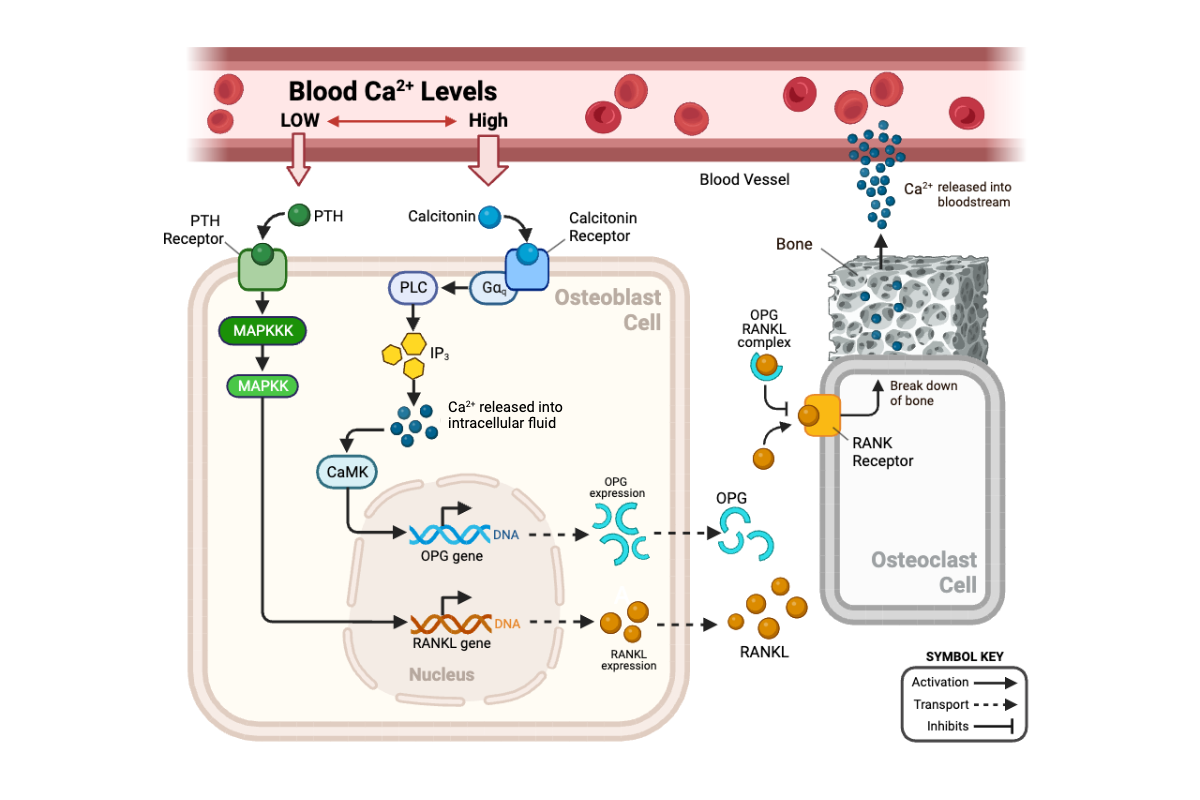
Complete the following sentence. If the concentration of calcium ions (Ca2+) in the blood became too low, the activity of RANK receptors would ______.
a. increase
b. decrease
c. remain the same
a. increase
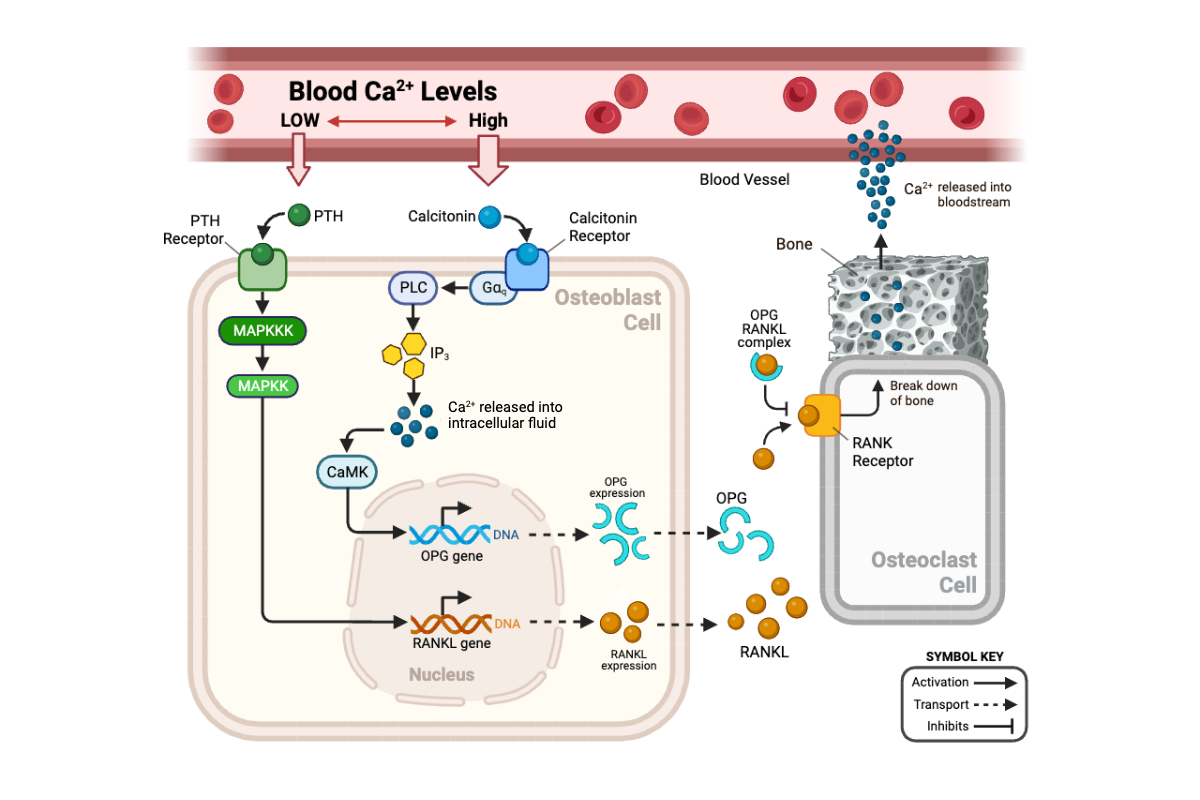
Complete the following sentence. If the concentration of calcium ions (Ca2+) in the blood became too low, a bone would release Ca2+ at ______.
a. a faster rate
b. a slower rate
c. the same rate
a. a faster rate
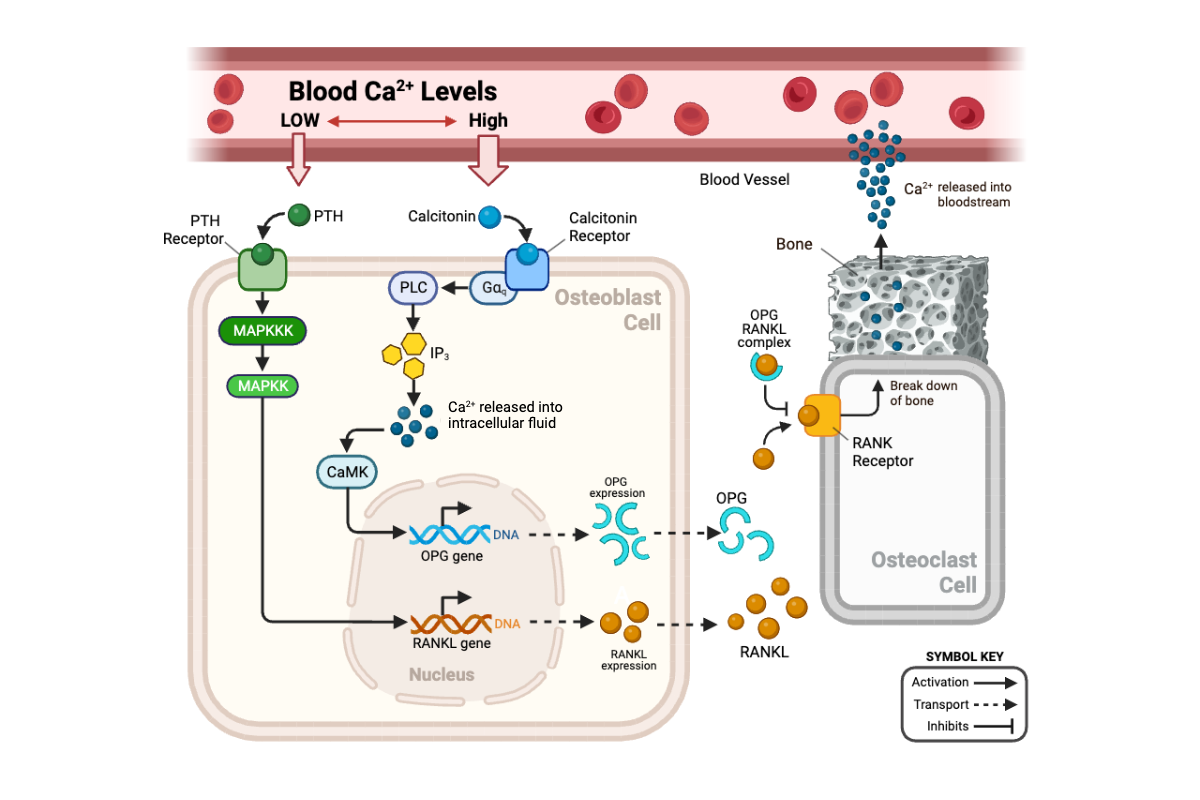
Complete the following sentence. If the concentration of calcium ions (Ca2+) in the blood became too high, the activity of calcitonin receptors would ______.
a. increase
b. decrease
c. remain the same
a. increase
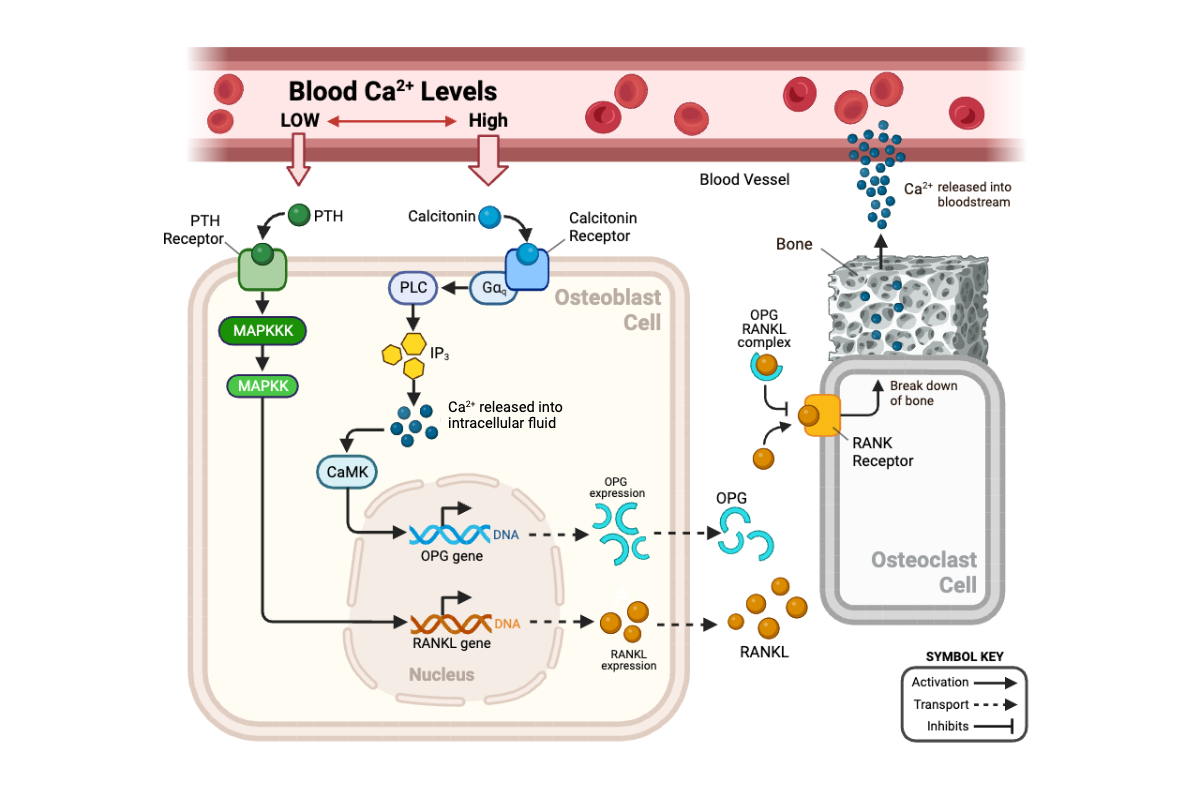
Complete the following sentence. If the concentration of calcium ions (Ca2+) in the blood became too high, the concentration of Ca2+ in an osteoblast would ______.
a. increase
b. decrease
c. remain the same
a. increase
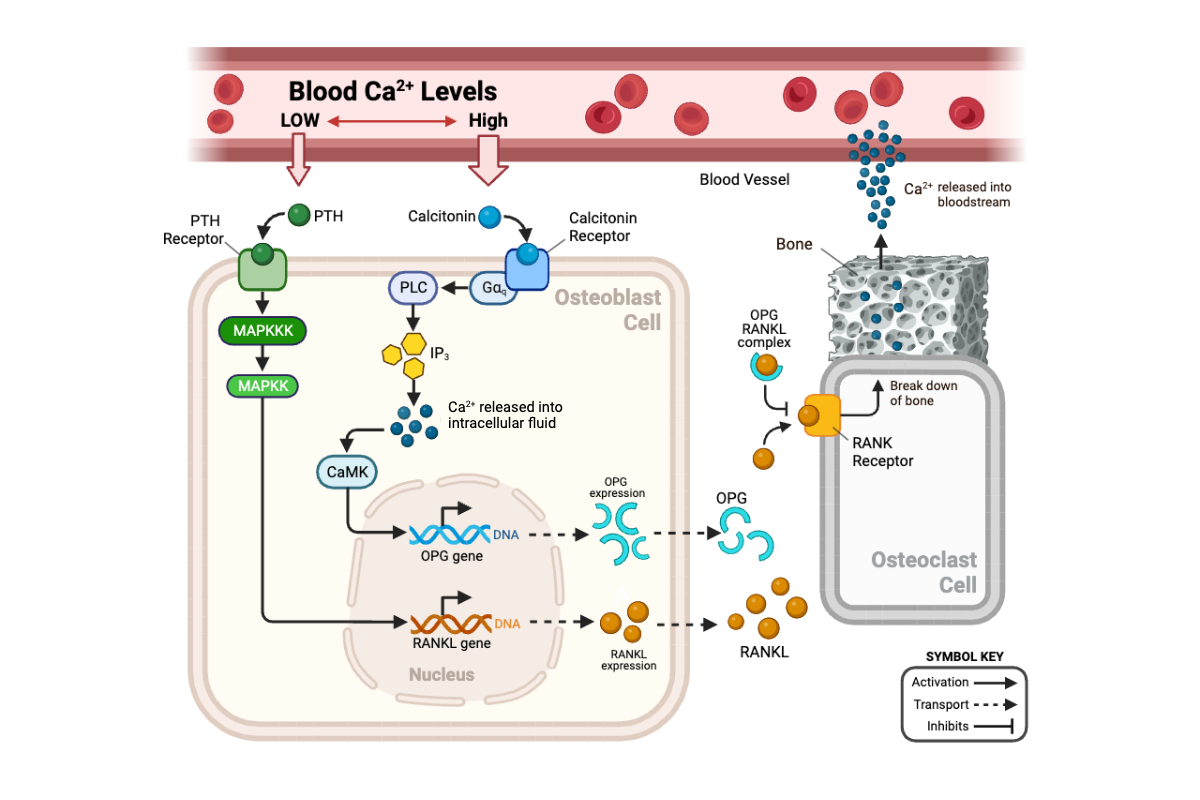
Complete the following sentence. If the concentration of calcium ions (Ca2+) in the blood became too high, the concentration of OPG in an osteoblast would ______.
a. increase
b. decrease
c. remain the same
a. increase
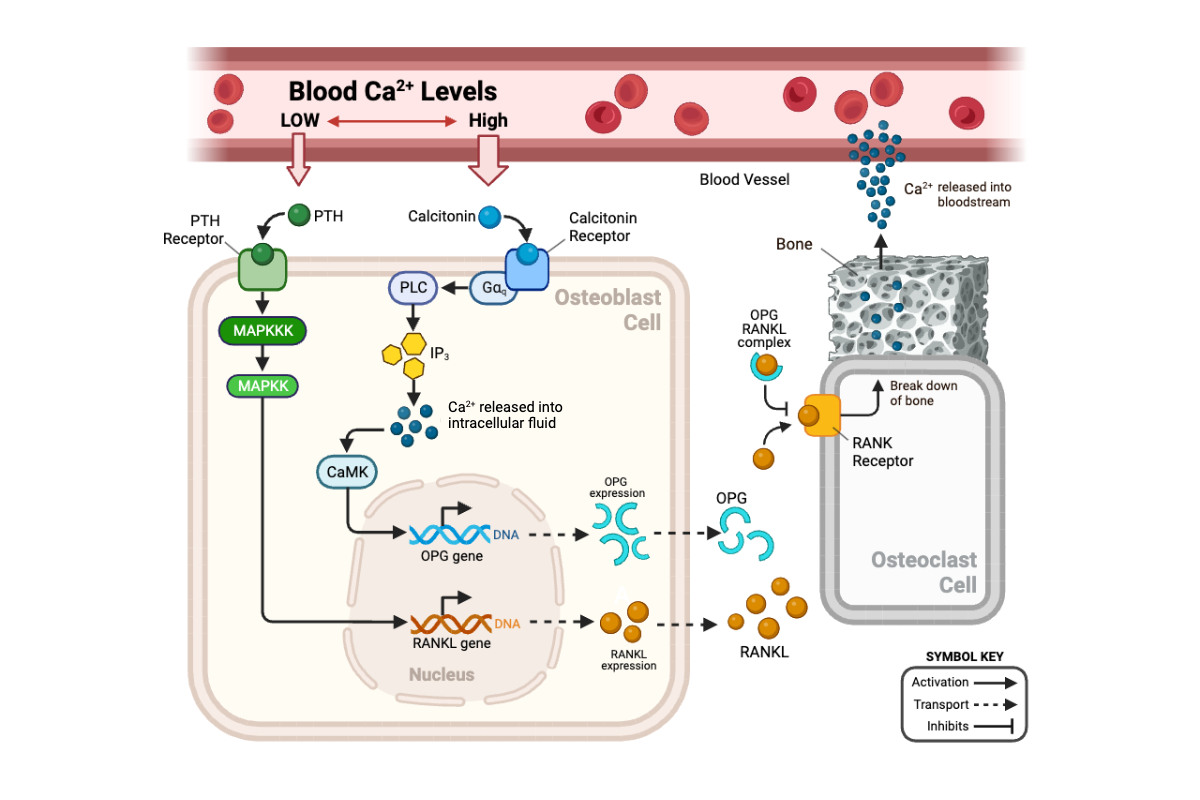
Complete the following sentence. If the concentration of calcium ions (Ca2+) in the blood became too high, the activity of PTH receptors would ______.
a. increase
b. decrease
c. remain the same
c. remain the same
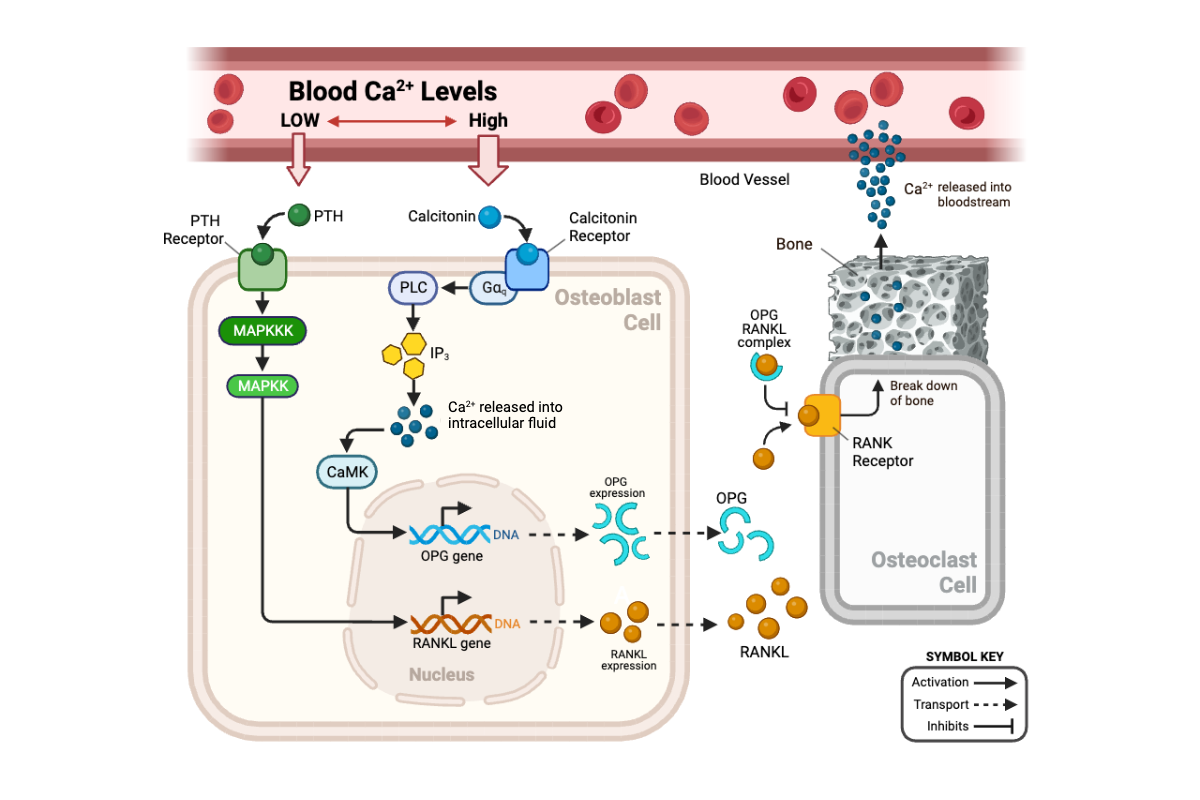
Complete the following sentence. If the concentration of calcium ions (Ca2+) in the blood became too high, the activity of MAPKK in an osteoblast would ______.
a. increase
b. decrease
c. remain the same
c. remain the same
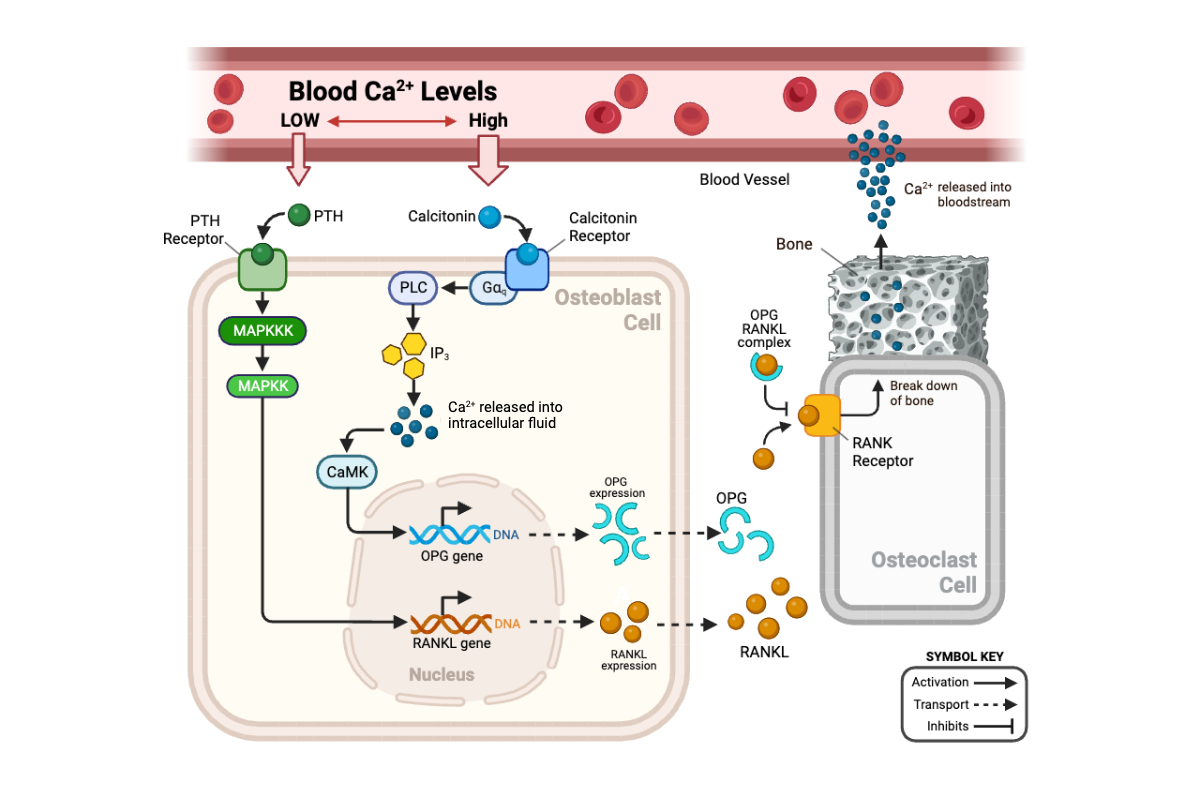
Complete the following sentence. If the concentration of calcium ions (Ca2+) in the blood became too high, the concentration of RANKL in an osteoblast would ______.
a. increase
b. decrease
c. remain the same
c. remain the same
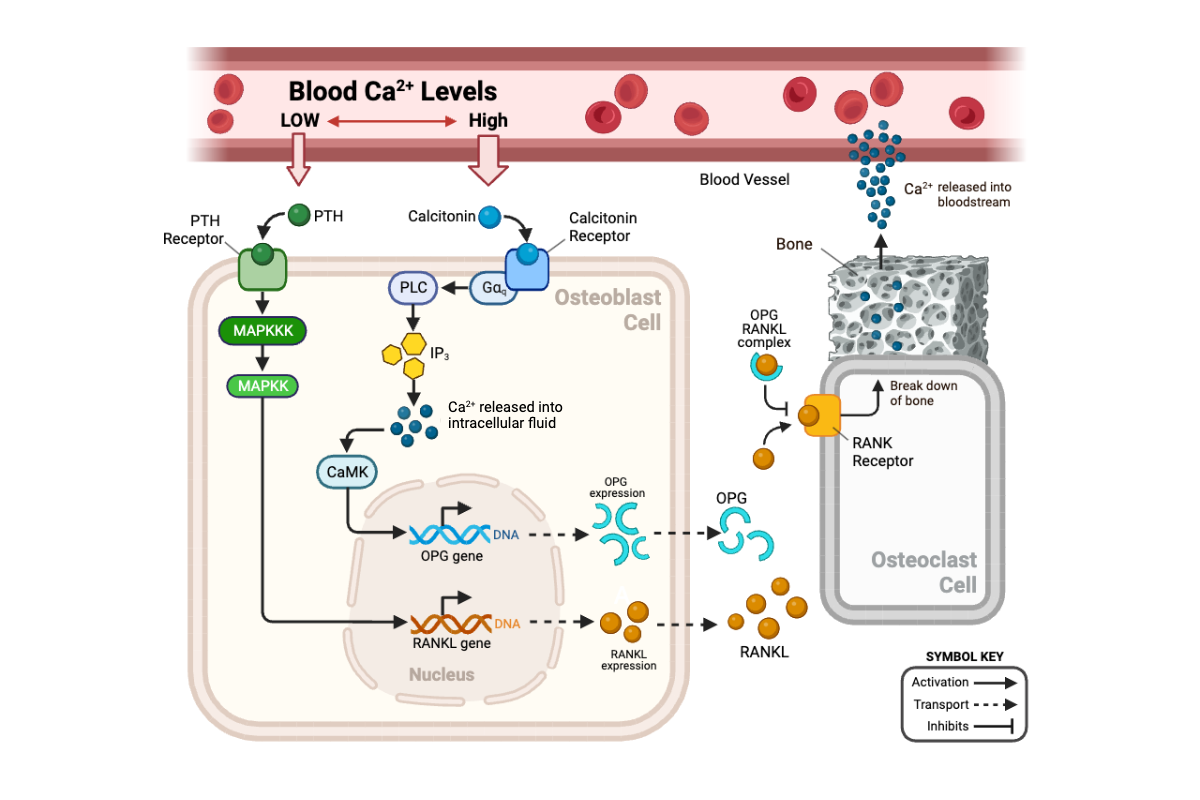
Complete the following sentence. If the concentration of calcium ions (Ca2+) in the blood became too high, the activity of RANK receptors would ______.
a. increase
b. decrease
c. remain the same
b. decrease
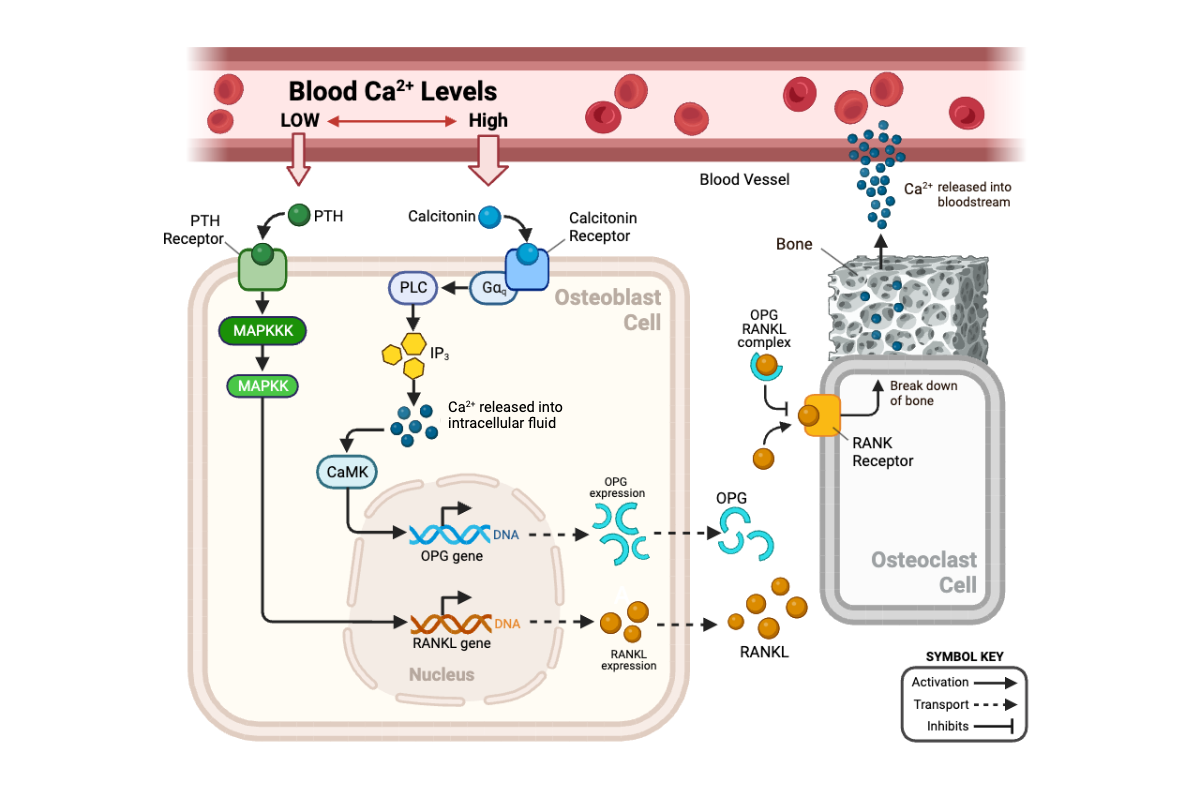
Complete the following sentence. If the concentration of calcium ions (Ca2+) in the blood became too high, a bone would release Ca2+ at ______.
a. a faster rate
b. a slower rate
c. the same rate
b. a slower rate
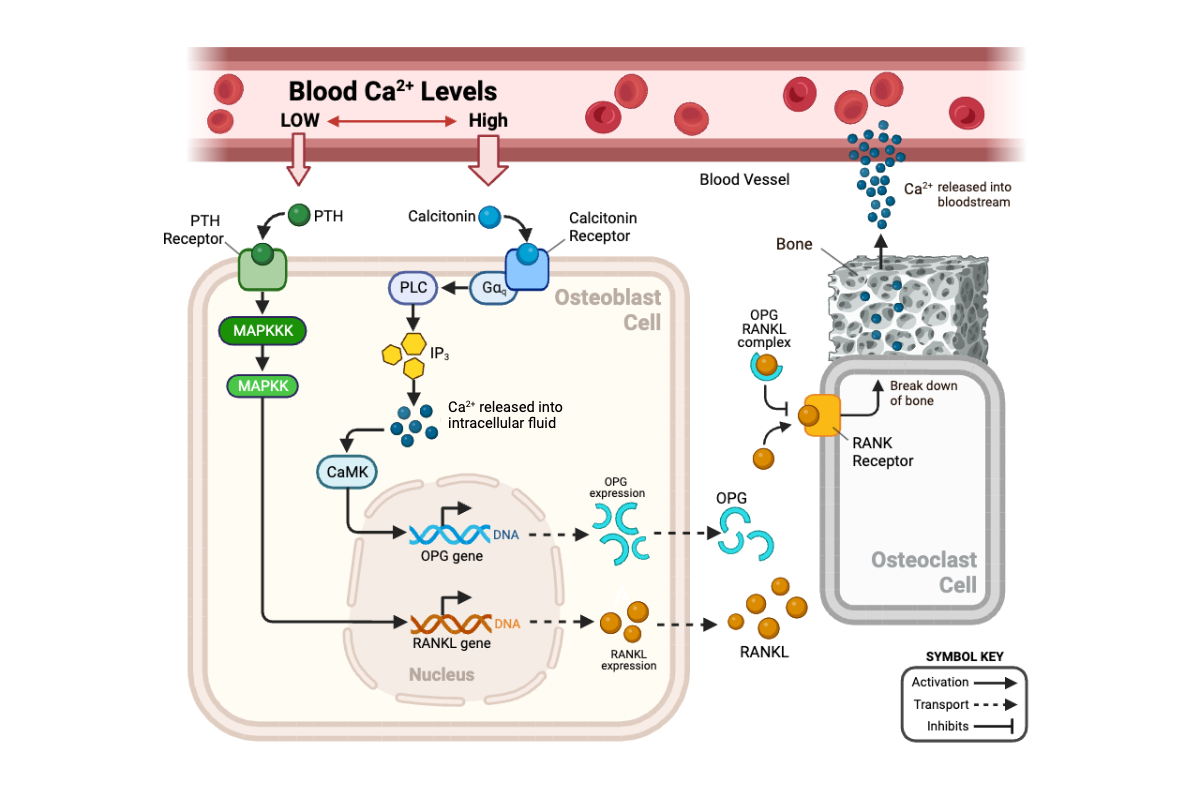
Complete the following sentence. If the number of PTH receptors increased, the concentration of Ca2+ in an osteoblast would ______.
a. increase
b. decrease
c. remain the same
c. remain the same
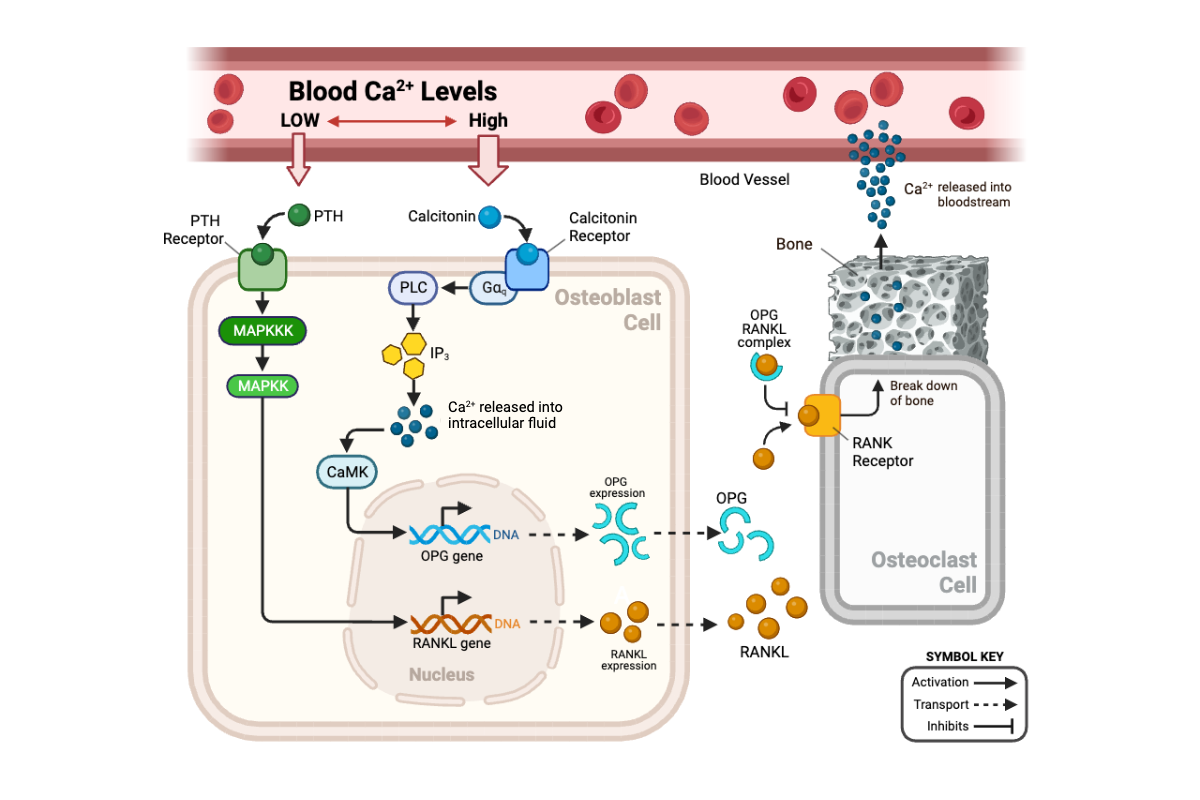
Complete the following sentence. If the number of PTH receptors increased, the concentration of OPG in an osteoblast would ______.
a. increase
b. decrease
c. remain the same
c. remain the same
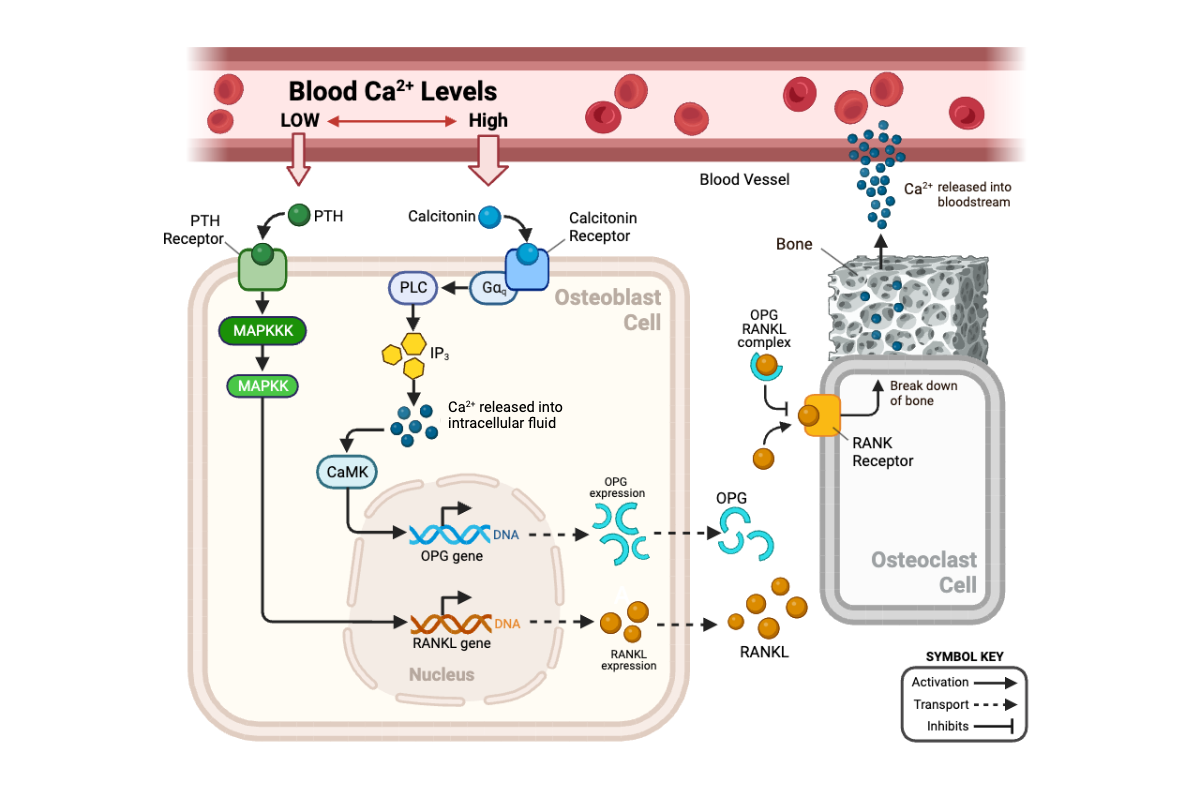
Complete the following sentence. If the number of PTH receptors increased, the activity of MAPKK in an osteoblast would ______.
a. increase
b. decrease
c. remain the same
a. increase
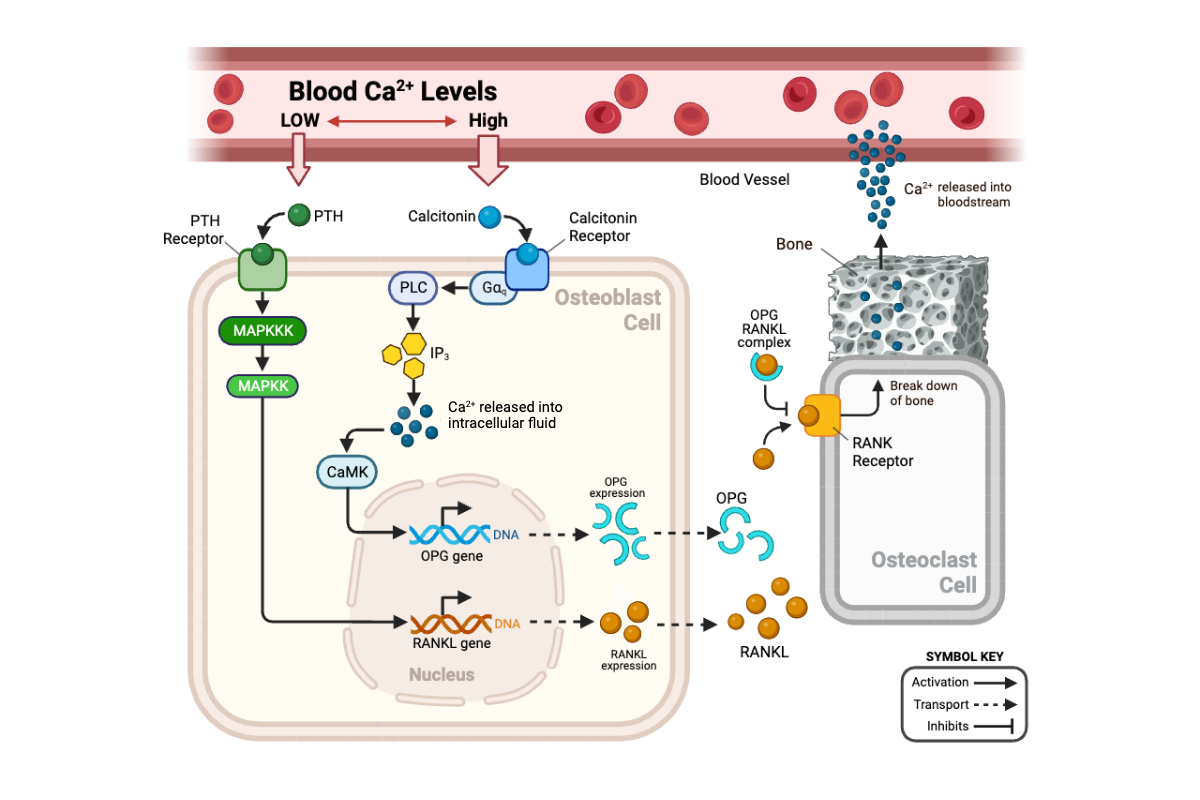
Complete the following sentence. If the number of PTH receptors increased, the concentration of RANKL in an osteoblast would ______.
a. increase
b. decrease
c. remain the same
a. increase
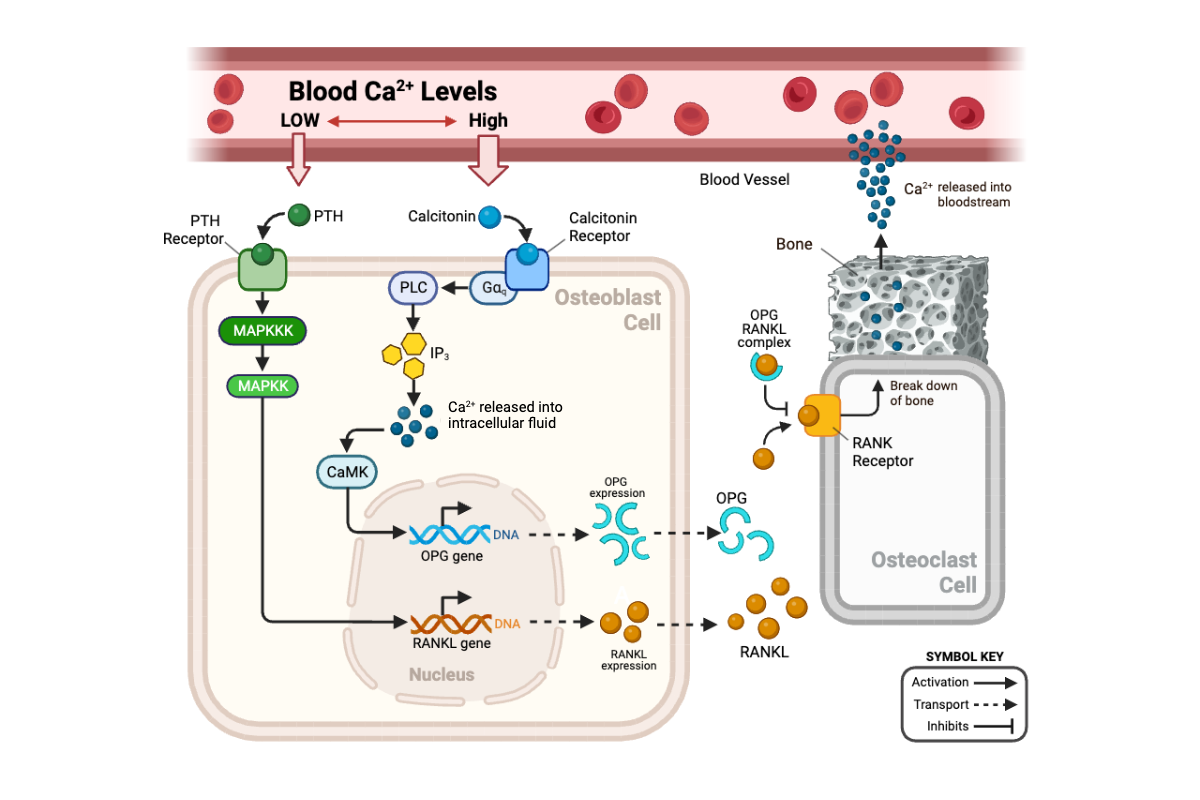
Complete the following sentence. If the number of PTH receptors increased, a bone would release Ca2+ at ______.
a. a faster rate
b. a slower rate
c. the same rate
a. a faster rate
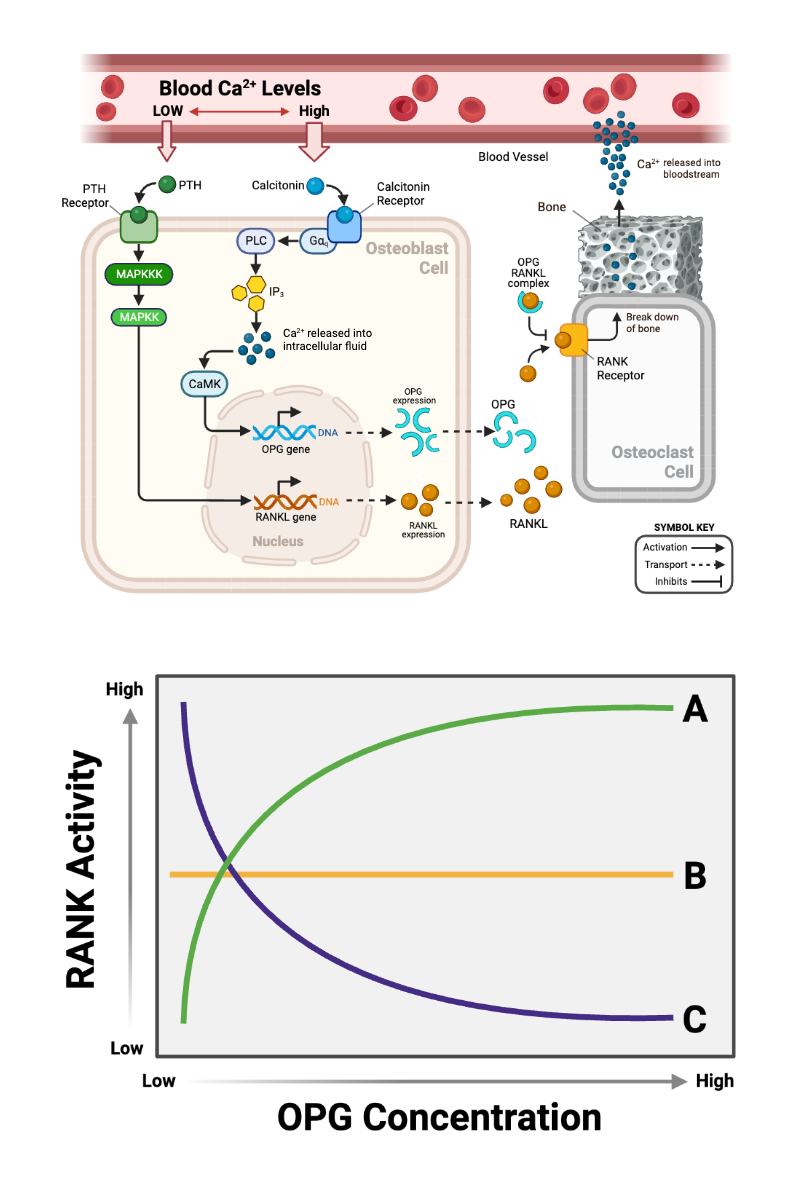
Which relationship accurately represents the expected relationship if the concentration of RANKL remains constant?
a. Relationship A
b. Relationship B
c. Relationship C
c. Relationship C
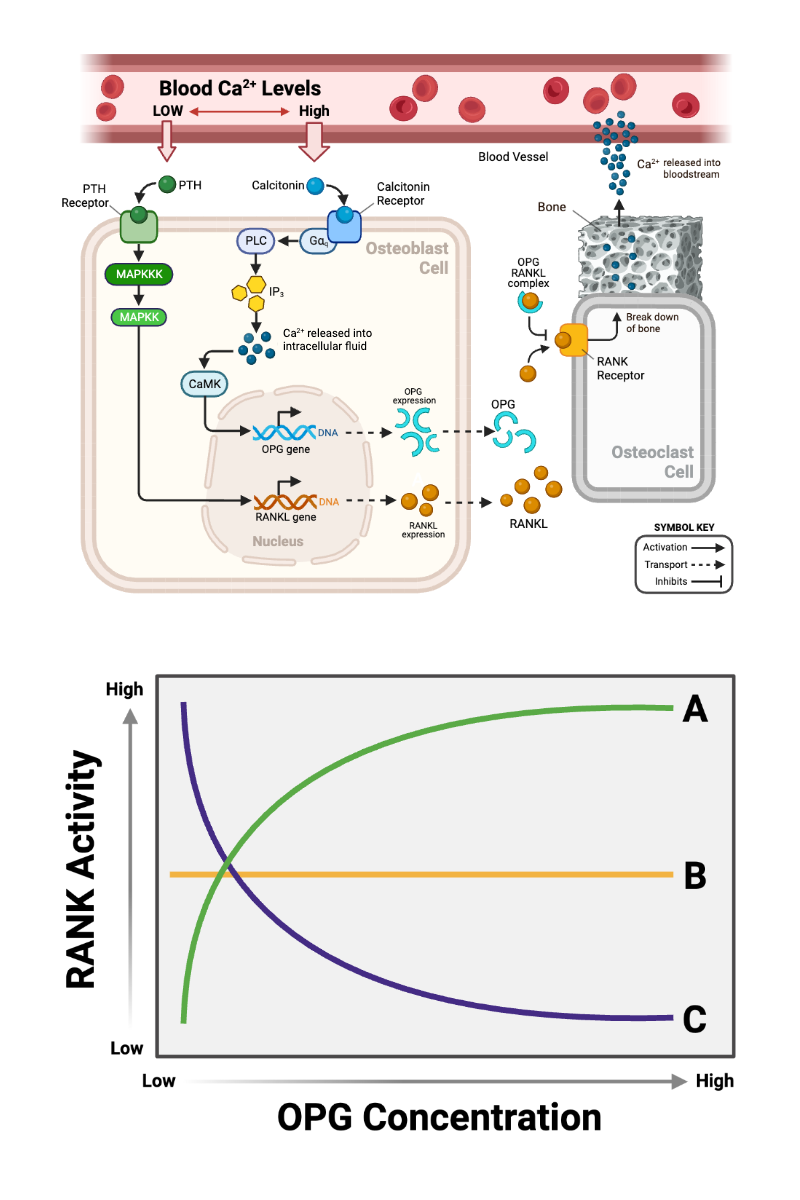
Which relationship would best represent the expected relationship if the concentration of RANKL were to change proportionally to the concentration OPG?
a. Relationship A
b. Relationship B
c. Relationship C
b. Relationship B
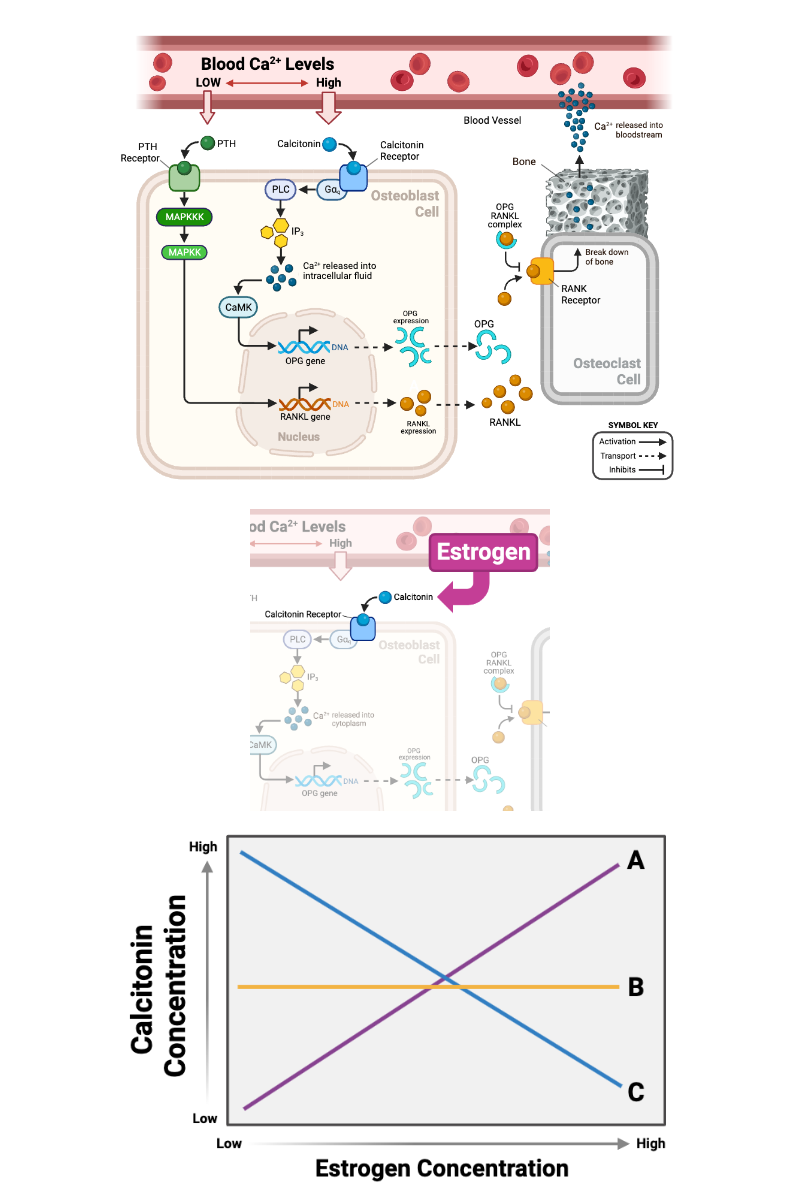
Which line accurately describes the expected relationship?
a. Line A
b. Line B
c. Line C
a. Line A
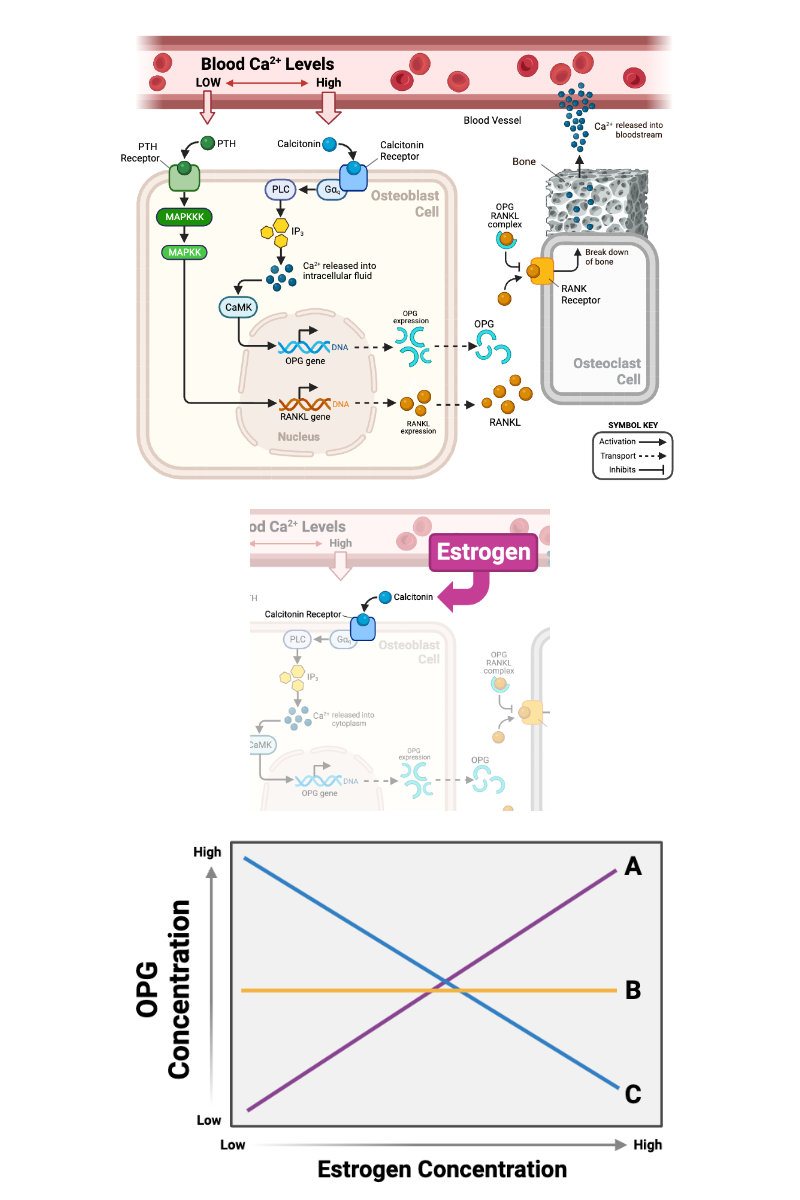
The graph shows three potential relationships between the concentration of estrogen and the concentration of OPG.
Which line accurately describes the expected relationship?
a. Line A
b. Line B
c. Line C
a. Line A
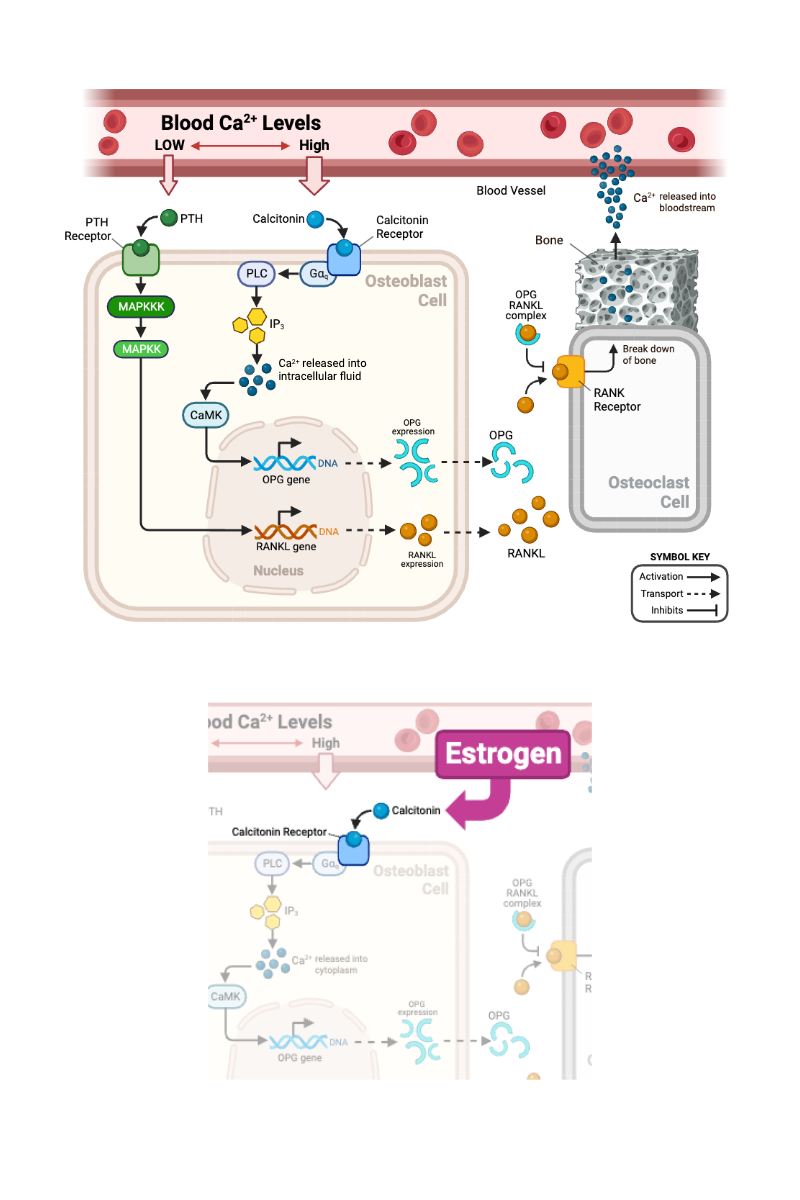
Complete the following sentence. As the concentration of estrogen increases during pregnancy, the concentration of calcium ions (Ca2+) in an osteoblast should ______ .
a. increase
b. decrease
c. remain the same
a. increase
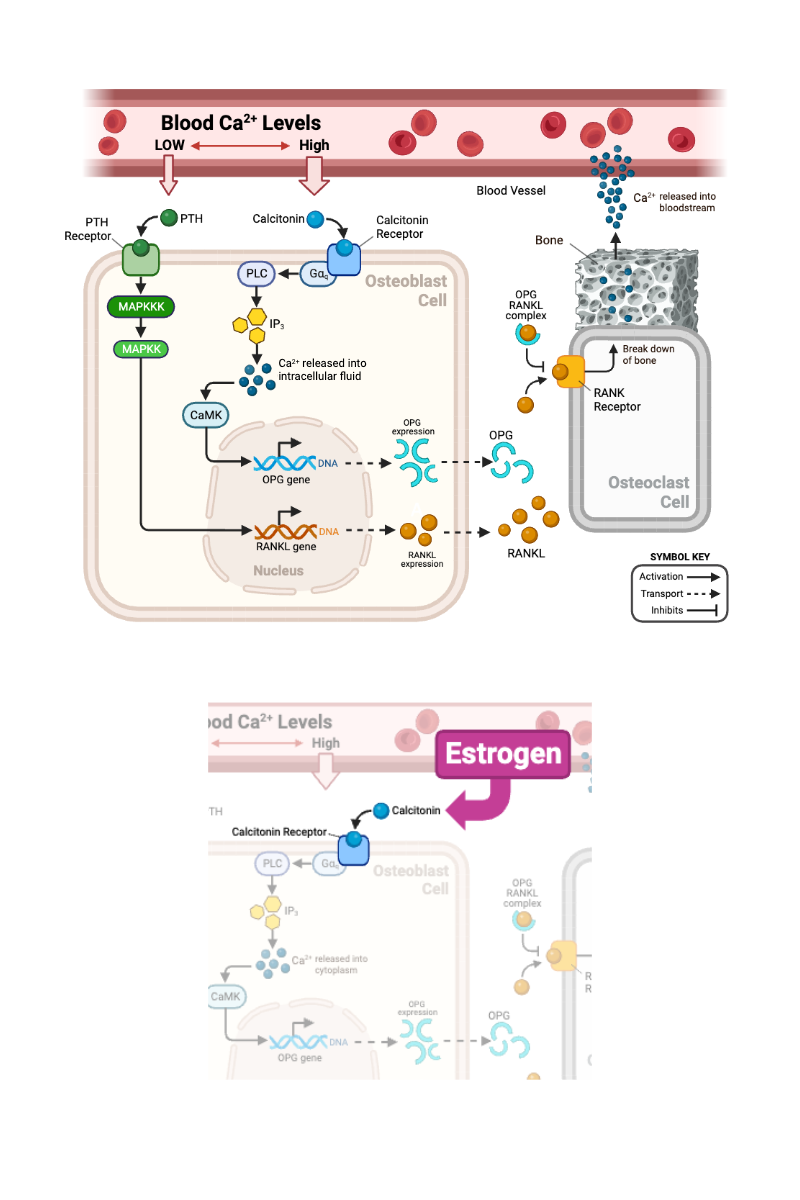
Complete the following sentence. As the concentration of estrogen increases during pregnancy, the activity of MAPKK in an osteoblast should ______ .
a. increase
b. decrease
c. remain the same
c. remain the same
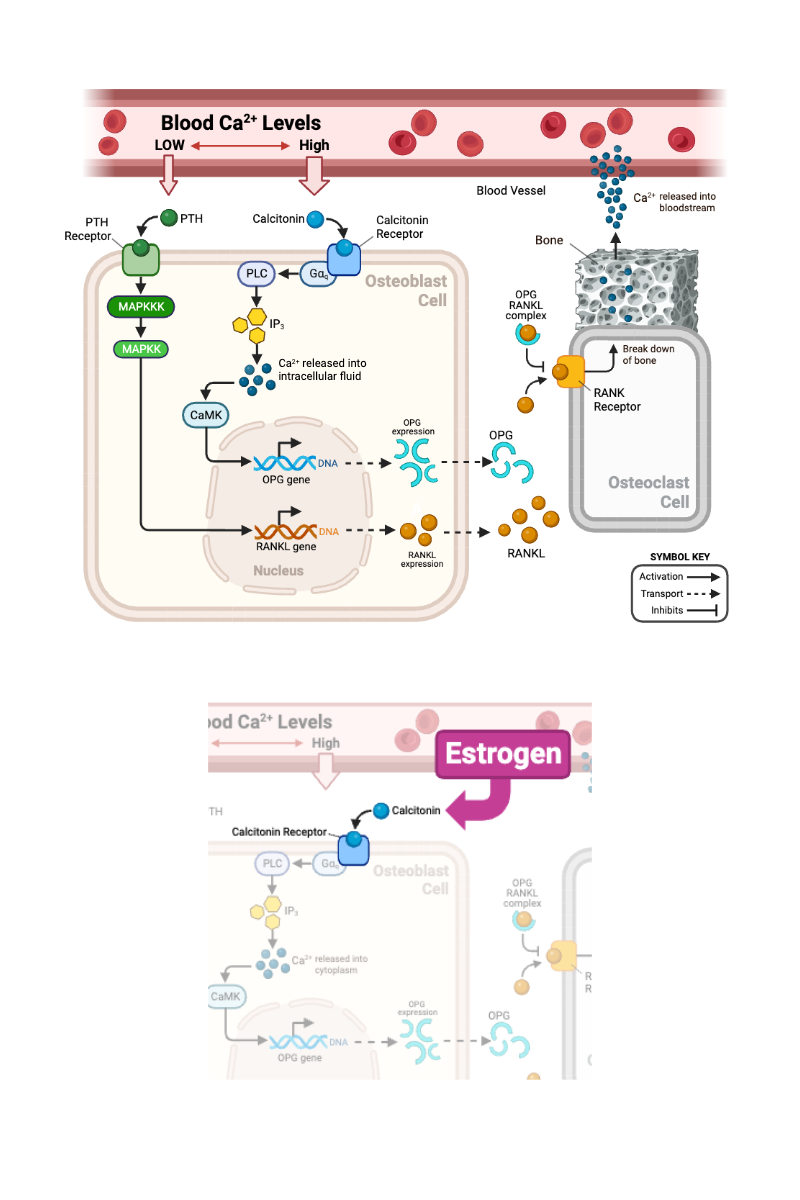
Complete the following sentence. As the concentration of estrogen increases during pregnancy, the activity of PLC in an osteoblast should ______ .
a. increase
b. decrease
c. remain the same
a. increase
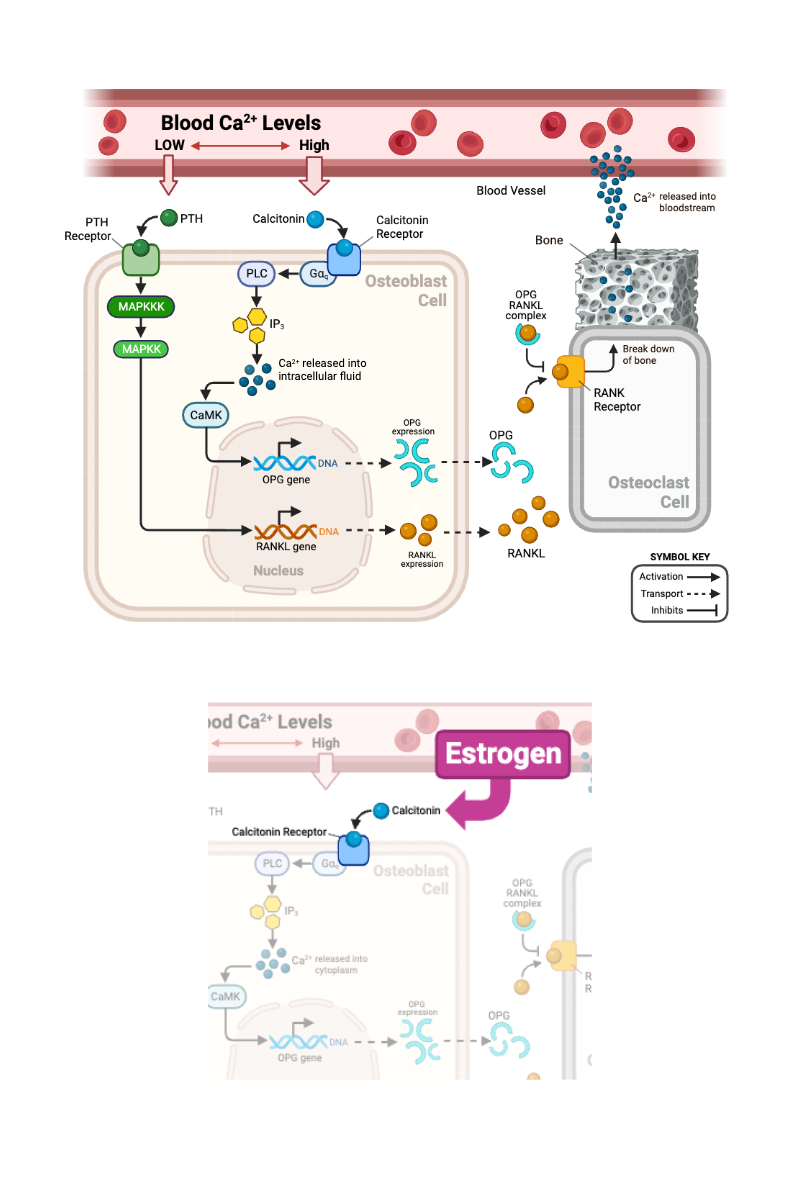
Complete the following sentence. As the concentration of estrogen increases during pregnancy, the concentration of RANKL in an osteoblast should ______ .
a. increase
b. decrease
c. remain the same
c. remain the same
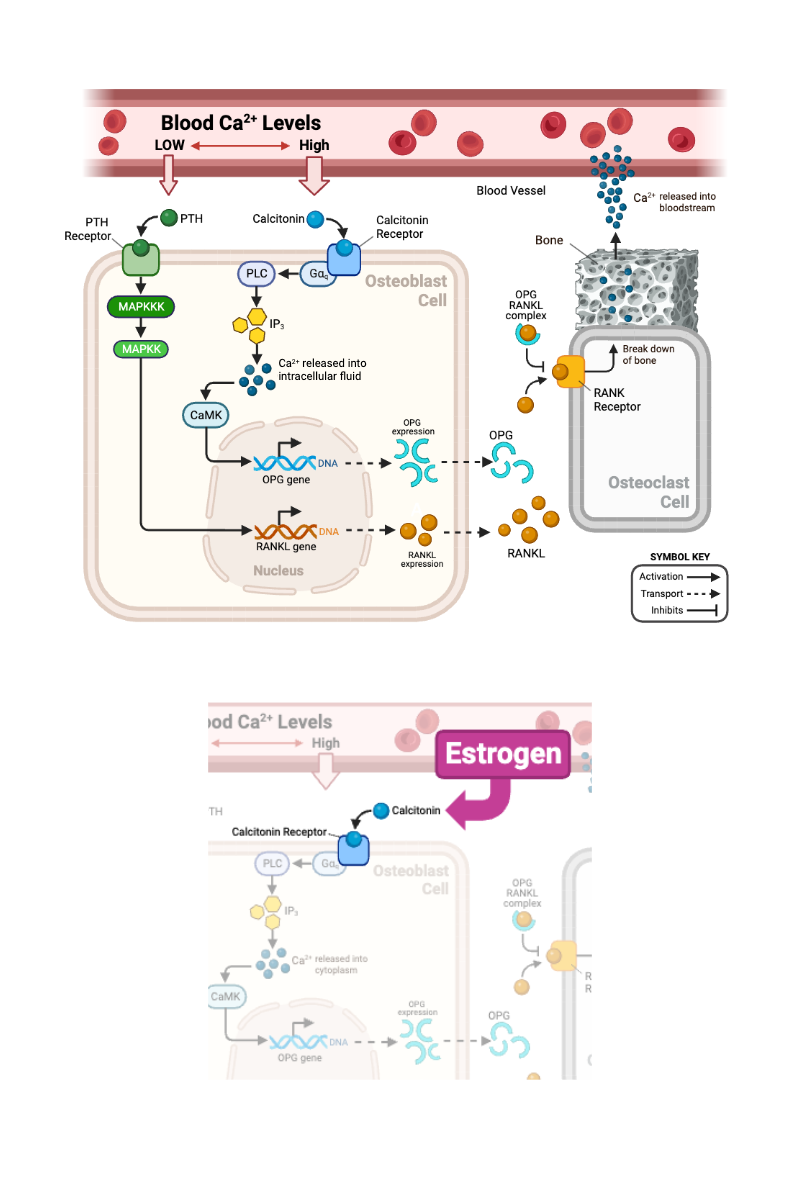
Complete the following sentence. As the concentration of estrogen increases during pregnancy, the activity of RANK receptors in the membrane of an osteoclast should ______ .
a. increase
b. decrease
c. remain the same
b. decrease
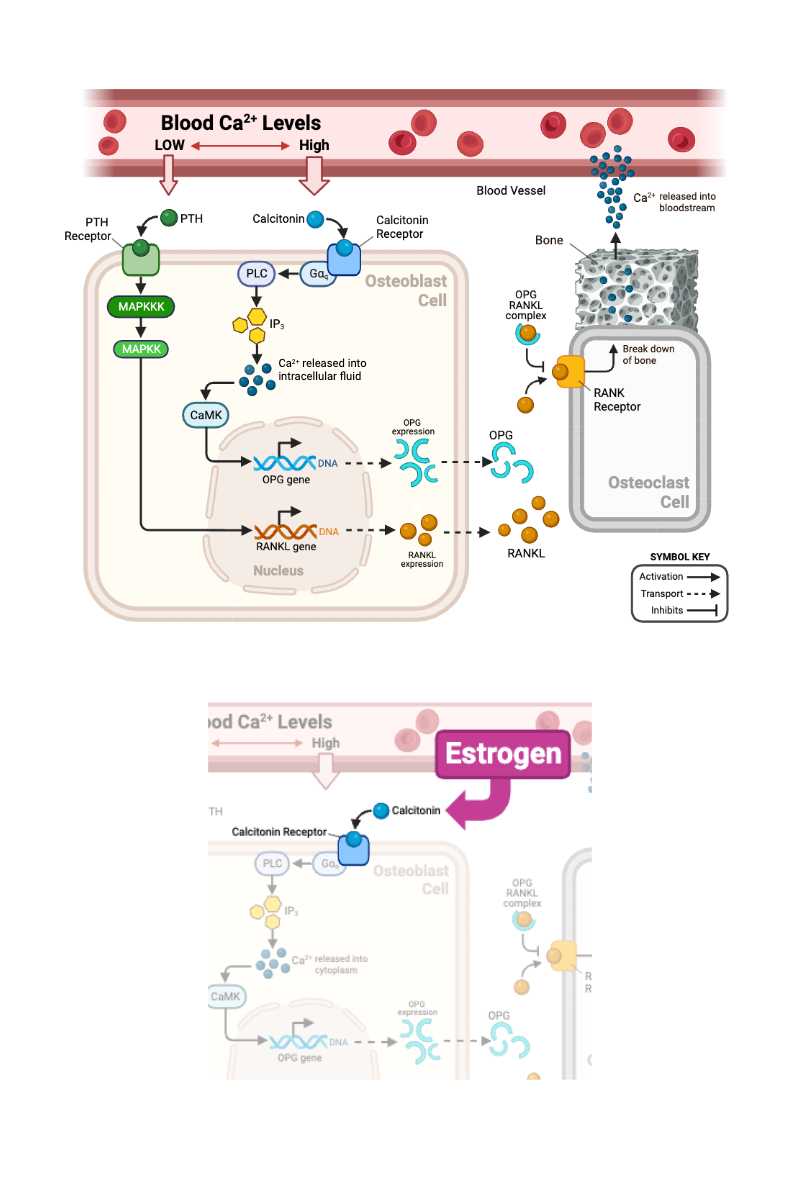
Complete the following sentence. As the concentration of estrogen increases during pregnancy, a bone would release Ca2+ at _______.
a. a faster rate
b. a slower rate
c. the same rate
b. a slower rate
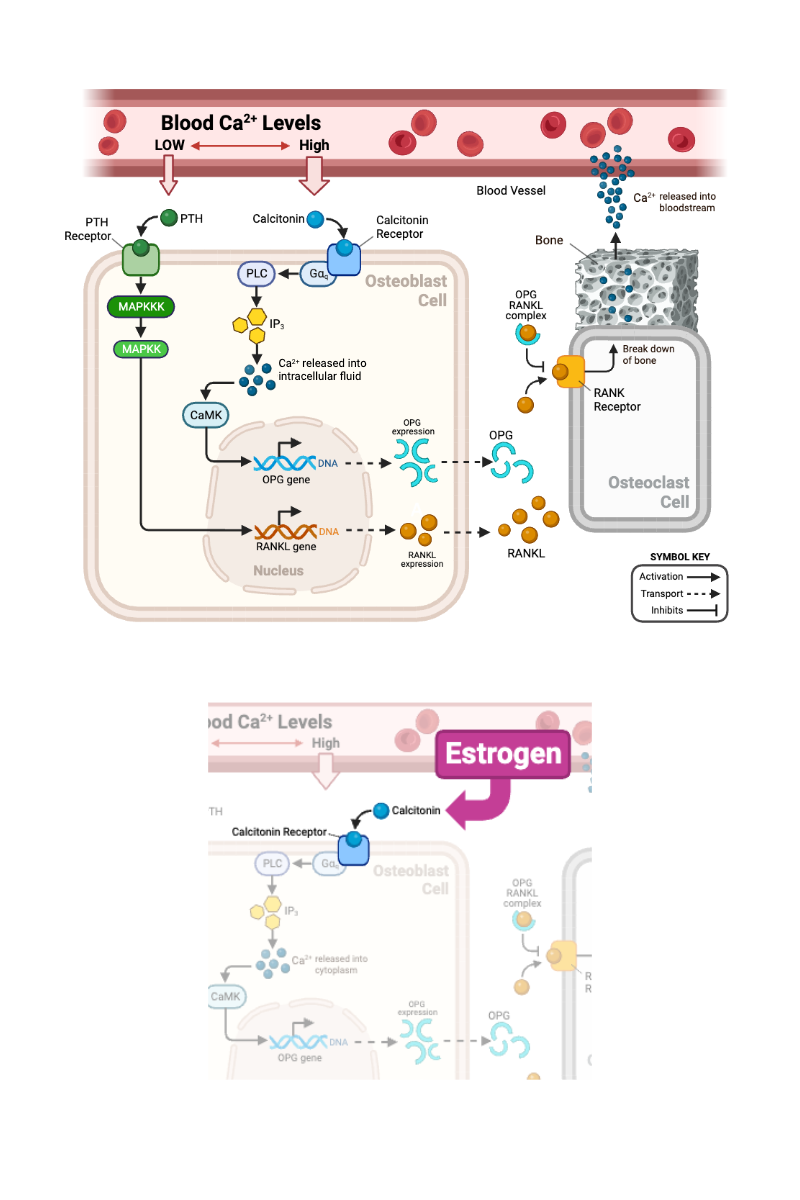
Complete the following sentence. As the concentration of estrogen decreases during menopause, the concentration of calcitonin in the blood should ______ .
a. increase
b. decrease
c. remain the same
b. decrease
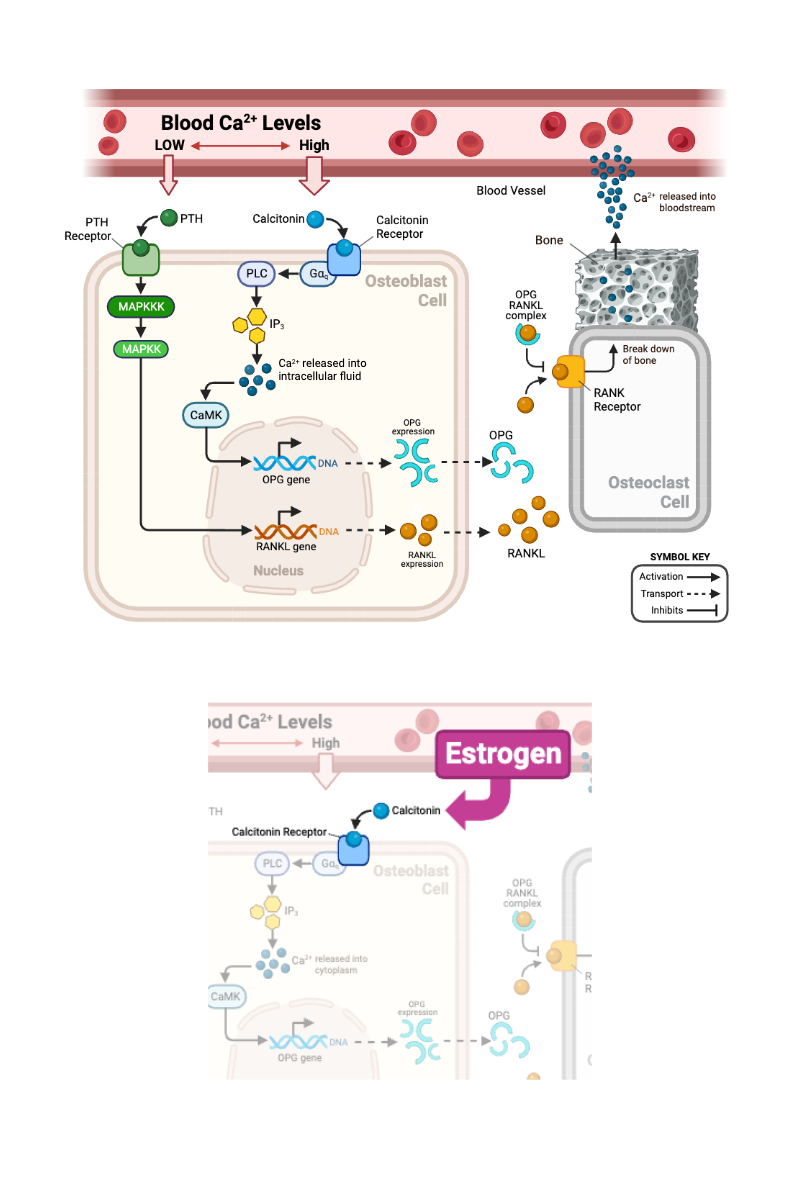
Complete the following sentence. As the concentration of estrogen decreases during menopause, the concentration of calcium ions (Ca2+) in an osteoblast should ______ .
a. increase
b. decrease
c. remain the same
b. decrease
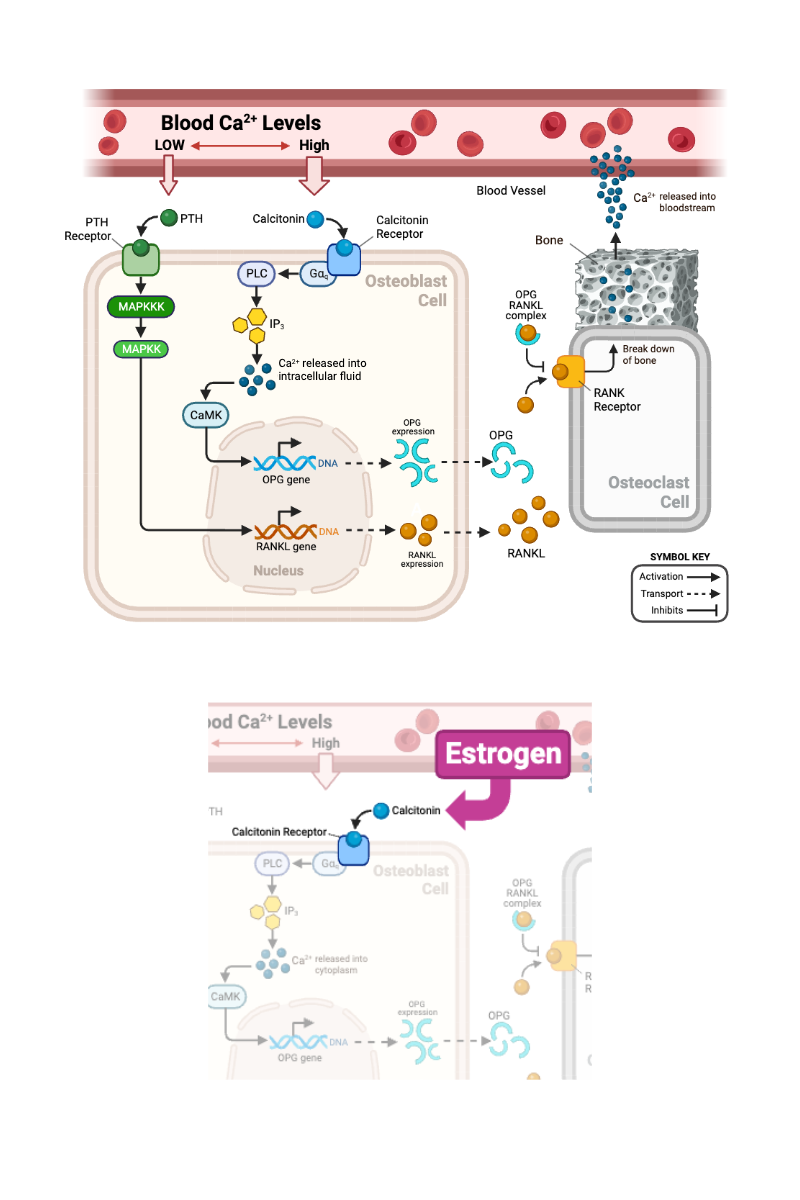
Complete the following sentence. As the concentration of estrogen decreases during menopause, the activity of IP3 in an osteoblast should ______ .
a. increase
b. decrease
c. remain the same
b. decrease
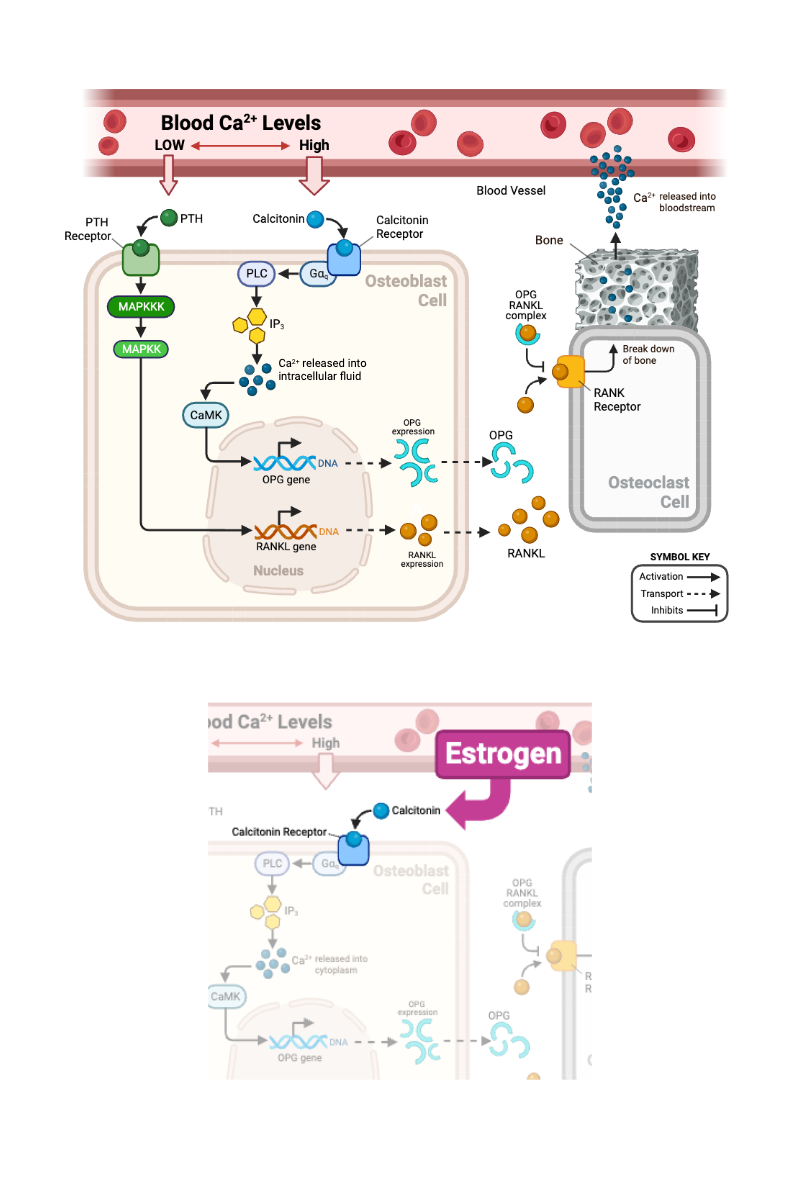
Complete the following sentence. As the concentration of estrogen decreases during menopause, the activity of MAPKKK in an osteoblast should ______ .
a. increase
b. decrease
c. remain the same
c. remain the same
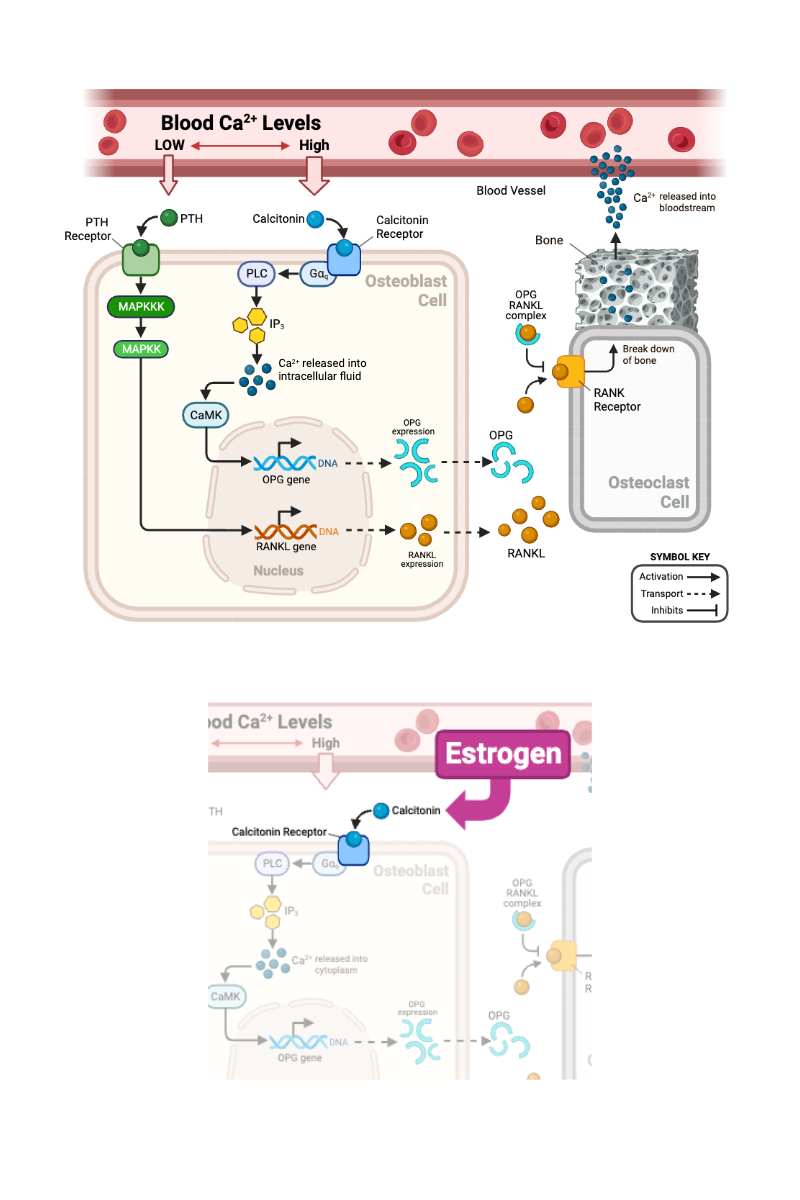
Complete the following sentence. As the concentration of estrogen decreases during menopause, the activity of CaMK in an osteoblast should ______ .
a. increase
b. decrease
c. remain the same
b. decrease
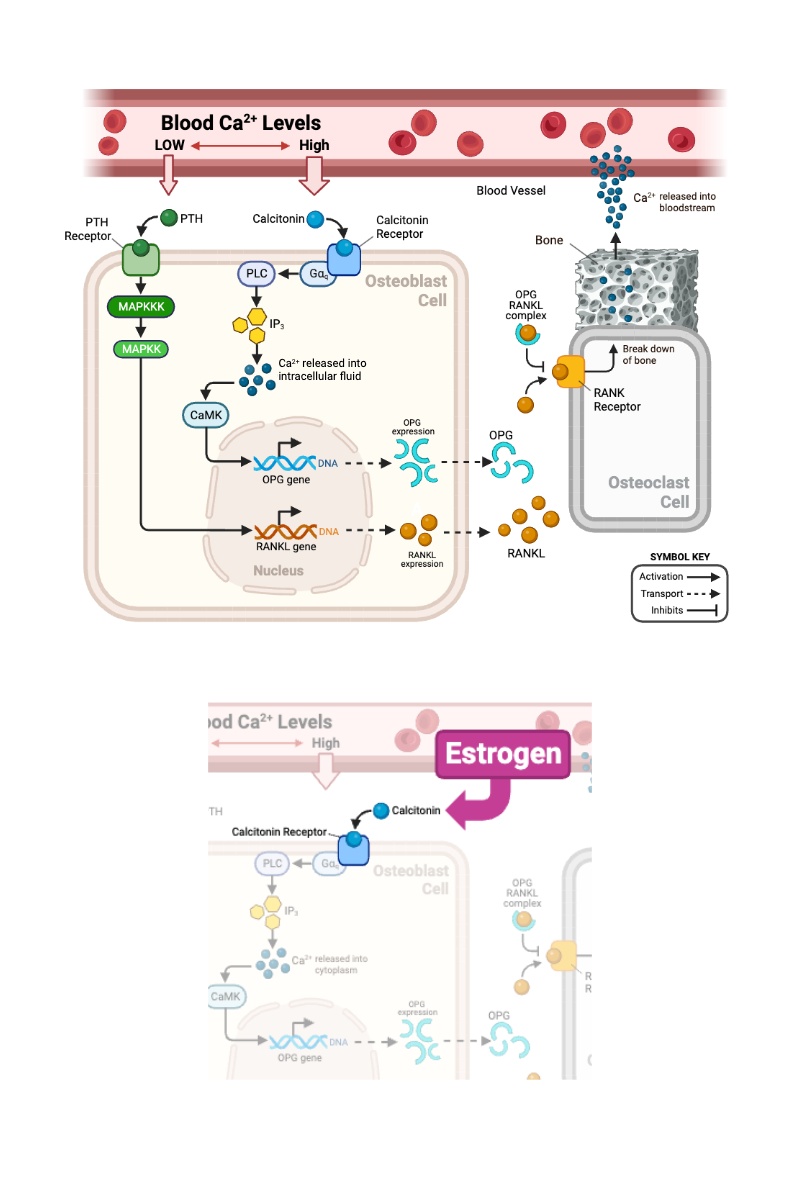
Complete the following sentence. As the concentration of estrogen decreases during pregnancy, the activity of RANK receptors in the membrane of an osteoclast should ______ .
a. increase
b. decrease
c. remain the same
a. increase
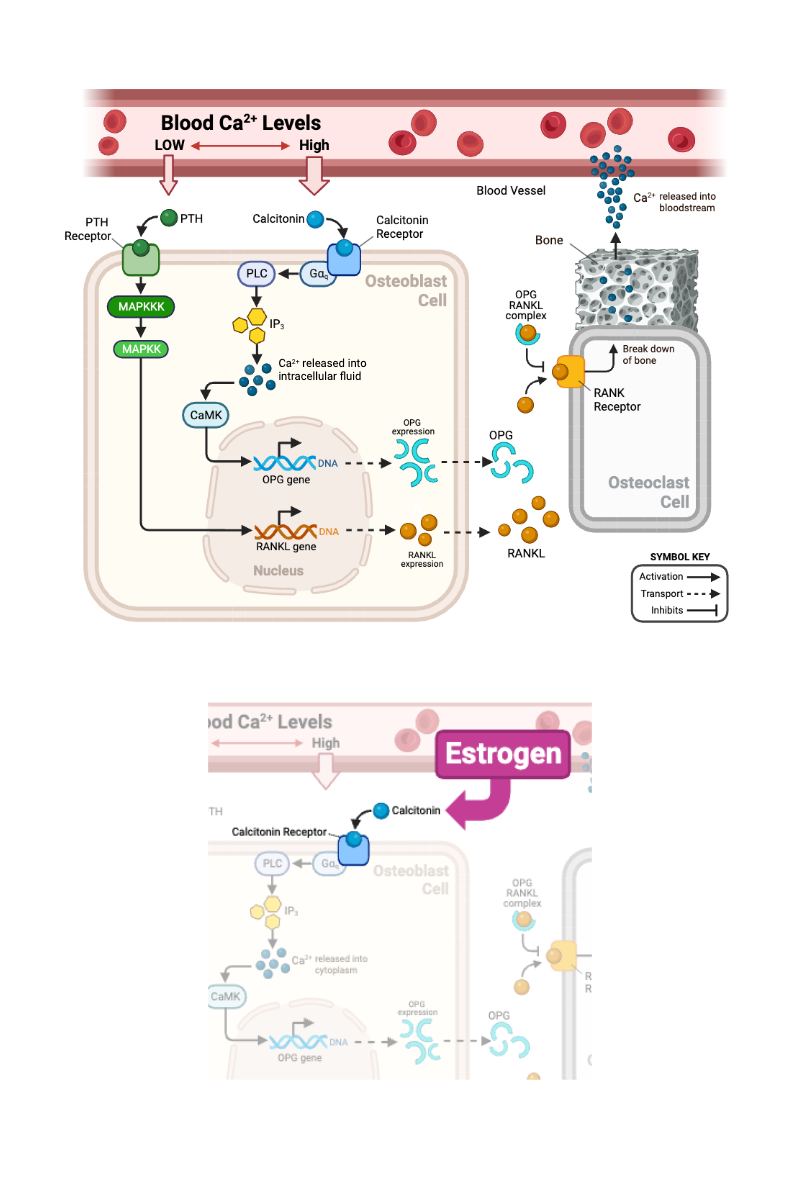
Complete the following sentence. As the concentration of estrogen decreases during menopause, a bone would release Ca2+ at _______.
a. a faster rate
b. a slower rate
c. the same rate
a. a faster rate
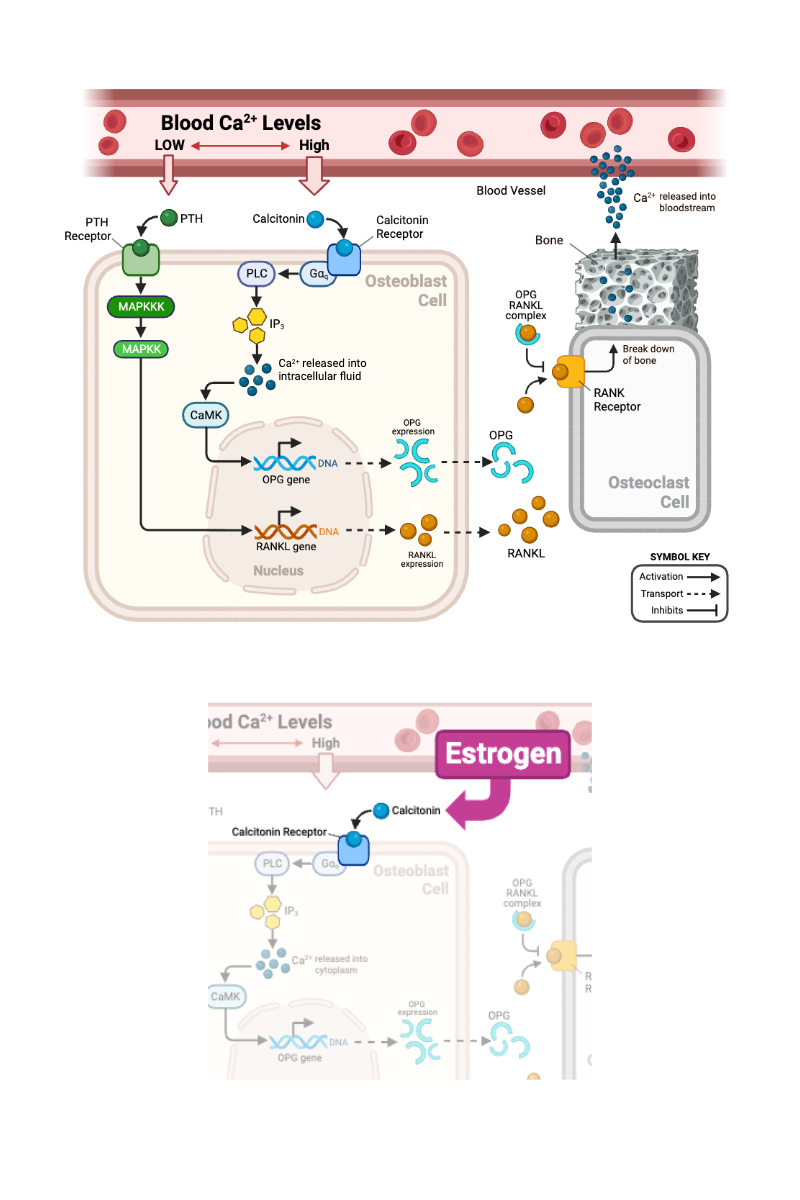
Complete the following sentence. As the concentration of estrogen increases through medication, the concentration of OPG in an osteoblast should ______ .
a. increase
b. decrease
c. remain the same
a. increase
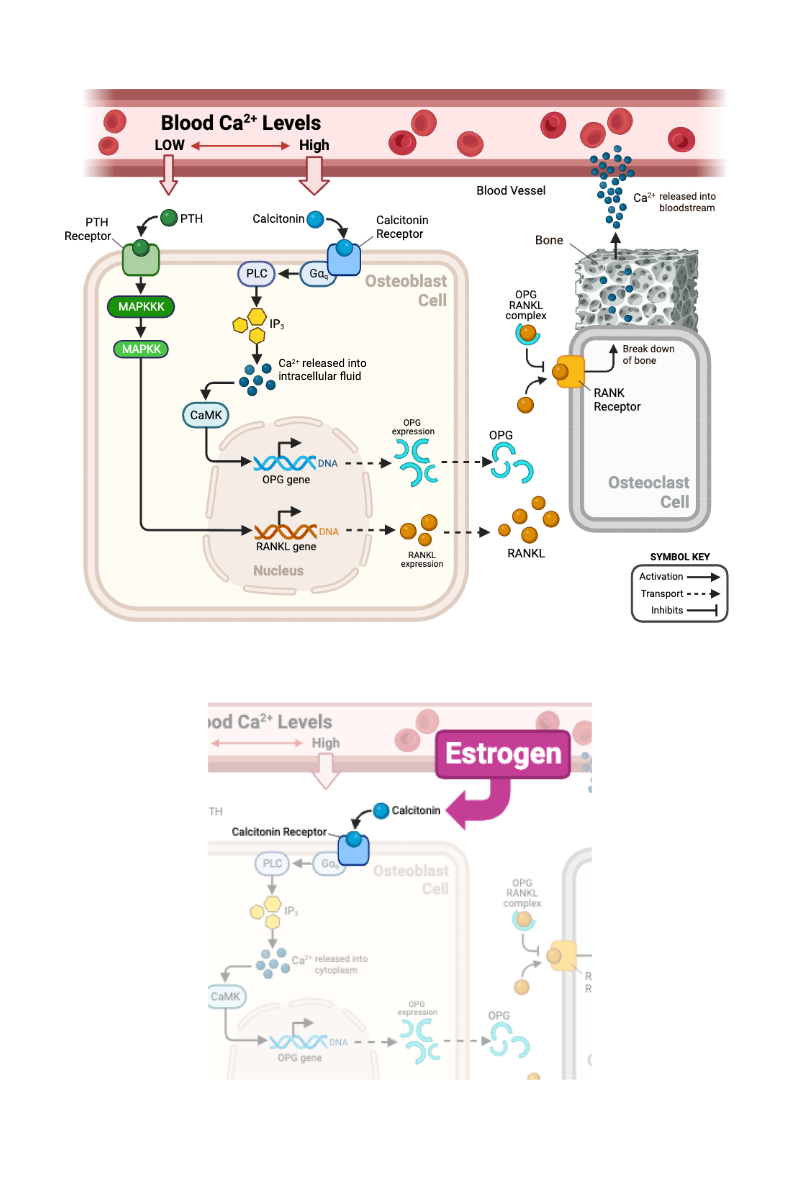
Complete the following sentence. As the concentration of estrogen increases through medication, the concentration of RANKL in an osteoblast should ______ .
a. increase
b. decrease
c. remain the same
c. remain the same
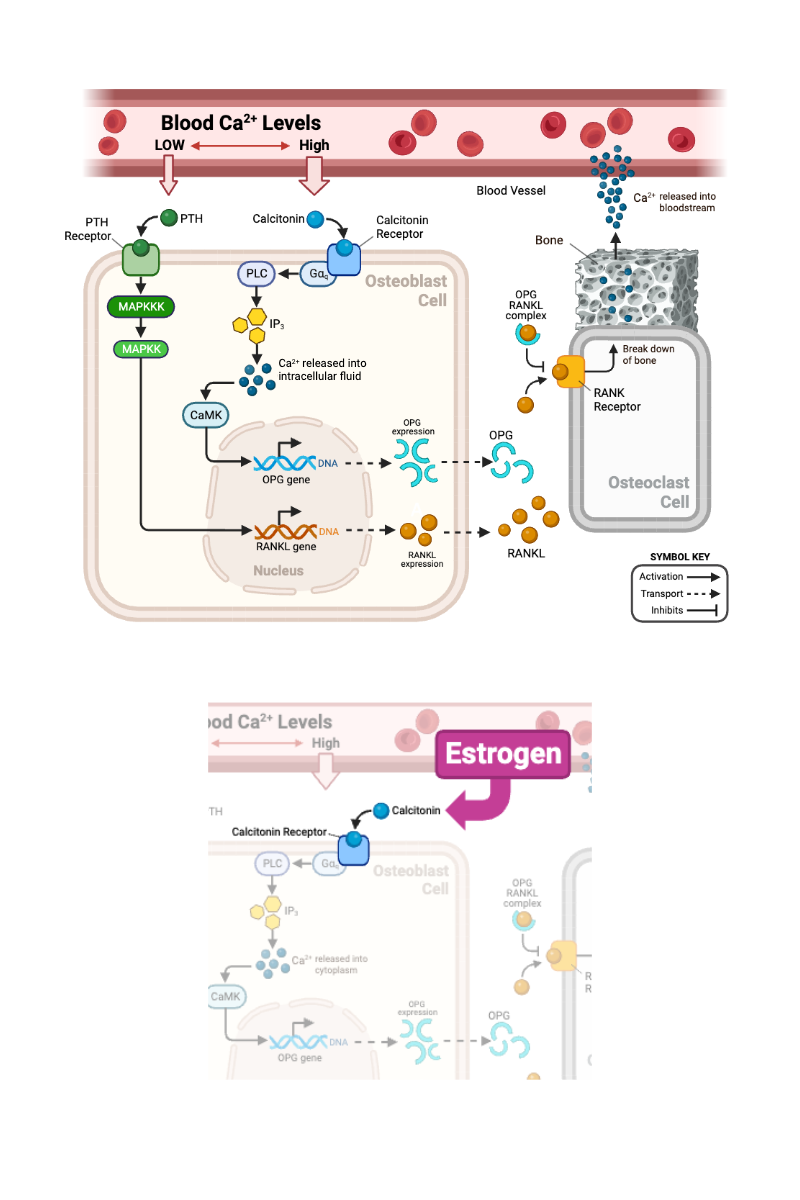
Complete the following sentence. As the concentration of estrogen increases through medication, the activity of RANK receptors in the membrane of an osteoclast should ______ .
a. increase
b. decrease
c. remain the same
b. decrease
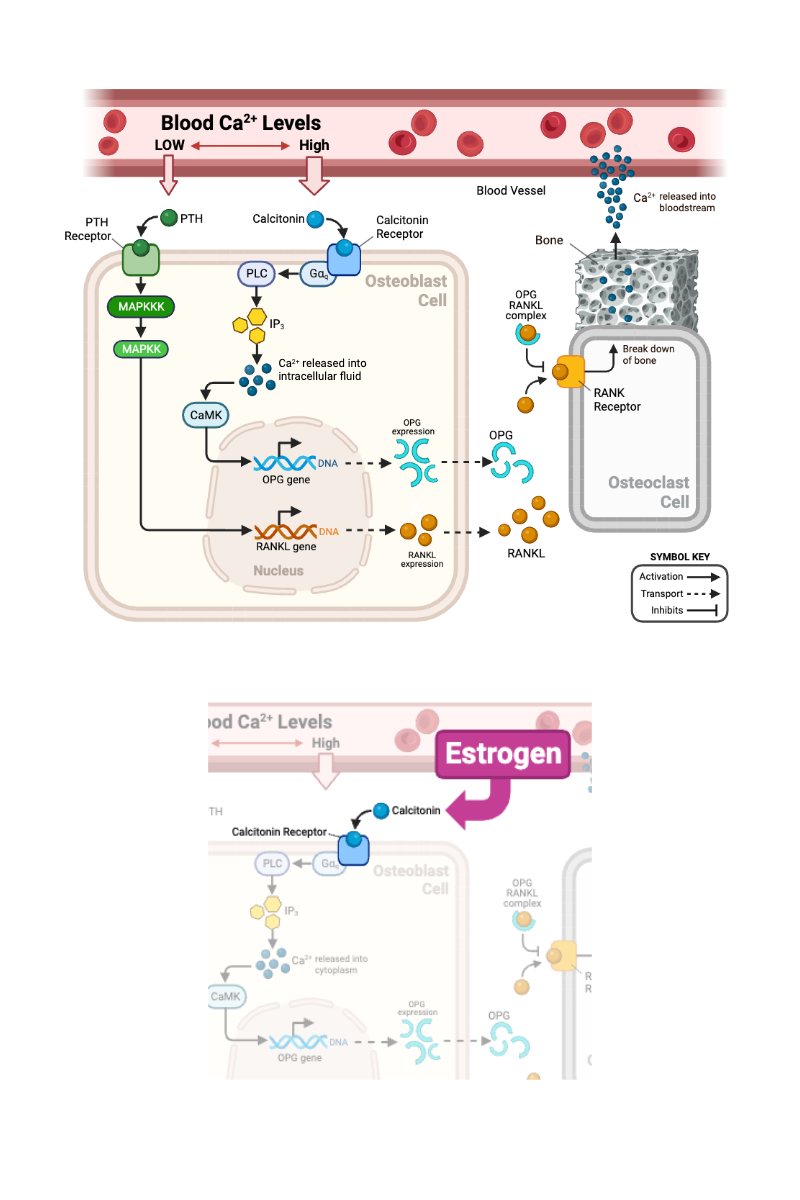
Complete the following sentence. As the concentration of estrogen increases through medication, a bone would release Ca2+ at _______.
a. a faster rate
b. a slower rate
c. the same rate
b. a slower rate